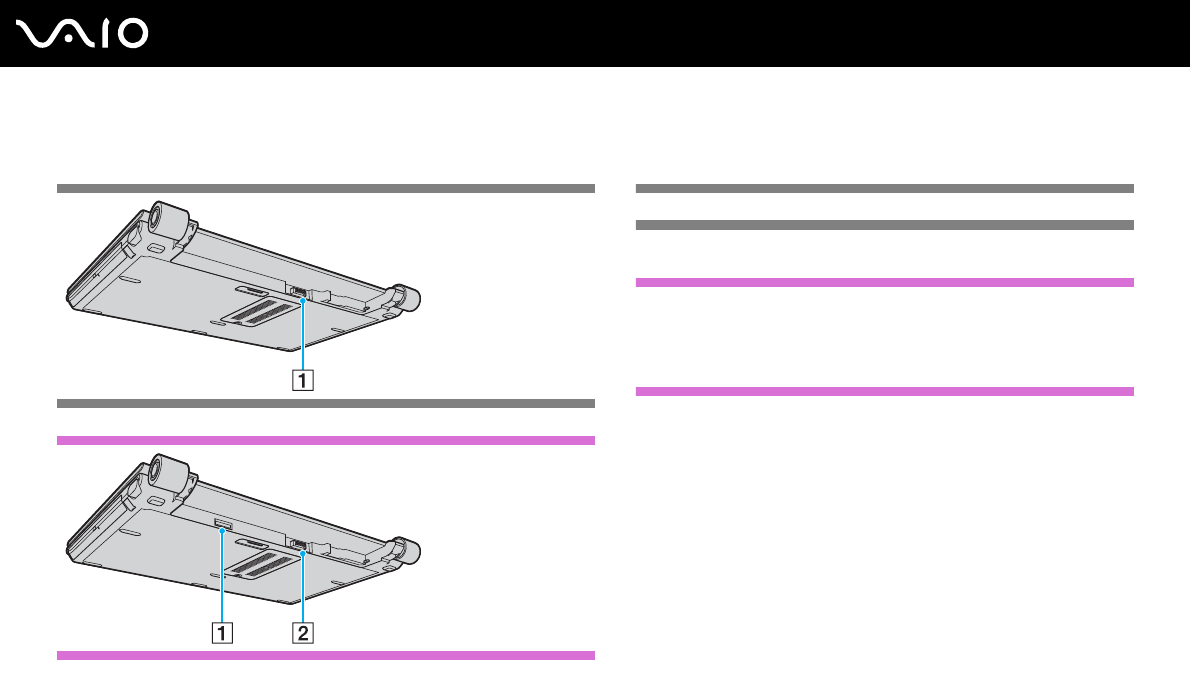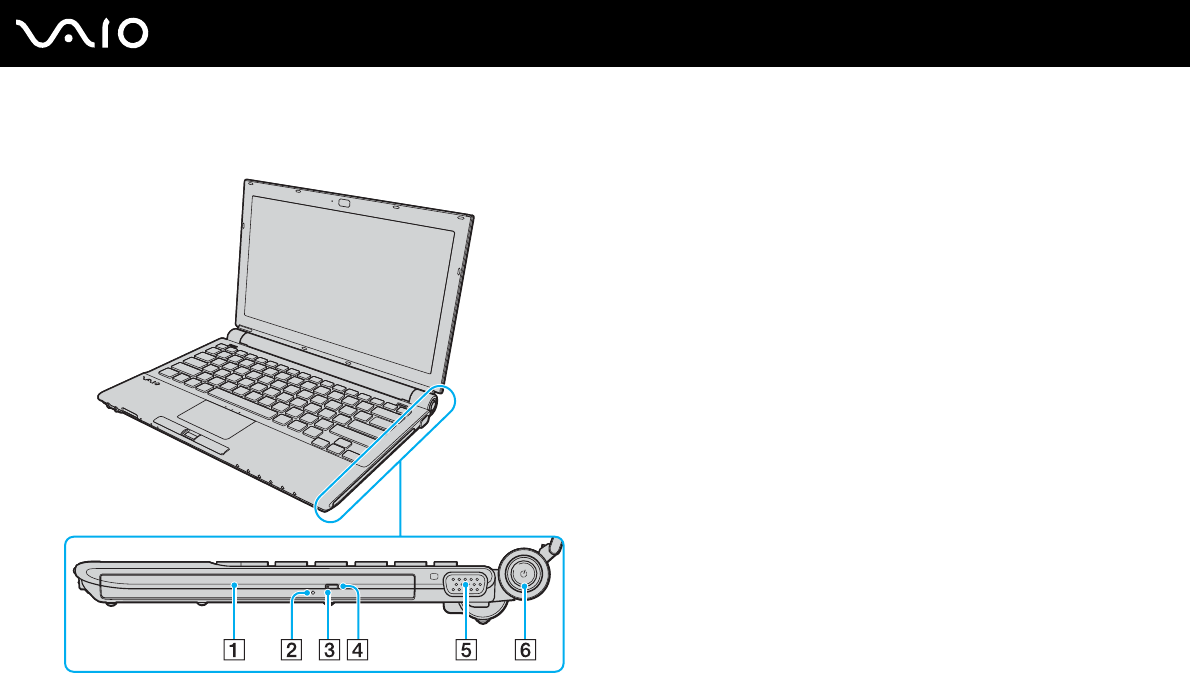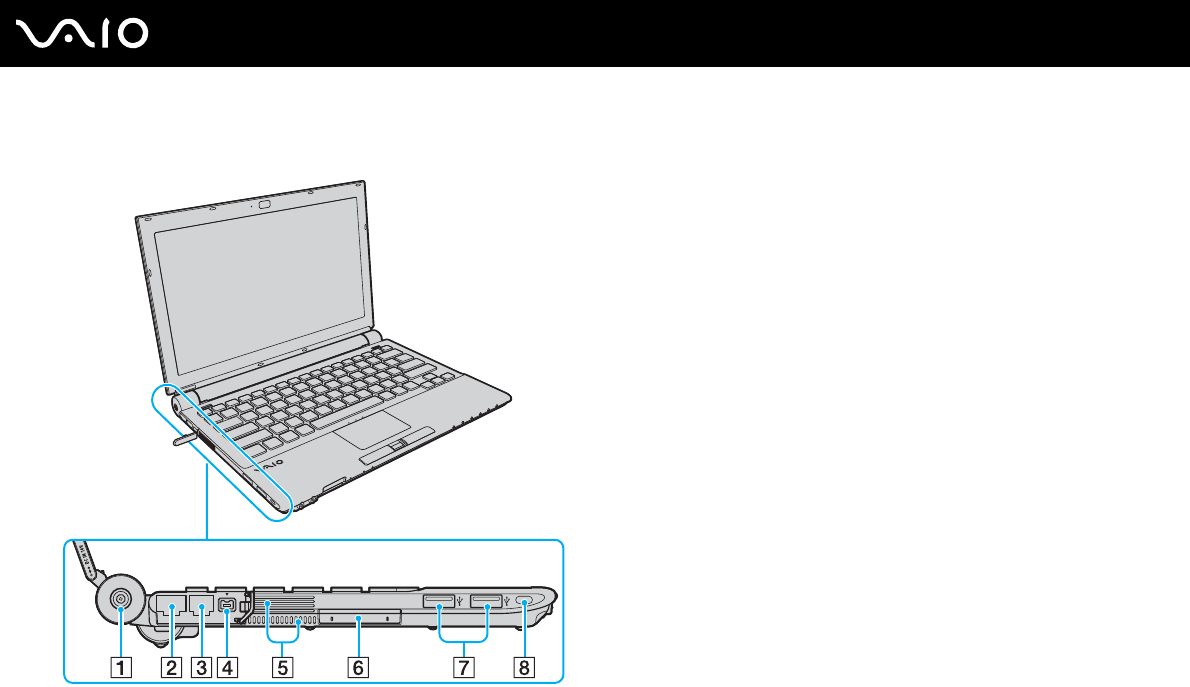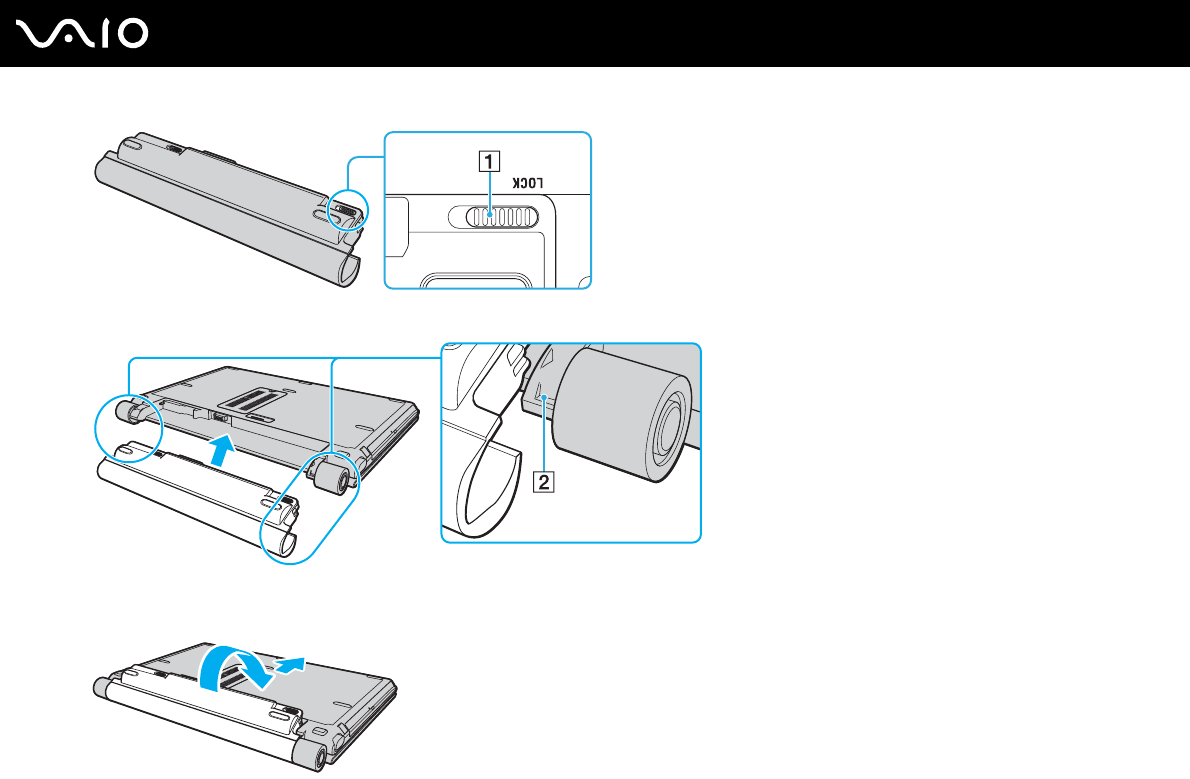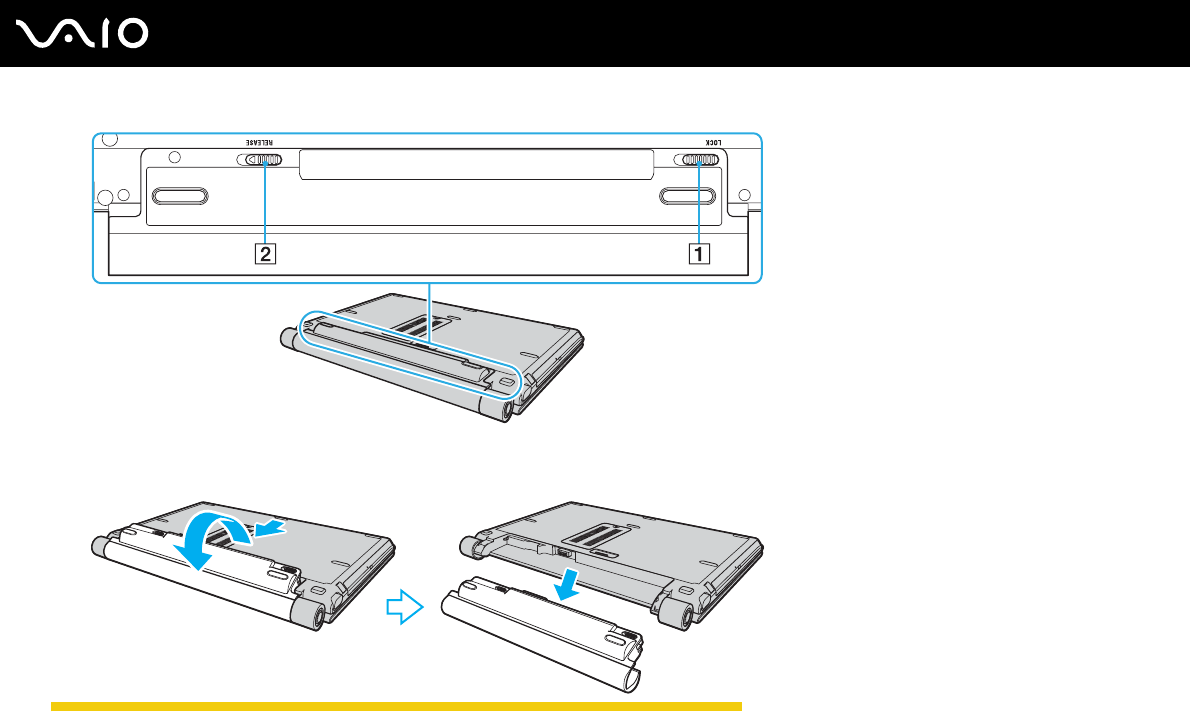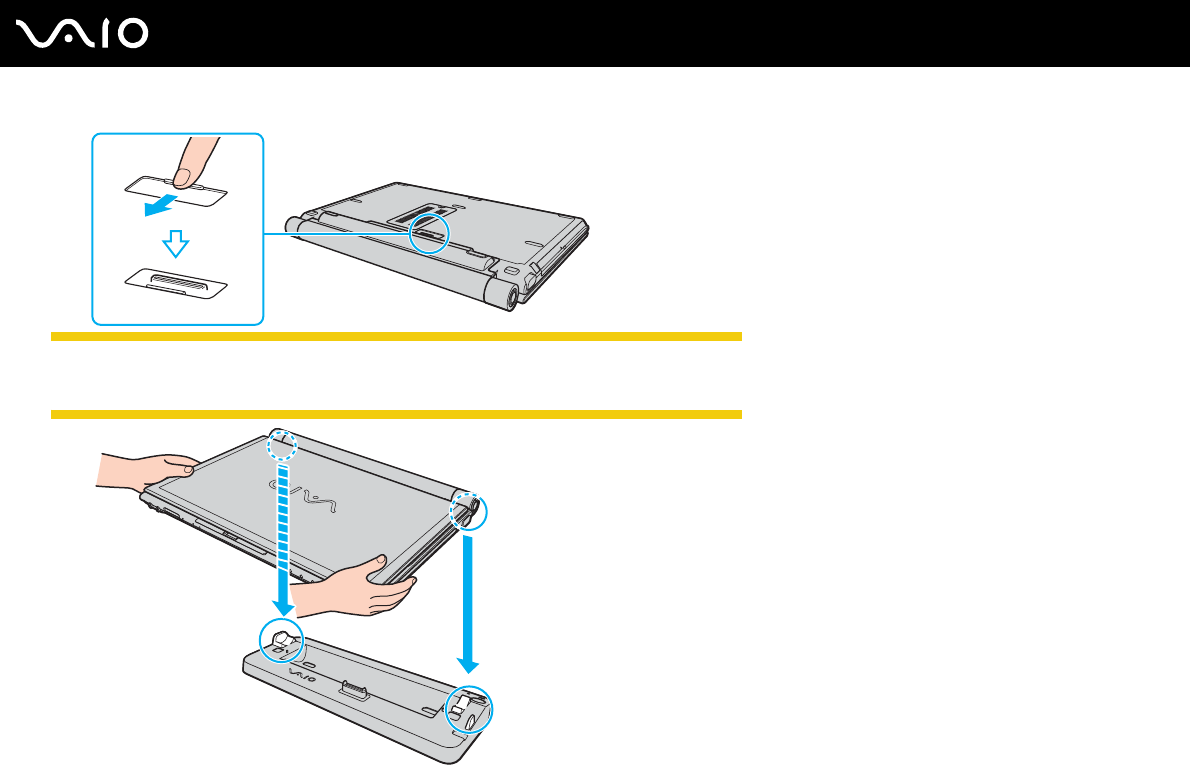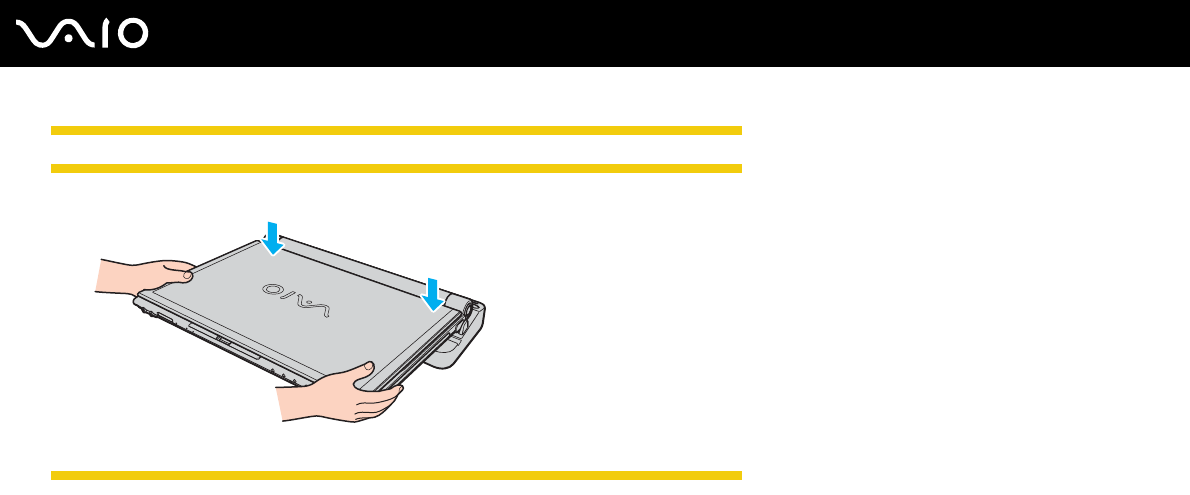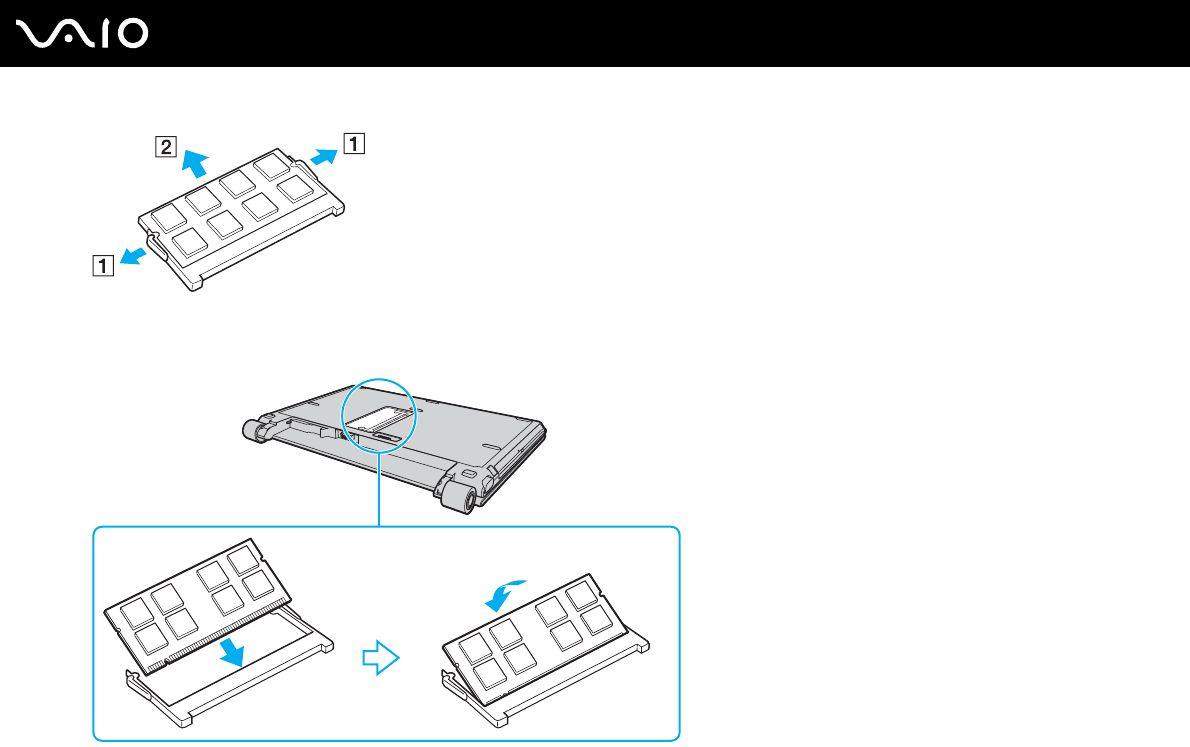Contents
- 1. Safety and Legal Statements
- 2. User Manual
User Manual

3
nN
Contents
Before Use .........................................................................................................................................................................7
Notice...........................................................................................................................................................................7
Documentation.............................................................................................................................................................8
Ergonomic Considerations.........................................................................................................................................15
Getting Started.................................................................................................................................................................17
Locating Controls and Ports.......................................................................................................................................17
About the Indicator Lights ..........................................................................................................................................23
Connecting a Power Source ......................................................................................................................................27
Using the Battery Pack ..............................................................................................................................................28
Shutting Down Your Computer Safely .......................................................................................................................35
Using Your VAIO Computer .............................................................................................................................................36
Using the Keyboard ...................................................................................................................................................37
Using the Touch Pad .................................................................................................................................................42
Using Special-function Buttons ..................................................................................................................................45
Using the Built-in MOTION EYE Camera...................................................................................................................48
Using the Optical Disc Drive ......................................................................................................................................50
Using the ExpressCard Module .................................................................................................................................59
Using the Memory Stick Media ..................................................................................................................................64
Using Other Memory Cards .......................................................................................................................................68
Using the Internet.......................................................................................................................................................72
Using Wireless LAN (WLAN) .....................................................................................................................................73

4
nN
Using the Bluetooth Functionality ..............................................................................................................................83
Using Peripheral Devices.................................................................................................................................................91
Connecting a Docking Station....................................................................................................................................91
Connecting External Speakers ..................................................................................................................................99
Connecting an External Display...............................................................................................................................100
Selecting Display Modes..........................................................................................................................................105
Using the Multiple Monitors Function.......................................................................................................................107
Connecting an External Microphone........................................................................................................................109
Connecting a Universal Serial Bus (USB) Device....................................................................................................110
Connecting a Printer ................................................................................................................................................112
Connecting an i.LINK Device ...................................................................................................................................113
Connecting to a Network (LAN) ...............................................................................................................................115
Customizing Your VAIO Computer ................................................................................................................................118
Setting the Password ...............................................................................................................................................119
Using Fingerprint Authentication..............................................................................................................................145
Using Trusted Platform Module (TPM).....................................................................................................................156
Setting Up Your Computer with VAIO Control Center..............................................................................................166
Setting Up Your Computer with VAIO Central .........................................................................................................167
Using the VAIO Status Monitor ................................................................................................................................167
Using the Power Saving Modes...............................................................................................................................168
Managing Power with VAIO Power Management....................................................................................................173
Changing the Performance Setting..........................................................................................................................176
Protecting Data from Unauthorized Use ..................................................................................................................177
Configuring Your Modem .........................................................................................................................................178

5
nN
Protecting the Hard Disk ..........................................................................................................................................181
Upgrading Your VAIO Computer....................................................................................................................................184
Replacing Memory ...................................................................................................................................................185
Precautions ....................................................................................................................................................................191
On Handling the LCD Screen ..................................................................................................................................191
On Using the Power Source ....................................................................................................................................192
On Handling Your Computer....................................................................................................................................193
On Using the Built-in MOTION EYE Camera...........................................................................................................196
On Handling Floppy Disks .......................................................................................................................................196
On Handling Discs ...................................................................................................................................................197
On Using the Battery Pack.......................................................................................................................................198
On Using Headphones.............................................................................................................................................200
On Handling Memory Stick Media............................................................................................................................200
On Handling the Hard Disk ......................................................................................................................................201
On Updating Your Computer ...................................................................................................................................203
Troubleshooting .............................................................................................................................................................204
Computer .................................................................................................................................................................205
System Security .......................................................................................................................................................212
Battery......................................................................................................................................................................213
Built-in MOTION EYE Camera.................................................................................................................................214
Internet.....................................................................................................................................................................217
Networking ...............................................................................................................................................................218
Bluetooth Technology ..............................................................................................................................................221
Optical Discs ............................................................................................................................................................225

6
nN
Display .....................................................................................................................................................................231
Printing.....................................................................................................................................................................234
Microphone ..............................................................................................................................................................235
Mouse ......................................................................................................................................................................236
Speakers..................................................................................................................................................................236
Touch Pad................................................................................................................................................................238
Keyboard..................................................................................................................................................................239
Floppy Disks ............................................................................................................................................................239
Audio/Video..............................................................................................................................................................240
Memory Stick Media ................................................................................................................................................242
Peripherals...............................................................................................................................................................244
Docking Station........................................................................................................................................................245
Support Options .............................................................................................................................................................246
Sony Support Information ........................................................................................................................................246
Program Support Information...................................................................................................................................251
e-Support .................................................................................................................................................................263
Trademarks..............................................................................................................................................................264

7
nN
Before Use
Before Use
Congratulations on your purchase of this Sony VAIO® computer, and welcome to the on-screen User Guide. Sony has
combined leading-edge technology in audio, video, computing, and communications to provide state-of-the-art personal
computing.
!
External views illustrated in this manual may look slightly different from those of your computer.
Except US model_BGN
Notice
© 2007 Sony Corporation. All rights reserved.
This manual and the software described herein, in whole or in part, may not be reproduced, translated, or reduced to any
machine-readable form without prior written approval.
Sony Corporation provides no warranty with regard to this manual, the software, or other information contained herein and
hereby expressly disclaims any implied warranties or merchantability or fitness for any particular purpose with regard to this
manual, the software, or such other information. In no event shall Sony Corporation be liable for any incidental, consequential,
or special damages, whether based on tort, contract, or otherwise, arising out of or in connection with this manual, the
software, or other information contained herein or the use thereof.
In the manual, the ™ or ® marks are not specified.
Sony Corporation reserves the right to make any modification to this manual or the information contained herein at any time
without notice. The software described herein is governed by the terms of a separate user license agreement.
Except Euro_BGN
Please note that the illustrations in this manual may not necessarily apply to your model. Please see the printed
Specifications sheet for the specific configuration of your VAIO computer.

8
nN
Before Use
Except Euro_END
Except US model_END
Documentation
Your documentation includes printed information and user guides to read on your VAIO computer.
Euro model_BGN
Guides are provided in PDF format, which you can easily browse through and print out.
The My Club VAIO portal is a perfect starting point to use your computer — a comprehensive collection of everything you
need to get the most from your computer.
The user guides are collected under Documentation, which can be shown by clicking the VAIO User Guides icon on the
desktop or following these steps:
1Click Start , All Programs, and My Club VAIO.
2Click Documentation.
3Select the guide you want to read.
✍
You can manually browse to the user guides by going to Computer > VAIO (C:) (your C drive) > Documentation > Documentation and opening the
folder for your language.
You may have a separate disc for the documentation of bundled accessories.
Euro model_END
Printed Documentation
US model_BGN
❑Welcome mat — Contains an overview of connections, set-up information, etc.

9
nN
Before Use
❑Safety Information — Contains safety guidelines and owner information.
IRX-3960_BGN
❑Instant Mode — Provides a guide to use Instant Mode.
IRX-3960_END
US model_END
Euro model_BGN
❑A Setting Up Poster — Describes the process from unpacking to starting up your VAIO.
❑Troubleshooting Guide — Contains solutions to common problems.
❑Recovery Guide — Contains an explanation of how to make a backup copy of your data and recover your computer
system, and solutions to computer malfunctions.
IRX-3960_BGN
❑Instant Mode — Provides a guide to use Instant Mode.
IRX-3960_END
❑Booklets containing the following information: Sony GUARANTEE conditions, Safety / Regulations, Modem
Regulations, Wireless LAN Regulations, Bluetooth Regulations, End User Software License Agreement, and
Sony Support services.
Euro model_END
GVD model_BGN
❑Specifications sheet — Contains a table of specifications, a list of bundled software, and an overview of all controls and
ports.
❑Troubleshooting and Recovery Guide — Contains solutions to common problems and computer malfunctions, an
explanation of how to make a backup copy of your data and recover your computer system, and sources of support
information.

10
nN
Before Use
❑Safety Regulations
IRX-3960_BGN
❑Instant Mode — Provides a guide to use Instant Mode.
IRX-3960_END
GVD model_END
China model_BGN
❑Specifications sheet (1) — Contains a table of specifications, a list of bundled software, and an overview of all controls
and ports.
❑Troubleshooting and Recovery Guide (1) — Contains solutions to common problems and computer malfunctions, an
explanation of how to make a backup copy of your data and recover your computer system, and sources of support
information.
❑Safety Regulations (1)
IRX-3960_BGN
❑Instant Mode* — Provides a guide to use Instant Mode.
* On models with the built-in optical disc drive only.
IRX-3960_END
❑Insert CS statement a-1 here!
China model_END
Non-printed Documentation
US model_BGN
❑User Guide (this manual) — Contains features of your computer. It also includes information about the software programs
included with your computer, as well as information on solving common problems.

11
nN
Before Use
❑Specifications — The online Specifications describe the hardware and software configuration of your VAIO computer.
To view the online Specifications:
1Connect to the Internet.
2Go to the Sony online support Web site at:
http://esupport.sony.com/EN/VAIO/ for customers in USA,
http://www.sony.ca/support for customers in Canada,
http://esupport.sony.com/ES/VAIO/ for customers in Spanish speaking Latin American countries or areas, or
http://esupport.sony.com/ES/VAIO/BR/ for customers in Brazil.
❑VAIO Recovery Center User Guide — Provides information about restoring individual software programs, software
drivers, and drive partition(s) or your entire hard disk drive to the original factory installed settings.
To access this on-screen guide:
1Click Start and Help and Support.
2Click Manuals & Specifications.
3Click VAIO Recovery Center User Guide.
IRX-3960_BGN
❑SmartWi™ Connection Utility Help (Selected models only) — Provides information about setting up Bluetooth, wireless
LAN, and wireless WAN functionalities.
To access this on-screen guide:
1Click Start, All Programs, and SmartWi Connection Utility.
2Click SmartWi Connection Utility Help.
IRX-3960_END

12
nN
Before Use
Help and Support
Help and Support is easy to access and provides a single location for information and technical assistance for your VAIO
computer. Choose from the following categories to find the answers you need.
To access Help and Support, click Start and Help and Support.
❑Manuals & Specifications
Here you will find the on-screen User Guide, warranty information, other VAIO documents, and system and software
information for your computer.
❑VAIO Support
Access interactive help in the form of VAIO tutorials, an escalation page containing support and contact information, and
various links to VAIO online support Web sites.
❑Backup & Recovery
Find information on how to back up and restore your operating system, system software, and your personal data.
❑Wireless & Network
Learn about wireless connections including Bluetooth Wireless technology and Wireless LAN. Run utilities that include
VAIO Media Setup and Windows Network and Sharing, and access to wireless tutorials.
❑Security
Keep your data safe and your computer running efficiently with updates and maintenance programs from Microsoft and
Sony.
❑VAIO Sites
Contains links to other Internet sites you might find interesting and useful.
US model_END
Euro model_BGN
❑User Guide (this manual) — Contains features of your computer. It also includes information about the software programs
included with your computer, as well as information on solving common problems.

13
nN
Before Use
❑Specifications — The online Specifications describe the hardware and software configuration of your VAIO computer.
To view the online Specifications:
1Connect to the Internet.
2Go to the Sony online support Web site at http://support.vaio.sony.eu.
My Club VAIO
In My Club VAIO you can find:
Documentation, which gives you:
❑Access to the User Guide. This manual explains the features of your computer in detail, how to use these features
confidently and safely, connect peripheral devices and more.
❑Access to Help & Training. This is the portal of VAIO Help and Support Center.
❑Important information about your computer, in the form of notices and announcements.
In My Club VAIO you can also find:
❑Accessories
Want to expand the capabilities of your computer? Click this icon and have a look at your compatible accessories.
❑Software
Feeling creative? Click this icon for an overview of your software and check out our upgrade options.
❑Wallpapers
Click this icon and check out our most popular Sony and Club VAIO wallpapers.
❑Links
Click this icon and check out our most popular Sony and Club VAIO Web sites.

14
nN
Before Use
Windows Help and Support
Windows Help and Support is a comprehensive resource for practical advice, tutorials, and demonstrations to help you
learn to use your computer.
Use the Search feature, Index, or table of contents to view all Windows Help resources, including those that are on the
Internet.
To access Windows Help and Support, click Start and Help and Support. Or go to Windows Help and Support by
pressing and holding the Microsoft Windows key and pressing the F1 key.
Euro model_END
Except Euro_BGN
Except US model_BGN
❑Hardware Guide (this manual) — Contains features of your computer. It also includes information on solving common
problems.
❑Software Guide — Provides specific information on certain preinstalled software on your computer.
❑Important Notice — Provides information on specific items concerning your computer.
Except US model_END
Except Euro_END
Euro model_BGN
Further Sources
❑Consult the help files on the software you are using for detailed information on features and troubleshooting.
❑Go to http://www.club-vaio.com to find online tutorials about your favorite VAIO software.
Euro model_END
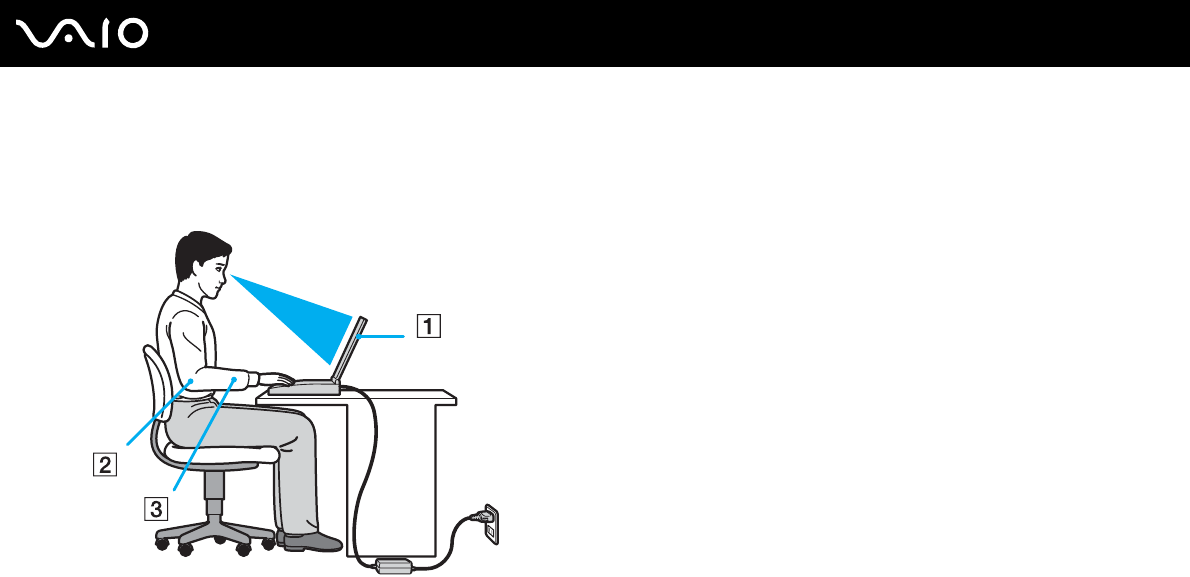
15
nN
Before Use
Ergonomic Considerations
You will be using your computer as a portable device in a variety of environments. Whenever possible, you should attempt
to take account of the following ergonomic considerations for both stationary and portable environments:
❑Position of your computer – Place the computer directly in front of you (1). Keep your forearms horizontal (2), with your
wrists in a neutral, comfortable position (3) while using the keyboard, touch pad, or external mouse. Let your upper arms
hang naturally at your sides. Have breaks during sessions with your computer. Excessive use of the computer may strain
muscles or tendons.
❑Furniture and posture – Sit in a chair with good back support. Adjust the level of the chair so your feet are flat on the
floor. A footrest may make you more comfortable. Sit in a relaxed, upright posture and avoid slouching forward or leaning
far backwards.

16
nN
Before Use
❑Viewing angle of the computer's display – Use the display's tilting feature to find the best position. You can reduce eye
strain and muscle fatigue by adjusting the tilt of the display to the proper position. Adjust the brightness setting of the
display as well.
❑Lighting – Choose a location where windows and lights do not create glare and reflection on the display. Use indirect
lighting to avoid bright spots on the display. Proper lighting adds to your comfort and work effectiveness.
❑Positioning an external display – When using an external display, set the display at a comfortable viewing distance.
Make sure the display screen is at eye level or slightly lower when you are sitting in front of the monitor.

17
nN
Getting Started
Getting Started
This section describes how to get started with using your VAIO computer.
US model_BGN
!
Before starting your computer for the first time, do not connect any other hardware that did not originally come with your computer. Be sure to start
up your computer with only the supplied accessories connected and set up your system. Upon completion, connect one device (for example, a printer,
an external hard disk drive, a scanner, and so on) at a time, following the manufacturers' instructions.
US model_END
Except GVD model_BGN
Except China_BGN
❑Locating Controls and Ports (page 17)
Except China_END
Except GVD model_END
❑About the Indicator Lights (page 23)
❑Connecting a Power Source (page 27)
❑Using the Battery Pack (page 28)
❑Shutting Down Your Computer Safely (page 35)
Except China_BGN
Except GVD model_BGN
Locating Controls and Ports
Take a moment to identify the controls and ports shown on the following pages.
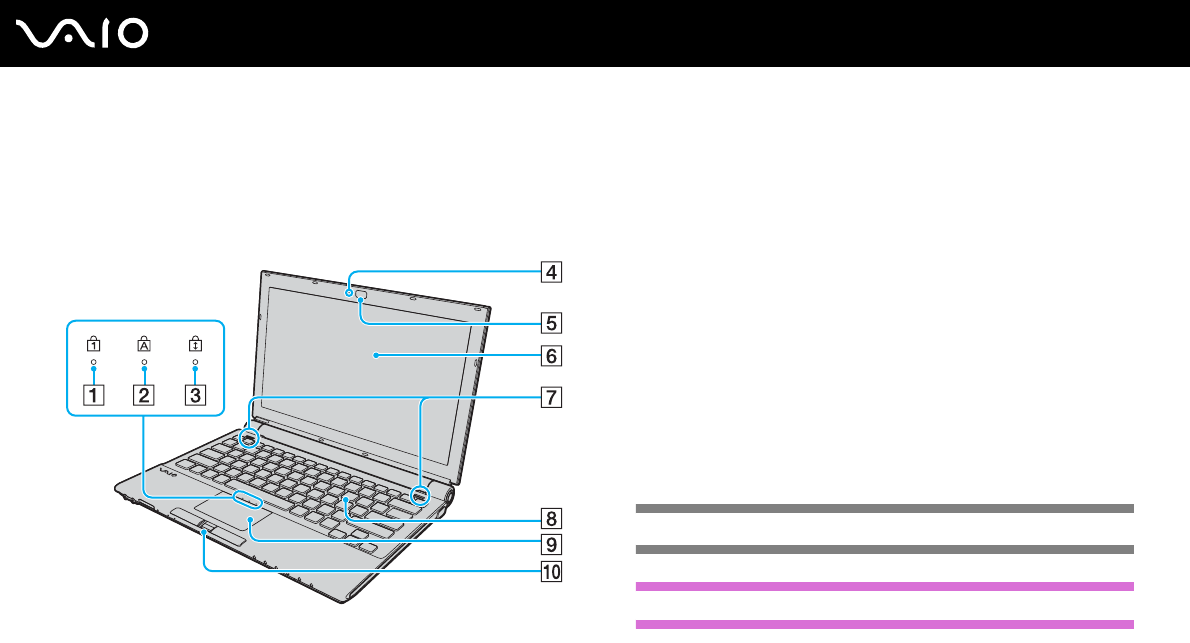
18
nN
Getting Started
!
The appearance of your computer may be different from those illustrated in this manual due to variations in specifications. It may also vary depending
on the country or area of your residency.
Front
ANum lock indicator (page 23)
BCaps lock indicator (page 23)
CScroll lock indicator (page 23)
DBuilt-in MOTION EYE camera indicator* (page 23)
EBuilt-in MOTION EYE camera* (page 48)
FLCD screen (page 191)
GBuilt-in speakers (stereo)
HKeyboard (page 37)
ITouch pad (page 42)
Euro model_BGN
JFingerprint sensor* (page 145)
Euro model_END
US model_BGN
KFingerprint sensor (page 145)
US model_END
* On selected models only.
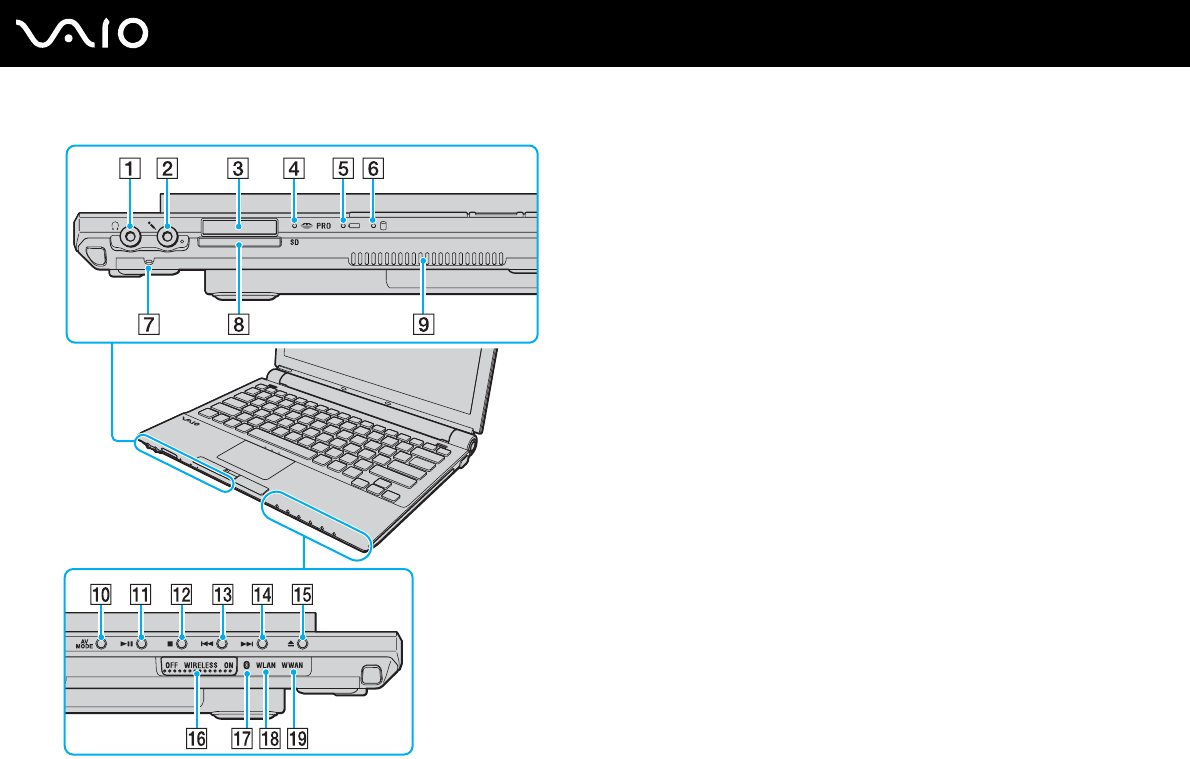
19
nN
Getting Started
AHeadphones jack (page 99)
BMicrophone jack (page 109)
CMemory Stick PRO/Duo media slot*1 (page 64)
DMedia Access indicator (page 23)
EBattery indicator (page 23)
FHard disk drive indicator (page 23)
GBuilt-in microphone (monaural)
HSD memory card slot (page 68)
IAir vent
JAV MODE button (page 45)
KPlay/Pause button (page 45)
LStop button (page 45)
MPrevious track button (page 45)
NNext track button (page 45)
ODisc drive eject button (page 45)
PWIRELESS switch (page 73)
QBluetooth indicator (page 23)
RWLAN (Wireless LAN) indicator (page 23)
SWWAN (Wireless WAN) indicator*2 (page 23)
*1 Your computer supports Memory Stick PRO media and Memory Stick Duo
media with high speed and high capacity capabilities.
*2 On selected models only.
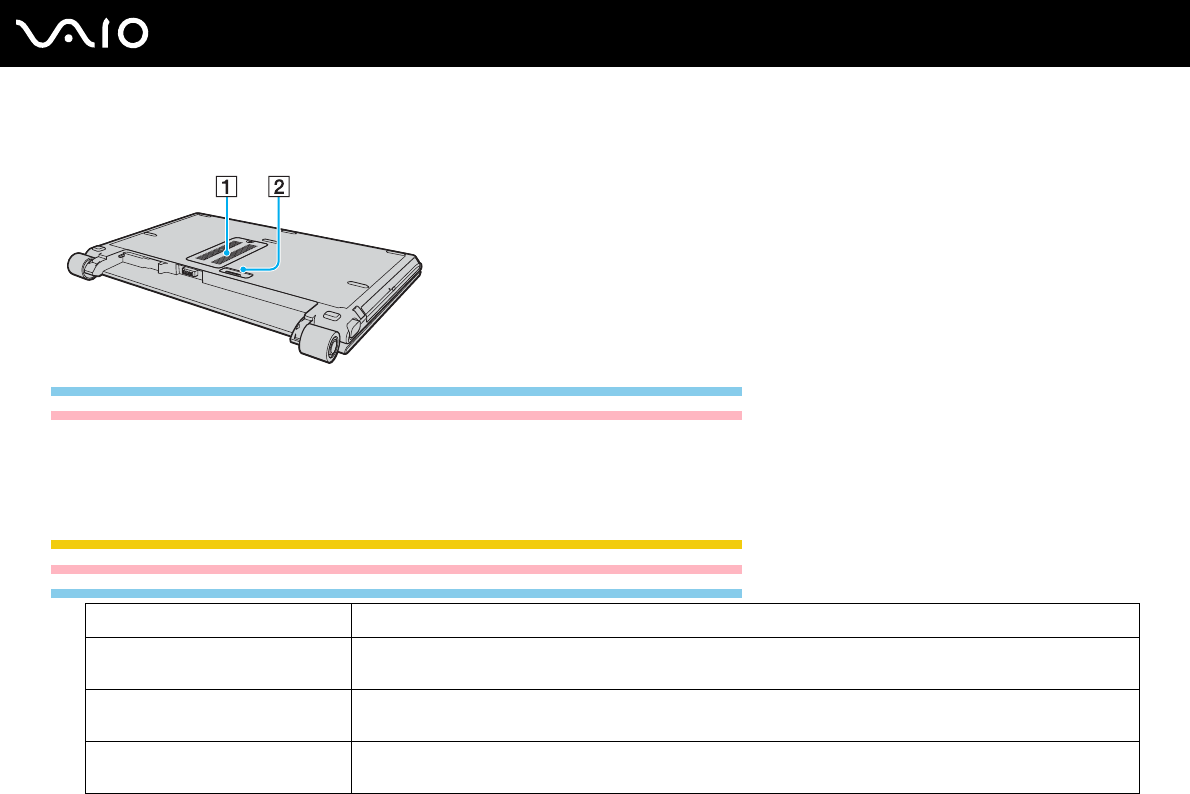
23
nN
Getting Started
Bottom
Except GVD model_END
Except China_END
About the Indicator Lights
Your computer is equipped with the following indicator lights.
IRX-3960_BGN
Except China_BGN
Except GVD model_BGN
AAir vents
BDocking station connector (page 92)
Indicator Functions
Power 1Illuminates when the power of the computer is on, blinks when the computer is in Sleep mode, and turns off
when the computer is in Hibernate mode or off.
Battery eIlluminates when the computer is using battery power, blinks when the battery pack is running out of power, and
double-blinks when the battery pack is charging.
Media Access Illuminates when data is read from or written to a memory card. (Do not enter Sleep mode or turn off the
computer when this indicator is on.) When the indicator is off, the memory card is not being used.

24
nN
Getting Started
Except GVD model_END
Except China_END
GVD model_BGN
Built-in MOTION EYE camera*1 Illuminates while the built-in MOTION EYE camera is in use.
Optical disc drive Illuminates when data is read from or written to the optical disc media. When the indicator is off, the optical disc
media is not being used.
Hard disk drive Illuminates when data is read from or written to the built-in flash memory storage or hard disk drive*2. Do not
enter Sleep mode or turn off the computer when this indicator is on.
Num lock Press the Num Lk key to activate the numeric keypad. Press it a second time to deactivate the numeric keypad.
The numeric keypad is not active when the indicator is off.
Caps lock Press the Caps Lock key to type letters in uppercase. Letters appear in lowercase if you press the Shift key
while the indicator is on. Press the key a second time to turn off the indicator. Normal typing resumes when the
Caps lock indicator is off.
Scroll lock Press the Scr Lk key to change how you scroll the display. Normal scrolling resumes when the Scroll lock
indicator is off. The Scr Lk key functions differently depending on the program you are using and does not work
with all programs.
Bluetooth technology Illuminates when the WIRELESS switch is set to ON and Bluetooth technology is enabled.
Wireless LAN Illuminates when the wireless LAN function is running.
Wireless WAN*2 Illuminates when the wireless WAN function is enabled.
*1 On selected models only.
*2 Your computer is equipped with either the built-in flash memory storage or hard disk drive, depending on the model you purchased. See the online Specifications
to find which storage device your model is equipped with.
Indicator Functions

25
nN
Getting Started
Indicator Functions
Power 1Illuminates when the power of the computer is on, blinks when the computer is in Sleep mode, and turns off
when the computer is in Hibernate mode or off.
Battery eIlluminates when the computer is using battery power, blinks when the battery pack is running out of power, and
double-blinks when the battery pack is charging.
Media Access Illuminates when data is read from or written to a memory card. (Do not enter Sleep mode or turn off the
computer when this indicator is on.) When the indicator is off, the memory card is not being used.
Built-in MOTION EYE camera Illuminates while the built-in MOTION EYE camera is in use.
Optical disc drive Illuminates when data is read from or written to the optical disc media. When the indicator is off, the optical disc
media is not being used.
Hard disk drive Illuminates when data is read from or written to the built-in flash memory storage or hard disk drive*. Do not
enter Sleep mode or turn off the computer when this indicator is on.
Num lock Press the Num Lk key to activate the numeric keypad. Press it a second time to deactivate the numeric keypad.
The numeric keypad is not active when the indicator is off.
Caps lock Press the Caps Lock key to type letters in uppercase. Letters appear in lowercase if you press the Shift key
while the indicator is on. Press the key a second time to turn off the indicator. Normal typing resumes when the
Caps lock indicator is off.
Scroll lock Press the Scr Lk key to change how you scroll the display. Normal scrolling resumes when the Scroll lock
indicator is off. The Scr Lk key functions differently depending on the program you are using and does not work
with all programs.
Bluetooth technology Illuminates when the WIRELESS switch is set to ON and Bluetooth technology is enabled.
Wireless LAN Illuminates when the wireless LAN function is running.
* Your computer is equipped with either the built-in flash memory storage or hard disk drive, depending on the model you purchased. See the printed Specifications
sheet to find which storage device your model is equipped with.

26
nN
Getting Started
GVD model_END
China model_BGN
Indicator Functions
Power 1Illuminates when the power of the computer is on, blinks when the computer is in Sleep mode, and turns off
when the computer is in Hibernate mode or off.
Battery eIlluminates when the computer is using battery power, blinks when the battery pack is running out of power, and
double-blinks when the battery pack is charging.
Media Access Illuminates when data is read from or written to a memory card. (Do not enter Sleep mode or turn off the
computer when this indicator is on.) When the indicator is off, the memory card is not being used.
Built-in MOTION EYE camera Illuminates while the built-in MOTION EYE camera is in use.
Optical disc drive*1 Illuminates when data is read from or written to the optical disc media. When the indicator is off, the optical disc
media is not being used.
Hard disk drive Illuminates when data is read from or written to the built-in flash memory storage or hard disk drive*2. Do not
enter Sleep mode or turn off the computer when this indicator is on.
Num lock Press the Num Lk key to activate the numeric keypad. Press it a second time to deactivate the numeric keypad.
The numeric keypad is not active when the indicator is off.
Caps lock Press the Caps Lock key to type letters in uppercase. Letters appear in lowercase if you press the Shift key
while the indicator is on. Press the key a second time to turn off the indicator. Normal typing resumes when the
Caps lock indicator is off.
Scroll lock Press the Scr Lk key to change how you scroll the display. Normal scrolling resumes when the Scroll lock
indicator is off. The Scr Lk key functions differently depending on the program you are using and does not work
with all programs.
Bluetooth technology Illuminates when the WIRELESS switch is set to ON and Bluetooth technology is enabled.
Wireless LAN Illuminates when the wireless LAN function is running.

27
nN
Getting Started
China model_END
IRX-3960_END
Connecting a Power Source
You can use either an AC adapter or a rechargeable battery pack as a power source for your computer.
Using the AC Adapter
✍
Use your computer only with the supplied AC adapter.
To use the AC adapter
1Plug one end of the power cord (1) into the AC adapter (3).
2Plug the other end of the power cord into an AC outlet (2).
Except IRX-3960_BGN
3Plug the cable attached to the AC adapter (3) into the DC IN port (4) on the computer or on the (optional) port replicator.
Except IRX-3960_END
IRX-3960_BGN
4Plug the cable attached to the AC adapter (3) into the DC IN port (4) on the computer or on the optional docking station.
IRX-3960_END
*1 On selected models only.
*2 Your computer is equipped with either the built-in flash memory storage or hard disk drive, depending on the model you purchased. See the printed Specifications
sheet to find which storage device your model is equipped with.
Indicator Functions
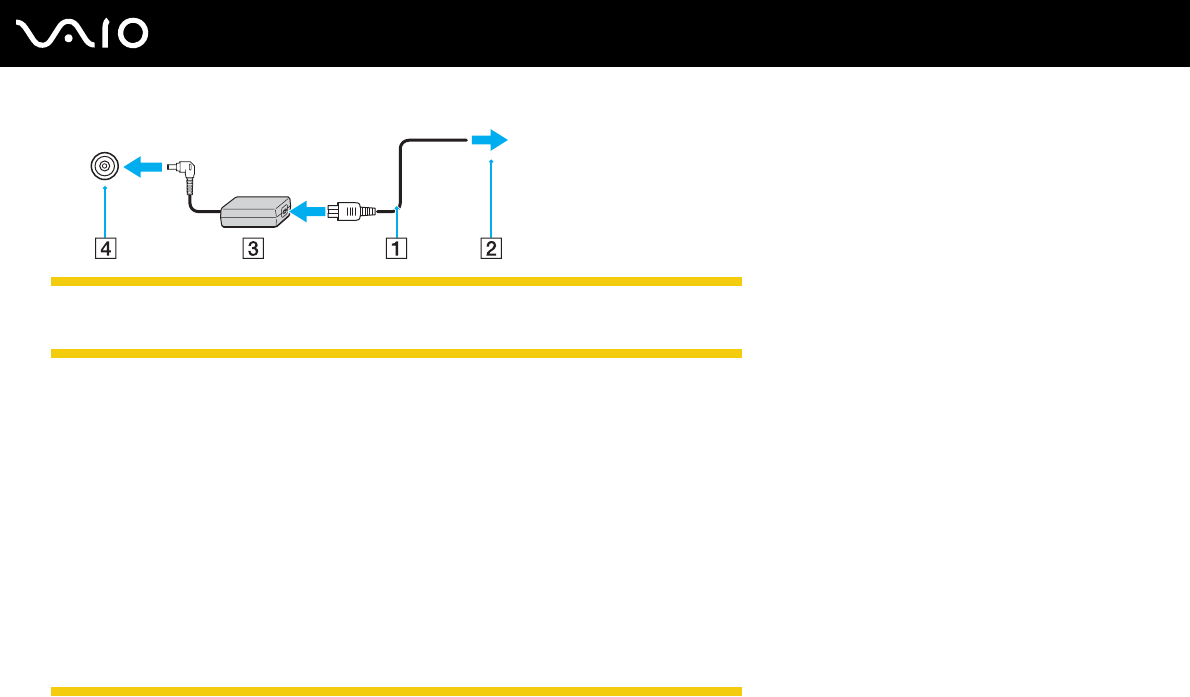
28
nN
Getting Started
Except IRX-3960_BGN
!
The shape of the DC In plug varies depending on the AC adapter.
Except IRX-3960_END
✍
To disconnect your computer completely from AC power, unplug the AC adapter.
Make sure that the AC outlet is easily accessible.
If you do not use your computer for a long period of time, place the computer into Hibernate mode. See Using Hibernate Mode (page 171). This power
saving mode saves the time of shutting down or resuming.
Using the Battery Pack
The battery pack supplied with your computer is not fully charged at the time of purchase.
Installing the Battery Pack
IRX-3960_BGN
To install the battery pack
1Turn off the computer and close the LCD screen lid.
2Slide the battery LOCK switch (1) inward on the bottom of the computer.

30
nN
Getting Started
5Slide the battery LOCK switch outward to secure the battery pack to the computer.
IRX-3960_END
✍
When your computer is directly connected to AC power and has a battery pack installed, it uses power from the AC outlet.
US model_BGN
!
This computer is designed to operate only with genuine Sony batteries.
US model_END
Euro model_BGN
!
Certain rechargeable batteries do not meet Sony quality and safety standards. For safety reasons this computer only functions with genuine Sony
batteries designed for this model. When installing another kind of battery, the battery will not be charged and the computer will not function.
Euro model_END
GVD model_BGN
!
For your safety, it is highly recommended that you use genuine Sony rechargeable battery packs and AC adapters that meet the quality assurance
standard, supplied by Sony for your VAIO computer. Some VAIO computers may only function with a genuine Sony battery.
GVD model_END
China model_BGN
!
Insert CS statement a-2 here!
China model_END
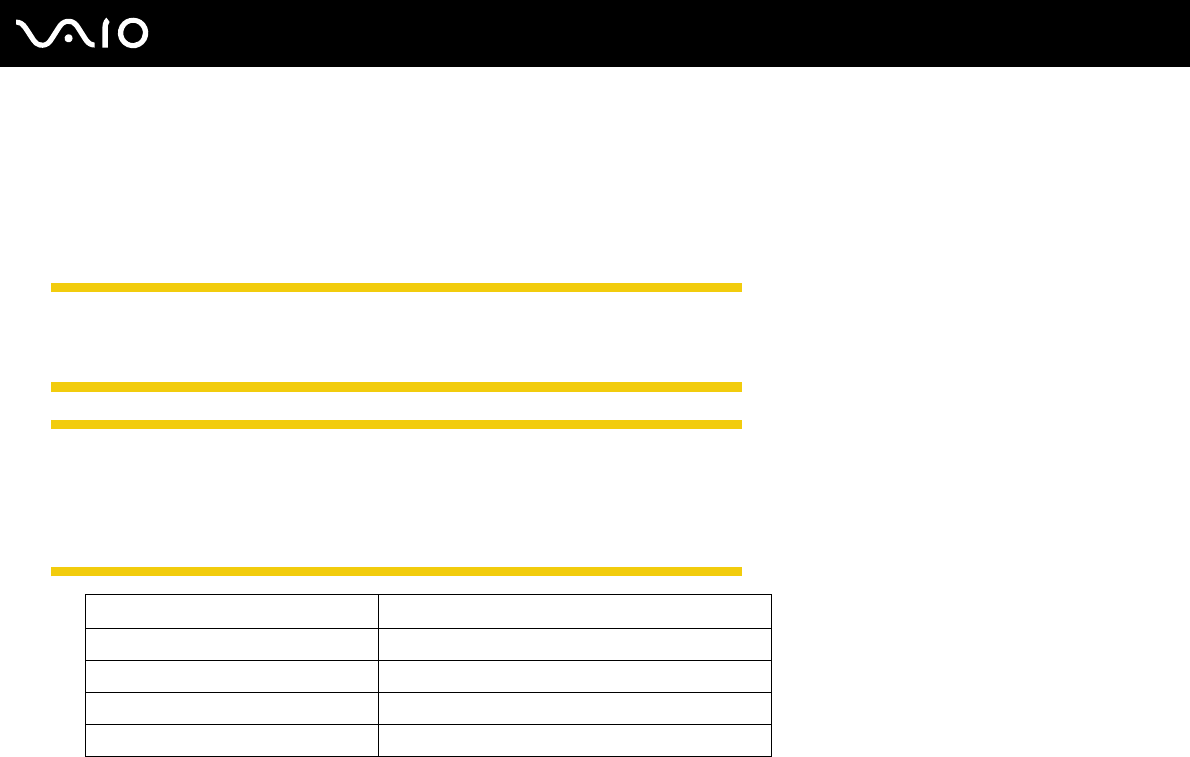
31
nN
Getting Started
Charging the Battery Pack
The battery pack supplied with your computer is not fully charged at the time of purchase.
To charge the battery pack
1Install the battery pack.
Except IRX-3960_BGN
2Connect the AC adapter to the computer.
The computer automatically charges the battery pack (the battery indicator light flashes in a double blink pattern as the
battery pack charges). When the battery pack is about 85% charged, the battery indicator turns off.
Except IRX-3960_END
IRX-3960_BGN
3Connect the AC adapter to the computer.
The computer automatically charges the battery pack (the battery indicator light flashes in a double blink pattern as the
battery pack charges). When the battery pack charges to the charge level you selected with the battery care function, the
battery indicator turns off. To select your desired maximum charge level with the battery care function, see To use the
battery care function (page 32).
IRX-3960_END
Battery indicator light status Meaning
On The computer is using battery power.
Blinks The battery pack is running out of power.
Double blinks The battery pack is charging.
Off The computer is using AC power.

32
nN
Getting Started
✍
You can charge the battery pack in such a usual manner as mentioned in this manual from the first time.
When the battery pack is running out of power, both the battery and power indicator lights blink.
Keep the battery pack in your computer while it is directly connected to AC power. The battery pack continues to charge while you are using the
computer.
If the battery level falls below 10%, you should either attach the AC adapter to recharge the battery pack or shut down your computer and install a fully
charged battery pack.
The battery pack supplied with your computer is a lithium ion battery pack and can be recharged any time. Charging a partially discharged battery pack
does not affect battery life.
The battery indicator light is on while you use the battery pack as a power source. When battery life is nearly depleted, both the battery and power
indicator lights start flashing.
For some software applications and some peripheral devices, your computer may not enter Hibernate mode even when battery life is low. To avoid loss
of data when using battery power, you should save your data frequently and manually activate a power management mode, such as Sleep or Hibernate.
If the battery pack wears out when the computer enters Sleep mode, you will lose any unsaved data. Going back to the previous work state is impossible.
To avoid loss of data, you should save your data frequently.
When your computer is directly connected to AC power and has a battery pack installed, it uses power from the AC outlet.
IRX-3960_BGN
To use the battery care function
You can select your desired maximum charge level with the battery care function to reduce battery degradation.
1Click Start, All Programs, and VAIO Control Center.
The VAIO Control Center window appears.
2Double-click Power Management and Battery Care Function.

33
nN
Getting Started
3Click to select the Enable Battery Care Function check box.
4Select the desired maximum charge level.
5Click OK.
IRX-3960_END
Removing the Battery Pack
!
You may lose data if you remove the battery pack while your computer is on and not connected to the AC adapter or if you remove the battery pack
while the computer is in Sleep mode.
IRX-3960_BGN
To remove the battery pack
1Turn off the computer and close the LCD screen lid.
2Slide the battery LOCK switch (1) inward and slide and hold the battery RELEASE latch (2) on the bottom of the
computer.

35
nN
Getting Started
Shutting Down Your Computer Safely
To avoid losing unsaved data, be sure to shut down your computer properly, as described below.
To shut down your computer
1Turn off any peripherals connected to the computer.
Except China_BGN
Except GVD model_BGN
2Click Start, the arrow next to the Lock button, and Shut Down.
Except GVD model_END
Except China_END
Except US model_BGN
Except Euro_BGN
3Click Start , the arrow next to the Lock button, and Shut Down.
Except Euro_END
Except US model_END
4Respond to any prompts warning you to save documents or to consider other users and wait for the computer to turn off
automatically.
The power indicator light turns off.

36
nN
Using Your VAIO Computer
Using Your VAIO Computer
Except China_BGN
Except GVD model_BGN
This section describes how to get the most out of using your VAIO computer.
Except GVD model_END
Except China_END
Except Euro_BGN
Except US model_BGN
Once you have read and followed the information in the printed Specifications sheet, you can start using your VAIO
computer safely and confidently.
Read on to get the most out of using the computer.
Except US model_END
Except Euro_END
❑Using the Keyboard (page 37)
❑Using the Touch Pad (page 42)
❑Using Special-function Buttons (page 45)
❑Using the Built-in MOTION EYE Camera (page 48)
❑Using the Optical Disc Drive (page 50)
❑Using the ExpressCard Module (page 59)
❑Using the Memory Stick Media (page 64)
❑Using Other Memory Cards (page 68)

37
nN
Using Your VAIO Computer
❑Using the Internet (page 72)
❑Using Wireless LAN (WLAN) (page 73)
❑Using the Bluetooth Functionality (page 83)
Using the Keyboard
Your keyboard is very similar to a desktop computer keyboard, but has additional keys that perform model-specific tasks.
Euro model_BGN
The VAIO-Link Web site (http://support.vaio.sony.eu) also contains glossary information to help you use the keyboard.
Euro model_END
Combinations and Functions with the Fn Key
✍
Some functions are not available before the operating system launches.
IRX-3960_BGN
US model_BGN
Combinations/Feature Functions
Fn + (F1): wireless switching*1 Toggles among Bluetooth, wireless LAN, and wireless WAN functionalities.
Fn + % (F2): speaker switch Turns on and off the built-in speakers and the headphones.
Fn + 2 (F3/F4): volume Adjusts the volume level.
To increase the volume, press Fn+F4 and then M or ,, or keep pressing Fn+F4.
To decrease the volume, press Fn+F3 and then m or <, or keep pressing Fn+F3.

38
nN
Using Your VAIO Computer
US model_END
Euro model_BGN
Fn + 8 (F5/F6): brightness control Adjusts the LCD brightness of your computer screen.
To increase lightness intensity, press Fn+F6 and then M or ,, or keep pressing Fn+F6.
To decrease lightness intensity, press Fn+F5 and then m or <, or keep pressing Fn+F5.
Fn + /T (F7): display output Toggles among your computer screen, an external display, and simultaneous output to both.
Fn + (F10): zoom Changes the screen resolution to magnify/restore your computer's screen view.
✍
The magnified view is not as clear as the standard view, as it is implemented by applying a lower resolution
to the computer screen with a higher resolution.
This key combination may not work with graphic images as it magnifies the screen view by changing the
resolution.
The location and size of software windows may change when the screen view is magnified or the standard
view is restored because pressing this key combination changes the resolution.
When your computer's screen view is magnified, switching the view to the external display disables the
function and restores the standard view.
Fn + (F12): Hibernate Provides for the lowest level of power consumption. When you execute this command, the
states of the system and the peripheral devices are written to the built-in flash memory storage
or hard disk drive*2 and the system power is turned off. To return the system to its original state,
use the power button to turn on the power.
For details on power management, see Using the Power Saving Modes (page 168).
*1 On selected models only.
*2 Your computer is equipped with either the built-in flash memory storage or hard disk drive, depending on the model you purchased. See the online Specifications
to find which storage device your model is equipped with.
Combinations/Feature Functions

39
nN
Using Your VAIO Computer
Combinations/Feature Functions
Fn + % (F2): speaker switch Turns on and off the built-in speakers and the headphones.
Fn + 2 (F3/F4): volume Adjusts the volume level.
To increase the volume, press Fn+F4 and then M or ,, or keep pressing Fn+F4.
To decrease the volume, press Fn+F3 and then m or <, or keep pressing Fn+F3.
Fn + 8 (F5/F6): brightness control Adjusts the LCD brightness of your computer screen.
To increase lightness intensity, press Fn+F6 and then M or ,, or keep pressing Fn+F6.
To decrease lightness intensity, press Fn+F5 and then m or <, or keep pressing Fn+F5.
Fn + /T (F7): display output Toggles among your computer screen, an external display, and simultaneous output to both.
Fn + (F10): zoom Changes the screen resolution to magnify/restore your computer's screen view.
✍
The default resolutions of the standard view and the magnified view are as follows:
Standard view: 1366 x 768 pixels
Magnified view: 1064 x 600 pixels
The magnified view is not as clear as the standard view, as it is implemented by applying a lower resolution
to the computer screen with a higher resolution.
This key combination may not work with graphic images as it magnifies the screen view by changing the
resolution.
The location and size of software windows may change when the screen view is magnified or the standard
view is restored because pressing this key combination changes the resolution.
When your computer's screen view is magnified, switching the view to the external display disables the
function and restores the standard view.
Fn + (F12): Hibernate Provides for the lowest level of power consumption. When you execute this command, the
states of the system and the peripheral devices are written to the built-in flash memory storage
or hard disk drive* and the system power is turned off. To return the system to its original state,
use the power button to turn on the power.
For details on power management, see Using the Power Saving Modes (page 168).
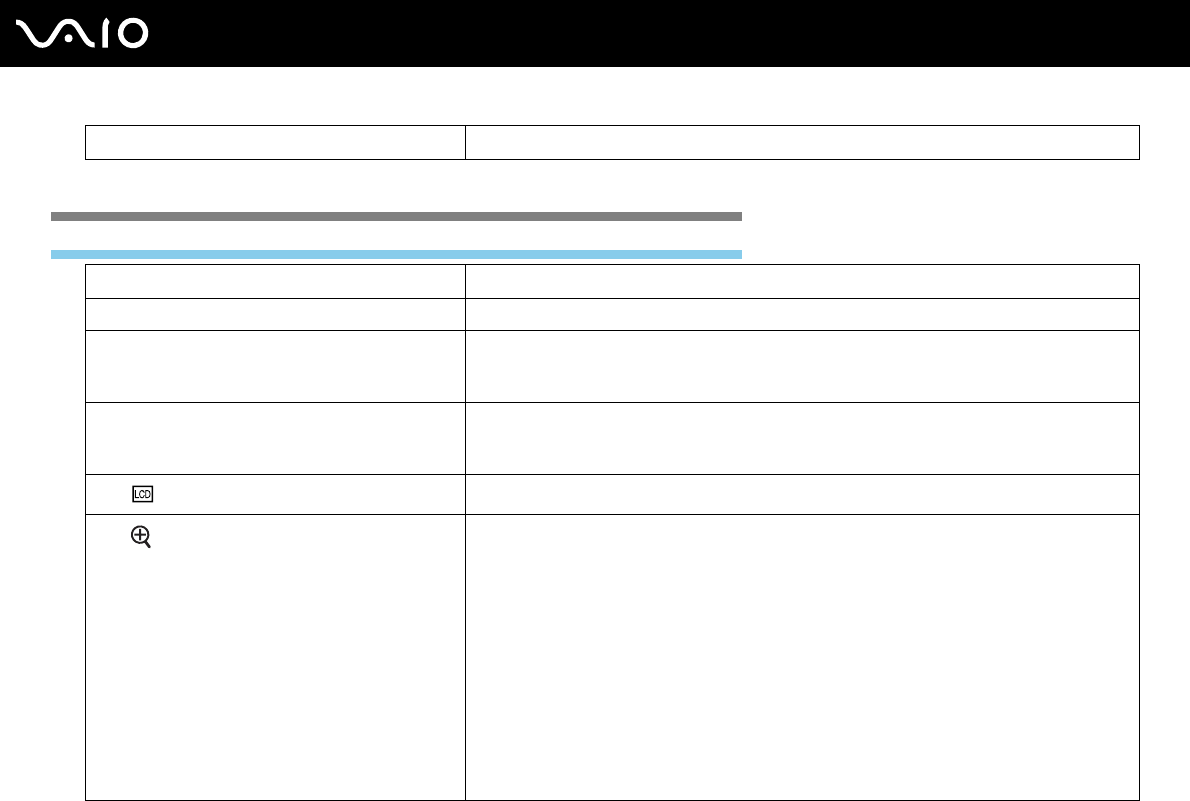
40
nN
Using Your VAIO Computer
Euro model_END
GVD model_BGN
* Your computer is equipped with either the built-in flash memory storage or hard disk drive, depending on the model you purchased. See the online Specifications
to find which storage device your model is equipped with.
Combinations/Feature Functions
Fn + % (F2): speaker switch Turns on and off the built-in speakers and the headphones.
Fn + 2 (F3/F4): volume Adjusts the volume level.
To increase the volume, press Fn+F4 and then M or ,, or keep pressing Fn+F4.
To decrease the volume, press Fn+F3 and then m or <, or keep pressing Fn+F3.
Fn + 8 (F5/F6): brightness control Adjusts the LCD brightness of your computer screen.
To increase lightness intensity, press Fn+F6 and then M or ,, or keep pressing Fn+F6.
To decrease lightness intensity, press Fn+F5 and then m or <, or keep pressing Fn+F5.
Fn + /T (F7): display output Toggles among your computer screen, an external display, and simultaneous output to both.
Fn + (F10): zoom Changes the screen resolution to magnify/restore your computer's screen view.
✍
The default resolutions of the standard view and the magnified view are as follows:
Standard view: 1366 x 768 pixels
Magnified view: 1064 x 600 pixels
The magnified view is not as clear as the standard view, as it is implemented by applying a lower resolution
to the computer screen with a higher resolution.
This key combination may not work with graphic images as it magnifies the screen view by changing the
resolution.
The location and size of software windows may change when the screen view is magnified or the standard
view is restored because pressing this key combination changes the resolution.
When your computer's screen view is magnified, switching the view to the external display disables the
function and restores the standard view.
Combinations/Feature Functions

41
nN
Using Your VAIO Computer
GVD model_END
China model_BGN
Fn + (F12): Hibernate Provides for the lowest level of power consumption. When you execute this command, the
states of the system and the peripheral devices are written to the built-in flash memory storage
or hard disk drive* and the system power is turned off. To return the system to its original state,
use the power button to turn on the power.
For details on power management, see Using the Power Saving Modes (page 168).
* Your computer is equipped with either the built-in flash memory storage or hard disk drive, depending on the model you purchased. See the printed Specifications
sheet to find which storage device your model is equipped with.
Combinations/Feature Functions
Fn + % (F2): speaker switch Turns on and off the built-in speakers and the headphones.
Fn + 2 (F3/F4): volume Adjusts the volume level.
To increase the volume, press Fn+F4 and then M or ,, or keep pressing Fn+F4.
To decrease the volume, press Fn+F3 and then m or <, or keep pressing Fn+F3.
Fn + 8 (F5/F6): brightness control Adjusts the LCD brightness of your computer screen.
To increase lightness intensity, press Fn+F6 and then M or ,, or keep pressing Fn+F6.
To decrease lightness intensity, press Fn+F5 and then m or <, or keep pressing Fn+F5.
Fn + /T (F7): display output Toggles among your computer screen, an external display, and simultaneous output to both.
Combinations/Feature Functions
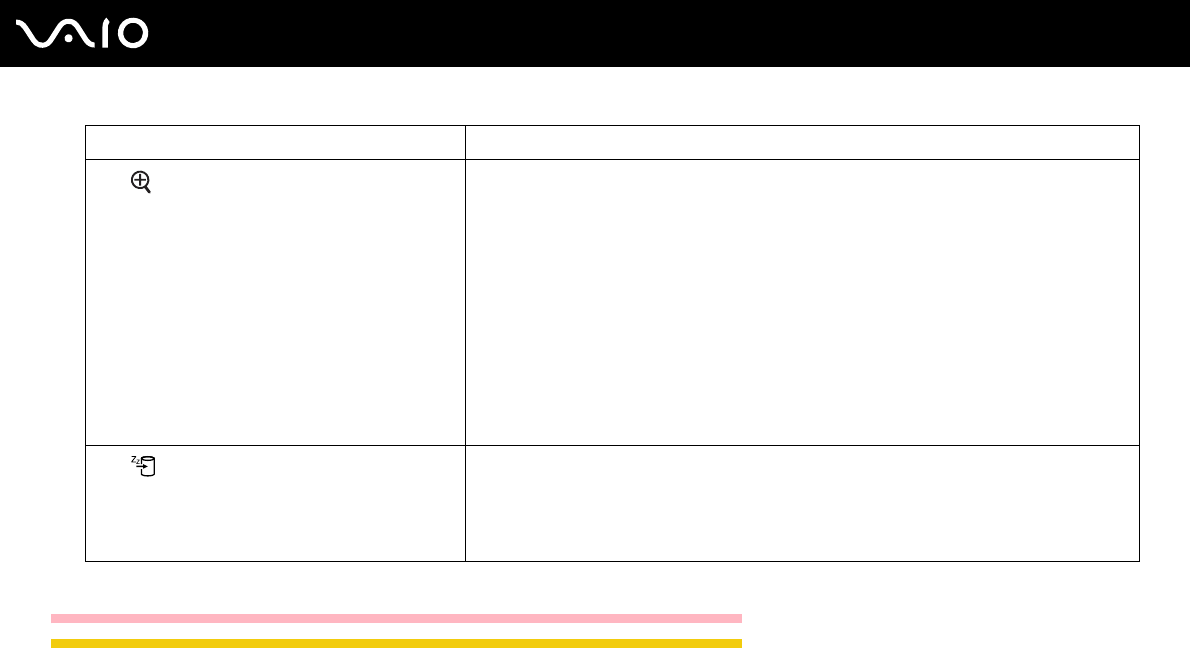
42
nN
Using Your VAIO Computer
China model_END
IRX-3960_END
Using the Touch Pad
You can point to, select, drag, and scroll objects on the screen using the touch pad.
Fn + (F10): zoom Changes the screen resolution to magnify/restore your computer's screen view.
✍
The default resolutions of the standard view and the magnified view are as follows:
Standard view: 1366 x 768 pixels
Magnified view: 1064 x 600 pixels
The magnified view is not as clear as the standard view, as it is implemented by applying a lower resolution
to the computer screen with a higher resolution.
This key combination may not work with graphic images as it magnifies the screen view by changing the
resolution.
The location and size of software windows may change when the screen view is magnified or the standard
view is restored because pressing this key combination changes the resolution.
When your computer's screen view is magnified, switching the view to the external display disables the
function and restores the standard view.
Fn + (F12): Hibernate Provides for the lowest level of power consumption. When you execute this command, the
states of the system and the peripheral devices are written to the primary storage device (a
built-in flash memory storage or hard disk drive*) and the system power is turned off. To return
the system to its original state, use the power button to turn on the power.
For details on power management, see Using the Power Saving Modes (page 168).
* Your computer is equipped with either the built-in flash memory storage or hard disk drive, depending on the model you purchased. See the printed Specifications
sheet to find which storage device your model is equipped with.
Combinations/Feature Functions
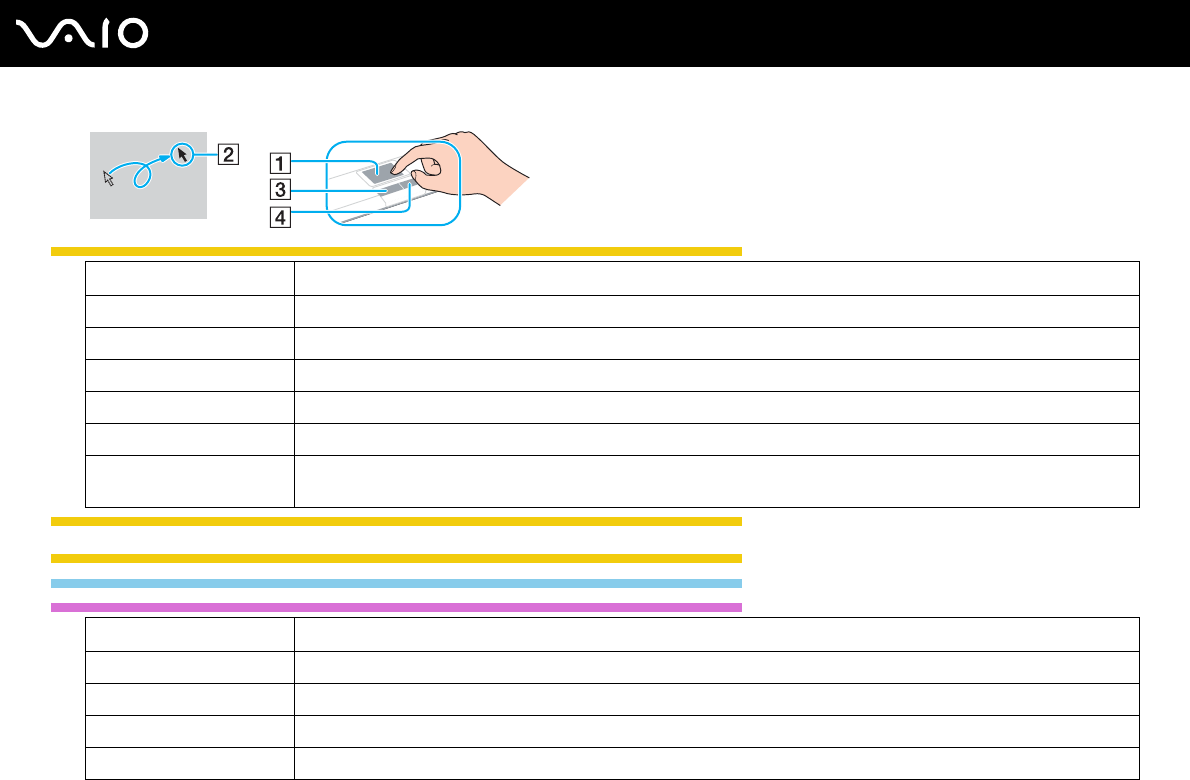
43
nN
Using Your VAIO Computer
Except IRX-3960_BGN
Except IRX-3960_END
IRX-3960_BGN
Except GVD model_BGN
Except US model_BGN
Action Description
Point Slide your finger on the touch pad (1) to place the pointer (2) on an item or object.
Click Press the left button (3) once.
Double-click Press the left button twice.
Right-click Press the right button (4) once. In many applications, this action displays a shortcut menu.
Drag Slide your finger on the touch pad while pressing the left button.
Scroll Slide your finger along the right edge of the touch pad to scroll vertically. Slide your finger along the bottom edge to scroll
horizontally (the scroll function is available only with applications that support a touch pad scroll feature).
Action Description
Point Slide your finger on the touch pad (1) to place the pointer (2) on an item or object.
Click Press the left button (3) once.
Double-click Press the left button twice.
Right-click Press the right button (4) once. In many applications, this action displays a shortcut menu.
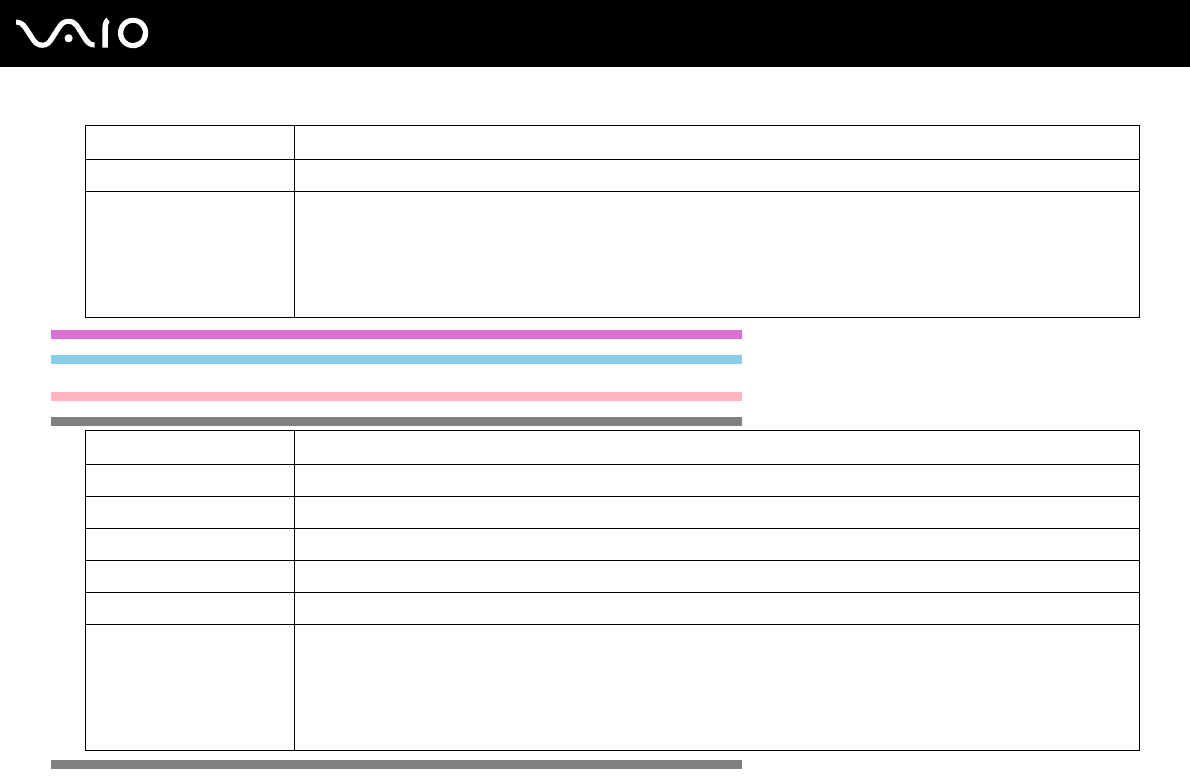
44
nN
Using Your VAIO Computer
Except US model_END
Except GVD model_END
Except China_BGN
Except Euro_BGN
Except Euro_END
Drag Slide your finger on the touch pad while pressing the left button.
Scroll Slide your finger along the right edge of the touch pad to scroll vertically. Slide your finger along the bottom edge to scroll
horizontally (the scroll function is available only with applications that support a touch pad scroll feature).
✍
On the models with the fingerprint sensor, you can also use the sensor for vertical scrolling while the Scroll lock indicator is lit. Press
the Fn+Scr Lk keys to turn on and off the indicator.
Action Description
Point Slide your finger on the touch pad (1) to place the pointer (2) on an item or object.
Click Press the left button (3) once.
Double-click Press the left button twice.
Right-click Press the right button (4) once. In many applications, this action displays a shortcut menu.
Drag Slide your finger on the touch pad while pressing the left button.
Scroll Slide your finger along the right edge of the touch pad to scroll vertically. Slide your finger along the bottom edge to scroll
horizontally (the scroll function is available only with applications that support a touch pad scroll feature).
✍
You can also use the fingerprint sensor for vertical scrolling while the Scroll lock indicator is lit. Press the Fn+Scr Lk keys to turn on
and off the indicator.
Action Description

45
nN
Using Your VAIO Computer
Except China_END
IRX-3960_END
Except US model_BGN
✍
You can disable/enable the touch pad to suit your preference for using the mouse. See Setting Up Your Computer with VAIO Control Center (page 166)
to launch VAIO Control Center. Once launched, select the topic on the pointing device and click Help to see the detailed instructions.
Except US model_END
Using Special-function Buttons
Your computer is equipped with special buttons to help you use specific functions of the computer.
IRX-3960_BGN
Except China_BGN
The AV MODE, Play/Pause, Stop, Previous track, and Next track buttons support Instant Mode. To activate Instant Mode,
the computer must be off or in Hibernate mode. See the printed Instant Mode booklet for more information on the Instant
Mode.
Except China_END
China model_BGN
The AV MODE, Play/Pause, Stop, Previous track, and Next track buttons support Instant Mode*. To activate Instant Mode,
the computer must be off or in Hibernate mode. See the printed Instant Mode booklet for more information on the Instant
Mode.
* On models with the built-in optical disc drive only.
China model_END
IRX-3960_END
IRX-3960_BGN

46
nN
Using Your VAIO Computer
Except China_BGN
Except GVD model_BGN
Except GVD model_END
Except China_END
GVD model_BGN
Special-function button Functions
AV MODE button When the computer is off or in Hibernate mode:
Activates Instant Mode to enable you immediately to play music and view the image data stored on the built-
in flash memory storage or hard disk drive* without launching Windows. See the printed Instant Mode booklet
for more information.
When the computer is on or in Sleep mode:
Launches VAIO AV Mode Launcher for selecting the desired software.
You can change the default software options in VAIO AV Mode Launcher. To do so, press and hold the AV
MODE button to display the setup window.
Stop button Stops playback of a CD or DVD disc media or a music/video file stored on the built-in flash memory storage
or hard disk drive*.
Play/Pause button Starts or pauses playback of a CD or DVD disc media or a music/video file stored on the built-in flash memory
storage or hard disk drive*.
Previous track button Plays the previous chapter/file during video playback or the previous song/file during audio playback.
Next track button Plays the next chapter/file during video playback or the next song/file during audio playback.
Disc drive eject button Ejects the optical disc drive tray.
If this button does not work, try the substitute drive eject button on the optical disc drive.
* Your computer is equipped with either the built-in flash memory storage or hard disk drive, depending on the model you purchased. See the online Specifications
to find which storage device your model is equipped with.
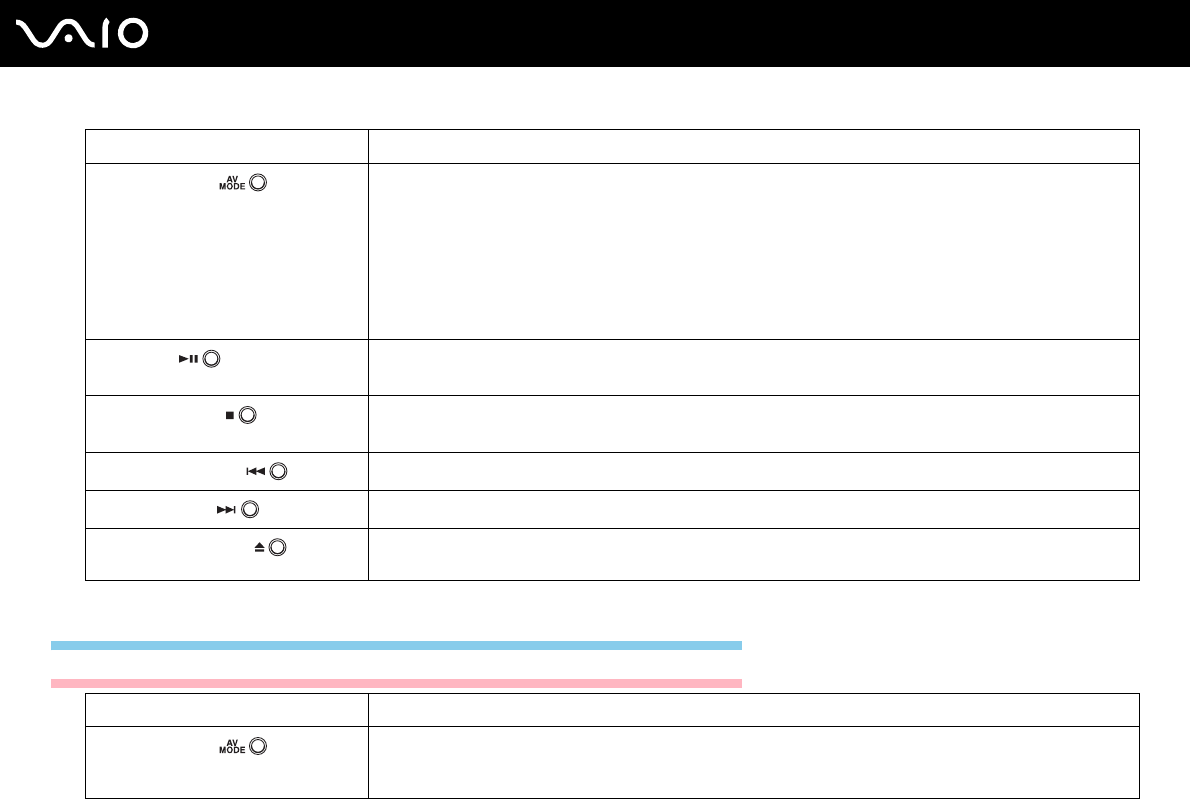
47
nN
Using Your VAIO Computer
GVD model_END
China model_BGN
Special-function button Functions
AV MODE button When the computer is off or in Hibernate mode:
Activates Instant Mode to enable you immediately to play music and view the image data stored on the built-
in flash memory storage or hard disk drive* without launching Windows. See the printed Instant Mode booklet
for more information.
When the computer is on or in Sleep mode:
Launches VAIO AV Mode Launcher for selecting the desired software.
You can change the default software options in VAIO AV Mode Launcher. To do so, press and hold the AV
MODE button to display the setup window.
Stop button Stops playback of a CD or DVD disc media or a music/video file stored on the built-in flash memory storage
or hard disk drive*.
Play/Pause button Starts or pauses playback of a CD or DVD disc media or a music/video file stored on the built-in flash memory
storage or hard disk drive*.
Previous track button Plays the previous chapter/file during video playback or the previous song/file during audio playback.
Next track button Plays the next chapter/file during video playback or the next song/file during audio playback.
Disc drive eject button Ejects the optical disc drive tray.
If this button does not work, try the substitute drive eject button on the optical disc drive.
* Your computer is equipped with either the built-in flash memory storage or hard disk drive, depending on the model you purchased. See the printed Specifications
sheet to find which storage device your model is equipped with.
Special-function button Functions
AV MODE button Launches VAIO AV Mode Launcher for selecting the desired software.
You can change the default software options in VAIO AV Mode Launcher. To do so, press and hold the AV
MODE button to display the setup window.

48
nN
Using Your VAIO Computer
China model_END
IRX-3960_END
Using the Built-in MOTION EYE Camera
IRX-3960_BGN
Except GVD model_BGN
Except China_BGN
Stop button Stops playback of a CD or DVD disc media*1 or a music/video file stored on the built-in flash memory storage
or hard disk drive*2.
Play/Pause button Starts or pauses playback of a CD or DVD disc media*1 or a music/video file stored on the built-in flash
memory storage or hard disk drive*2.
Previous track button Plays the previous chapter/file during video playback or the previous song/file during audio playback.
Next track button Plays the next chapter/file during video playback or the next song/file during audio playback.
Disc drive eject button
*1 Ejects the optical disc drive tray.
If this button does not work, try the substitute drive eject button on the optical disc drive.
S button *3 By default, the S button turns off the sound volume. You can change this button assignment on the window
for changing the S button assignment. To display this window, press and hold the button or launch and
navigate through VAIO Control Center.
*1 On models with the built-in optical disc drive.
*2 Your computer is equipped with either the built-in flash memory storage or hard disk drive, depending on the model you purchased.
*3 On models without the built-in optical disc drive.
See the printed Specifications sheet to find whether your model is equipped with the optical disc drive.
Special-function button Functions

49
nN
Using Your VAIO Computer
Your computer may be equipped with a built-in MOTION EYE camera. See the online Specifications to find whether your
model is equipped with the built-in MOTION EYE camera.
Except China_END
Except GVD model_END
Except Euro_BGN
Except US model_BGN
Your computer is equipped with a built-in MOTION EYE camera.
Except US model_END
Except Euro_END
IRX-3960_END
The built-in MOTION EYE camera adds video functionality to instant messaging software and video editing software.
Turning on the computer activates the built-in MOTION EYE camera, so the computer is ready for a video conference using
such software.
Note that launching or exiting your instant messaging or video editing software does not activate or deactivate the built-in
MOTION EYE camera, respectively. Make sure that the camera is activated before using the software.
✍
The built-in MOTION EYE camera cannot be shared by more than one software application. If another software application is using the camera, exit the
application before using the built-in MOTION EYE camera.
When capturing an image in a dark place, click the VAIO Camera Utility icon on the taskbar and the Advanced Setting tab on the Properties window,
and select the Low Light check box. It decreases the frame rate and slows down the shutter speed to allow the camera to capture more light.
!
The viewer window may show some noises, for example horizontal streaks, if you view a rapid-moving object. This is normal and does not indicate a
malfunction.
You cannot operate the built-in MOTION EYE camera with the Microsoft Windows MovieMaker software.

50
nN
Using Your VAIO Computer
Using the Optical Disc Drive
Except China_BGN
Your computer is equipped with an optical disc drive.
Except China_END
China model_BGN
Your computer may be equipped with an built-in optical disc drive. See the printed Specifications sheet to find whether your
model is equipped with the optical disc drive.
China model_END
To insert a disc
1Turn on the computer.
2Press the disc drive eject button (1) to open the drive.
The tray slides out.
✍
If the disc drive eject button does not work, try the substitute drive eject button on the optical disc drive.
If power supply to the optical disc drive is disabled by VAIO Power Management, it will take a while to eject the drive tray. Note that the substitute drive
eject button is disabled when the optical disc drive is not powered.
When recovering your system, turn on your computer and press the substitute drive eject button on the optical disc drive. Insert your Recovery Disc
into the optical disc drive, turn off the computer, and then turn on the computer again to start the recovery process.
3Place a disc in the middle of the tray with the label side facing upward and gently push it until the disc clicks into place.
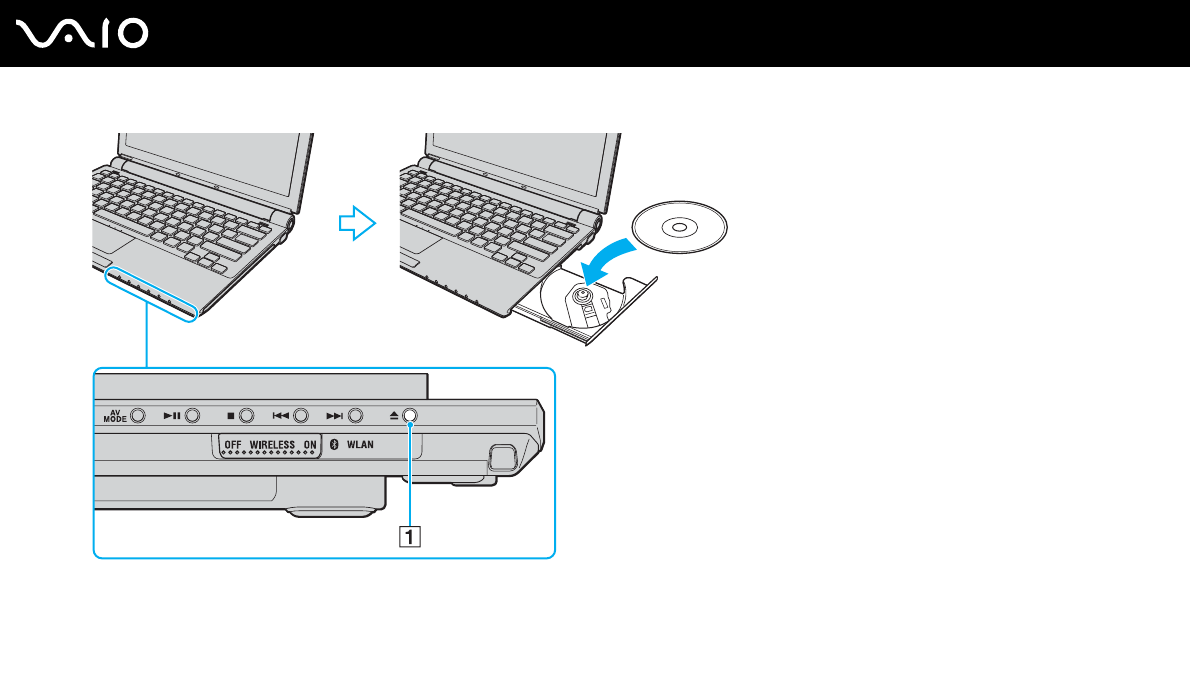
51
nN
Using Your VAIO Computer
4Close the tray by pushing it in gently.
!
Do not remove the optical disc when your computer is in a power saving mode (Sleep or Hibernate). Doing so may cause the computer to malfunction.
✍
If you plan to use an external optical disc drive, connect the drive before you launch any preinstalled disc operation program.

52
nN
Using Your VAIO Computer
Reading and Writing Optical Discs
Your computer plays and records CDs, DVDs, or Blu-ray Discs, depending on the model you purchased. Check your
specifications for the type of optical disc drive installed on your model. Use the table below to see which types of media your
optical disc drive supports.
PR: playable and recordable
P: playable but not recordable
–: not playable or recordable
CD-
ROM
Video
CD
Music
CD
CD
Extra
CD-R/
RW
DVD-
ROM
DVD-
Video
BD-
ROM
DVD-R/
RW
DVD+R/
RW
DVD+R
DL
DVD-R
DL
DVD-
RAM BD-R*9/
RE*10
DVD±RW/
±R DL/RAM
PPPPPRPP–PR*1 *2 PR PR*5 PR*6 PR*3 *4 –
CD-RW/
DVD-ROM
PPPPPRPP–PPPP––
DVD-ROMPPPPPPP–PPPP––
Blu-ray Disc P P P P PR*8 PPPPR*1 *2 PR PR*5 PR*6 PR*3 *4 PR*7

53
nN
Using Your VAIO Computer
!
This product is designed to playback discs that conform to the Compact Disc Digital Audio standard specifications (CD Standard). A DualDisc is a two
sided disc product which mates DVD recorded material on one side with digital audio material on the other side. Be aware that the audio side (non-DVD
side) of a DualDisc may not play on this product because it does not conform to the CD Standard.
Due to the multiple formats of discs now available, when buying pre-recorded or blank discs for use with a VAIO computer, be sure to read the notices
on the disc packaging carefully to check both playback and recording compatibility with your computer's optical disc drives. Sony does NOT guarantee
the compatibility of VAIO CD drives with discs that are not compliant with the official "CD" format standard (or "DVD" standard in relation to DVD drives,
or "Blu-ray Disc" standard in relation to Blu-ray Disc drives). USING NON-COMPLIANT DISCS CAN CAUSE FATAL DAMAGE TO YOUR VAIO PC OR
CREATE SOFTWARE CONFLICTS AND CAUSE SYSTEM HANGING.
For inquiries about disc formats, contact the individual publisher of the pre-recorded disc or the manufacturer of the recordable disc.
✍
8cm disc writing is not supported.
*1 Supports writing data to DVD-R discs compliant with DVD-R for General Version 2.0/2.1.
*2 Supports writing data to DVD-RW discs compliant with DVD-RW Version 1.1/1.2.
*3 The DVD±RW/RAM disc drive on your computer does not support the DVD-RAM cartridge. Use non-cartridge discs or discs with removable cartridge.
*4 Writing data to single-sided DVD-RAM discs (2.6 GB) compliant with DVD-RAM Version 1.0 is not supported.
DVD-RAM Version 2.2/12X-SPEED DVD-RAM Revision 5.0 disc is not supported.
*5 Writing data to DVD+R DL (Double Layer) discs is available only on discs supporting DVD+R DL (Double Layer) recording.
*6 Writing data to DVD-R DL (Dual Layer) discs is available only on discs supporting DVD-R DL (Dual Layer) recording.
*7 Supports writing data to BD-R Version 1.1 discs (single-layer discs with the capacity of 25 GB, dual-layer discs with the capacity of 50 GB) and BD-RE Version 2.1
discs (single-layer discs with the capacity of 25 GB, dual-layer discs with the capacity of 50 GB). The Blu-ray Disc drive on your computer does not support BD-RE
Version 1.0 discs and Blu-ray cartridge discs.
*8 Writing data to Ultra Speed CD-RW discs is not supported on models with the Blu-ray Disc drive.
*9 BD-R stands for Blu-ray Disc-Recordable in Version 1.1 format.
*10 BD-RE stands for Blu-ray Disc-Rewritable in Version 2.1 format.

54
nN
Using Your VAIO Computer
!
To play copyright protected Blu-ray Discs continually, you need to update the AACS key. Note that the AACS key update requires Internet access.
As with other optical media devices, circumstances may limit compatibility or prevent Blu-ray Disc playback. VAIO computers may not support movie
playback on packaged media recorded in AVC or VC1 formats at high bit rates.
Region settings are required for Movies and BD-ROM contents. If the region setting and the region of the disc do not match, playback is not possible.
Unless your external display is compliant with the High-bandwidth Digital Content Protection (HDCP) standard, you cannot play or view the contents
of copyright protected Blu-ray Discs.
Some contents may restrict video output to be standard definition or prohibit analog video output at all. It is strongly recommended that digital HDCP-
compliant environment be implemented for optimum compatibility and viewing quality.
Notes on writing data to a disc
❑Use only Sony recommended software, which is preinstalled on your computer, to write data to a disc.
Other software programs may not be fully compatible and errors may result.
❑To make data on a disc readable on the optical disc drive, you need to close the session before you eject it. To complete
this process, follow the instructions included with your software.
❑Only use circular discs. Do not use discs in any other shape (star, heart, card, etc.), as this may damage the optical disc
drive.
❑Do not strike or shake your computer while writing data to a disc.
❑Deactivate the screen saver and exit anti-virus software before writing data to a disc.
❑Do not use memory-resident utility software while writing data to a disc. This may cause your computer to malfunction.
❑When using your software application to burn discs, make sure you exit and close all other applications.
❑Do not switch to power saving modes while using the preinstalled software or any disc burning software.

55
nN
Using Your VAIO Computer
❑Connect and use the AC adapter to power your computer or make sure your battery pack is at least 50 percent charged.
❑Make sure you use the same disc burning software to add data to a used disc. Use of different disc burning software for
additional data burning may cause a failure. For example, if you have a disc with data that you burned with the Roxio
Easy Media Creator software, use the Roxio Easy Media Creator software to add some data to the same disc.
Notes on playing discs
To achieve optimum performance when playing discs, you should follow these recommendations.
❑Some CD players and computer's optical disc drives may not be able to play audio CDs created with the CD-R or CD-RW
disc media.
❑Some DVD players and computer's optical disc drives may not be able to play DVDs created with the DVD+R DL, DVD-
R DL, DVD+R, DVD+RW, DVD-R, DVD-RW, or DVD-RAM disc media.
❑Do not use memory-resident utility software to speed up disc access when playing a disc. This may cause your computer
to malfunction.
❑Do not switch to power saving modes while your computer is playing a disc.
US model_BGN
❑Region code indicators are labeled on the DVDs to indicate in which region and on what type of player you can play the
disc. If the DVD is labeled "all," this means that you can play this DVD in most regions of the world. If the region code of
your residence area is different from the label on the DVD disc or on the packaging, you cannot play the disc on your
computer.
US model_END
Euro model_BGN
❑Region code indicators are labeled on the DVDs to indicate in which region and on what type of player you can play the
disc. Unless a "2" (Europe belongs to region "2") or "all" (this means that you can play this DVD in most regions of the
world) is labeled on your DVD disc or on the packaging, you cannot play the disc on your computer.
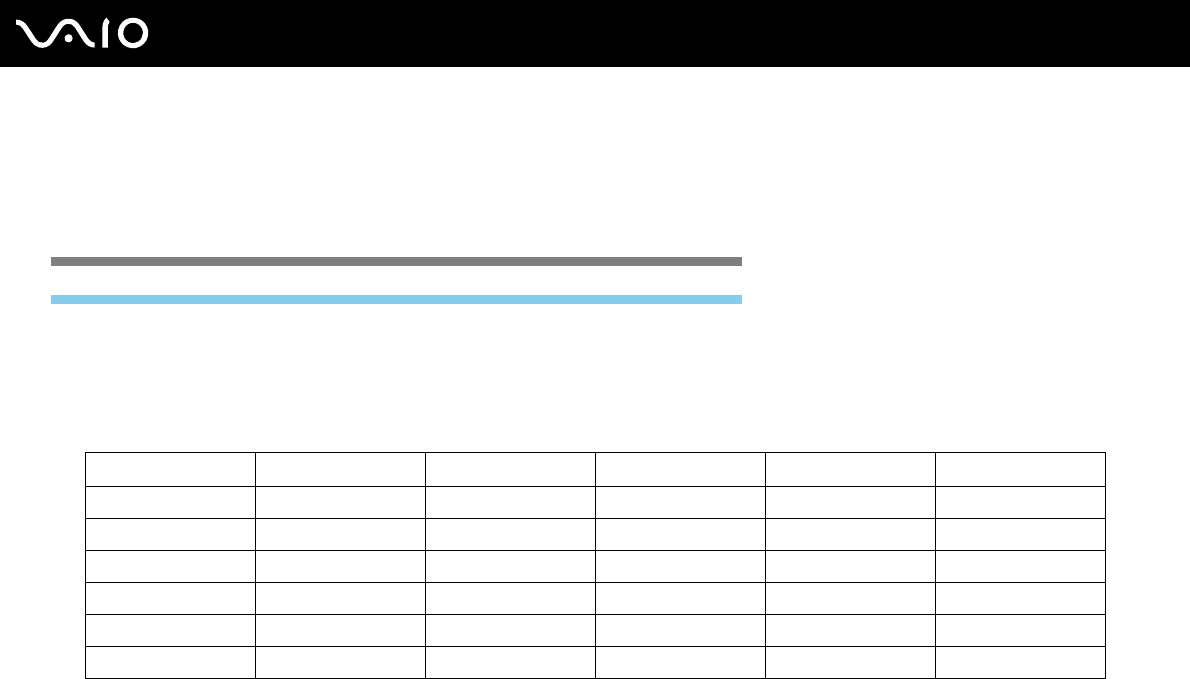
56
nN
Using Your VAIO Computer
!
If you change the DVD region code while the WinDVD or WinDVD BD software is running, restart the software or eject the disc and re-insert it to make
the new setting effective.
❑Do not try to change the region code settings of the DVD drive. Any difficulties caused by changing the region code
settings of the DVD drive are out of warranty.
Euro model_END
GVD model_BGN
❑Region code indicators are labeled on the DVDs to indicate in which region and on what type of player you can play the
disc. If the DVD is labeled "all," this means that you can play this DVD in most regions of the world. If the region code of
your residence area is different from the label on the DVD disc or on the packaging, you cannot play the disc on your
computer.
For finding the region code of your residence area, see the following table.
If it is your first time to play a DVD video on your computer, follow these steps before inserting the disc:
1Click Start and Computer.
2Right-click the optical disc drive icon and click Properties in the menu.
Residence area Region code Residence area Region code Residence area Region code
Australia* 4 China 6 Hong Kong* 3
India* 5 Indonesia* 3 Japan* 2
Korea 3 Malaysia* 3 New Zealand* 4
Philippines* 3 Saudi Arabia* 2 Singapore* 3
South Africa* 2 Taiwan 3 Thailand 3
United Arab Emirates* 2
* A region code is not assigned to your computer's optical disc drive by default.

57
nN
Using Your VAIO Computer
3Click the Hardware tab.
4Select your optical disc drive from the All disk drives list and click Properties.
5Click the DVD Region tab.
6Select an appropriate region from the list and click OK.
!
You can change the DVD region code only a limited number of times. When you have exceeded this number, the drive's DVD region code is permanently
assigned and you will not be able to change it again. Reconfiguring your computer does not reset this count.
If you change the DVD region code while the WinDVD or WinDVD BD software is running, restart the software or eject the disc and re-insert it to make
the new setting effective.
GVD model_END
China model_BGN
❑The default region code "6" is assigned to your computer's optical disc drive. Do not change this setting using any software
applications. System malfunctions originating from the user changing the DVD region code are beyond the scope of your
warranty and will result in service charges for repair.
China model_END
Playing CDs
To play an audio CD
1Insert a disc into the optical disc drive.
2If nothing appears on the desktop, then click Start, All Programs, and the desired CD software to play the CD.
If the Audio CD window appears, click to select an option.

58
nN
Using Your VAIO Computer
Copying Files to CDs
To copy files to a disc
!
Do not strike or shake your computer while writing data to a disc.
1Insert a disc into the optical disc drive.
If the AutoPlay window appears, click Burn files to disc and follow the on-screen instructions until the empty disc folder
appears.
2Open the folder that contains the file(s) you want to copy and drag them to the empty disc folder.
3Close the disc folder.
Playing DVDs
To play a DVD
1Close all running software applications.
2Insert a DVD into the optical disc drive.
3If nothing appears on the desktop, then click Start, All Programs, and the desired DVD software to play the DVD.
For instructions on how to use the software, see the help file on your DVD software.
Copying Files to DVDs
Except IRX-3960_BGN
Except GVD model_BGN
Except China_BGN
The DVD writing function is available on selected models only. See the online Specifications to find the type of your optical
disc drive, and then Reading and Writing Optical Discs (page 52) to find about the supported disc media.

59
nN
Using Your VAIO Computer
Except China_END
Except GVD model_END
Except Euro_BGN
Except US model_BGN
The DVD writing function is available on selected models only. See the printed Specifications sheet to find the type of your
optical disc drive, and then Reading and Writing Optical Discs (page 52) to find about the supported disc media.
Except US model_END
Except Euro_END
Except IRX-3960_END
To copy files to a disc
1Connect the AC adapter to the computer.
2Insert a disc into the optical disc drive.
3If nothing appears on the desktop, then click Start, All Programs, and the desired DVD software to copy files to the disc.
For instructions on how to use the software, see the help file on your DVD software.
Using the ExpressCard Module
Your computer is equipped with either a Universal ExpressCard™ slot* or an ExpressCard™/34 slot* for transferring data
among digital cameras, camcorders, music players, and other audio/video devices. The former can accommodate either an
ExpressCard™/34 (34 mm wide) or ExpressCard™/54 (54 mm wide) module* as shown below; and the latter, an
ExpressCard™/34 module* only.
❑ExpressCard™/34 module*❑ExpressCard™/54 module*
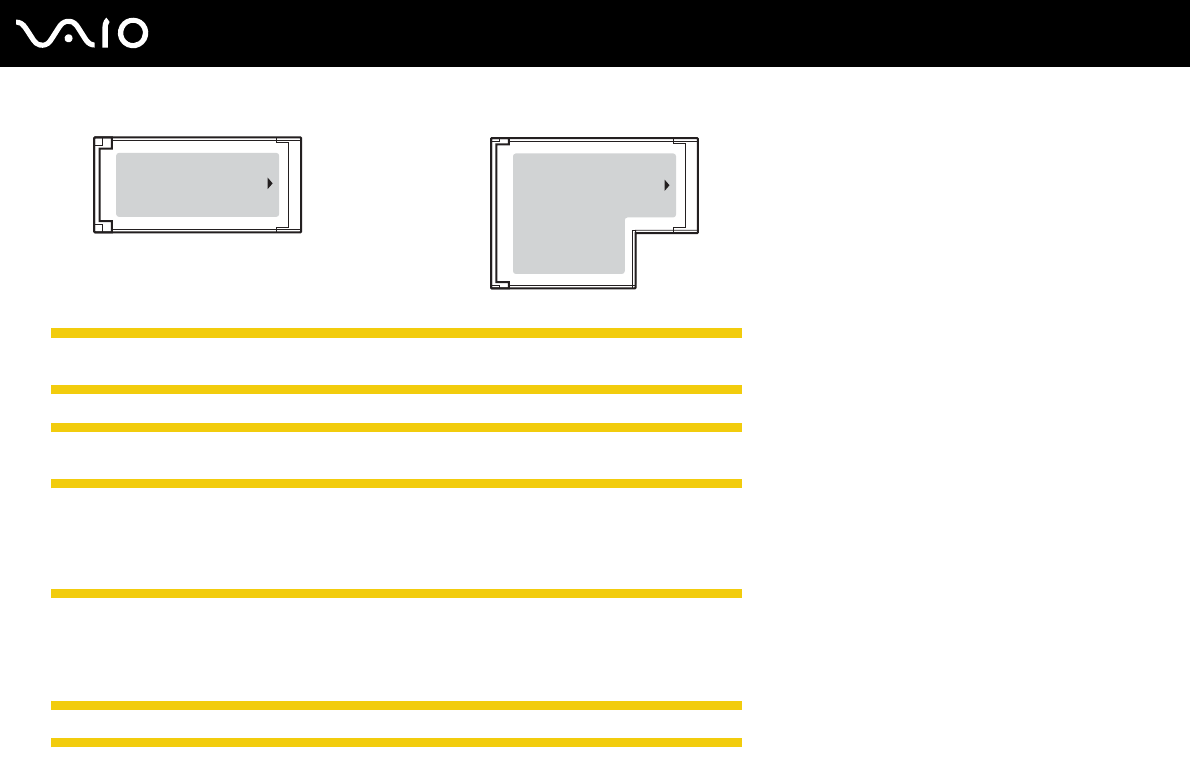
60
nN
Using Your VAIO Computer
IRX-3960_BGN
Your computer is equipped with an ExpressCard™/34 slot*.
IRX-3960_END
Except IRX-3960_BGN
Your computer is equipped with a Universal ExpressCard™ slot*.
Except IRX-3960_END
* Referred to as the ExpressCard slot and the ExpressCard module in this manual.
Inserting an ExpressCard Module
Except IRX-3960_BGN
!
Your computer is delivered with a slot protector in the ExpressCard slot. Remove the slot protector before you use the slot for the first time.
Use care when inserting or removing the ExpressCard module from the slot. Do not force it in or out of the slot.
Except IRX-3960_END
IRX-3960_BGN
!
Use care when inserting or removing the ExpressCard module from the slot. Do not force it in or out of the slot.

61
nN
Using Your VAIO Computer
IRX-3960_END
✍
You do not need to shut down your computer before inserting or removing the ExpressCard module.
To insert an ExpressCard module
Except IRX-3960_BGN
1Push the ExpressCard slot protector to pop it out.
2Gently take hold of the ExpressCard slot protector and pull it out of the slot.
3Hold the ExpressCard module with the arrow facing upward and pointing toward the ExpressCard slot.
4Carefully slide the ExpressCard module (1) into the slot until it clicks into place.
Do not force it into the slot.
Except IRX-3960_END
IRX-3960_BGN
1Carefully slide the ExpressCard module (1) into the slot until it clicks into place.
Do not force it into the slot.
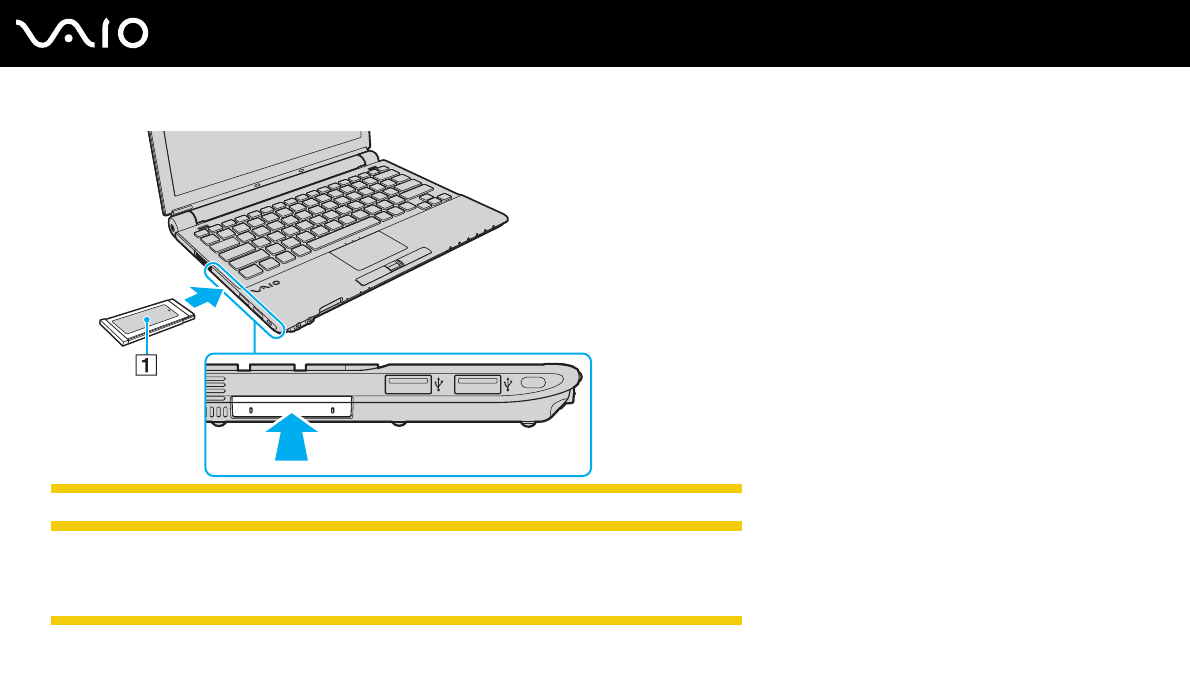
62
nN
Using Your VAIO Computer
IRX-3960_END
Except IRX-3960_BGN
!
Insert the ExpressCard slot protector to protect against debris entering the slot when not using an ExpressCard module. Before moving your computer,
be sure to insert the ExpressCard slot protector into the slot.
Except IRX-3960_END
✍
If the module or adapter does not go into the slot easily, remove it gently and verify you are inserting it in the proper direction.
Make sure you use the most recent software driver provided by the ExpressCard module manufacturer.

63
nN
Using Your VAIO Computer
Removing an ExpressCard Module
Follow the steps below to remove the ExpressCard module while your computer is on. If it is not removed properly, your
system may not work properly.
To remove an ExpressCard module
✍
To remove an ExpressCard module when your computer is off, skip steps 1 to 7.
1Double-click the Safely Remove Hardware icon on the taskbar.
The Safely Remove Hardware window appears.
2Select the hardware you want to unplug.
3Click Stop.
The Stop a Hardware device window appears.
4Confirm that the device can be safely removed from the system.
5Click OK.
A message appears stating it is now safe to remove the device.
6Click OK.
7Click Close to close the Safely Remove Hardware window.
8Push in the ExpressCard module toward the computer to pop it out.
9Gently take hold of the ExpressCard module and pull it out of the slot.

64
nN
Using Your VAIO Computer
Using the Memory Stick Media
Your computer supports the Memory Stick media. Memory Stick media is a compact, portable, and versatile IC recording
media especially designed for exchanging and sharing digital data with compatible products, such as digital cameras, mobile
phones and other devices. Because it is removable, it can be used for external data storage.
For the latest information about the Memory Stick media, visit the Memory Stick Web site at http://www.memorystick.com/en/.
!
Your computer has been tested and found compatible with the Sony branded Memory Stick media with capacity of up to 8 GB that are available as of
January 2007. However, not all Memory Stick media that meet the same conditions as the compatible media are guaranteed of compatibility.
Inserting a Memory Stick media with multiple conversion adapters is not guaranteed of compatibility.
MagicGate is the general name of the copyright protection technology developed by Sony. Use a Memory Stick media with the MagicGate logo to use
this feature.
IRX-3960_BGN
You cannot use a Memory Stick media if you select the option to disable the Memory Stick PRO/Duo media slot with the Peripheral Device & Storage
Media Restriction Setting Utility or power supply to the Memory Stick PRO/Duo media slot on the VAIO Power Management tab in the Power Options
window. To change the settings, see Protecting Data from Unauthorized Use (page 177) or Activating VAIO Power Management Power Schemes
(page 174).
IRX-3960_END
Inserting a Memory Stick Media
IRX-3960_BGN
To insert a Memory Stick media
1Locate the Memory Stick PRO/Duo media slot.
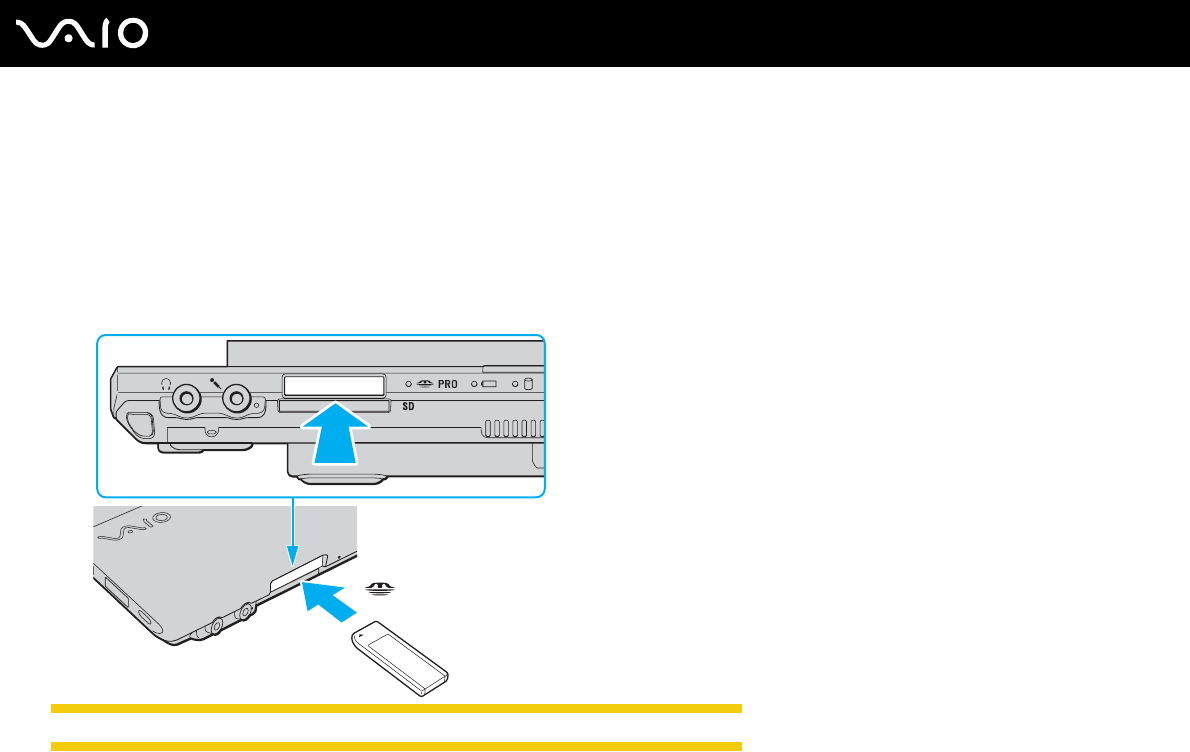
65
nN
Using Your VAIO Computer
2Push in the Memory Stick media slot protector toward the computer.
The protector ejects.
3Pull the protector out of the slot.
4Hold the Memory Stick media with the arrow facing upward and pointing toward the Memory Stick PRO/Duo media slot.
5Carefully slide the Memory Stick media into the slot until it clicks into place.
The Memory Stick media is automatically detected by your system and the content of the Memory Stick media is
displayed. If nothing appears on the desktop, click Start, Computer, and double-click the Memory Stick media icon.
IRX-3960_END
Except IRX-3960_BGN

66
nN
Using Your VAIO Computer
To insert a Memory Stick media
1Hold the Memory Stick media with the arrow facing upward and pointing toward the Memory Stick PRO/Duo media slot.
2Carefully slide the Memory Stick media into the slot until it clicks into place.
The Memory Stick media is automatically detected by your system and the content of the Memory Stick media is
displayed. If nothing appears on the desktop, click Start, Computer, and double-click the Memory Stick media icon.
Except IRX-3960_END
!
Be sure to hold the Memory Stick media with the arrow pointing in the correct direction as you insert it into the slot. To avoid damaging your computer
or the Memory Stick media, do not force the Memory Stick media into the slot if you cannot insert it smoothly.
Do not insert more than one Memory Stick media into the slot. Improper insertion of the media may damage both your computer and the media.
IRX-3960_BGN
Insert the Memory Stick media slot protector to protect against debris entering the slot when not using a Memory Stick media. Before moving your
computer, make sure to insert the Memory Stick media slot protector into the slot.
IRX-3960_END
✍
Your computer supports Memory Stick Duo media and is equipped with the Memory Stick PRO/Duo media slot that is compatible with both standard-
and duo-size media. For more information on the Memory Stick Duo media, visit the Memory Stick Web site at http://www.memorystick.com/en/.
You can insert a Memory Stick Duo media directly into the slot.
To view the contents of the Memory Stick media
1Click Start and Computer to open the Computer window.
2Double-click the Memory Stick media icon to view the list of data files saved in the Memory Stick media.

67
nN
Using Your VAIO Computer
To format a Memory Stick media
The Memory Stick media has been formatted in the factory default setting and is ready for use.
If you want to reformat the media with your computer, follow these steps.
!
Be sure to use the device that is designed to format the media and supports the Memory Stick media when formatting the media.
Formatting the Memory Stick media erases the entire data on the media. Avoid accidental erasure of your valuable data.
Do not remove the Memory Stick media from the slot while formatting the media. This could cause a malfunction.
1Carefully slide the Memory Stick media into the slot until it clicks into place.
2Click Start and Computer to open the Computer window.
3Right-click the Memory Stick media icon and select Format.
4Click Restore device defaults.
!
The size of the allocation unit and file system may change.
Do not select NTFS from the File system drop-down list.
✍
The formatting process will be completed more quickly if you select Quick Format in Format options.
5Click Start.
6At the confirmation prompt, click OK.
The formatting process starts.
!
It may take time to format the Memory Stick media depending on the media.
7Once completed, click OK.

68
nN
Using Your VAIO Computer
8Click Close.
Removing a Memory Stick Media
To remove a Memory Stick media
1Check that the Media Access indicator light is off.
2Push the Memory Stick media in toward the computer.
The Memory Stick media ejects.
3Pull the Memory Stick media out of the slot.
!
Always remove the Memory Stick media gently, or it may pop out unexpectedly.
Do not remove the Memory Stick media while the Media Access indicator light is turned on. If you do, you may lose data. Large volumes of data may
take time to load, so be sure the indicator is off before removing the Memory Stick media.
Using Other Memory Cards
In addition to the Memory Stick PRO/Duo media slot, your computer is equipped with an SD memory card slot to
accommodate other memory cards. You can use this slot to transfer data among digital cameras, camcorders, music players,
and other audio/video devices.
Before You Use Memory Cards
The SD memory card slot on your computer supports the following memory cards:
❑MultiMediaCard (MMC)
❑Secure Digital (SD)
For the latest information on compatible memory cards, visit the Sony online support Web site regularly.

69
nN
Using Your VAIO Computer
IRX-3960_BGN
!
Always insert the correct memory card into the SD memory card slot.
SD memory cards with capacity of up to 2 GB and SD High Capacity (SDHC) memory cards with capacity of up to 4 GB have been tested and found
compatible with your computer.
IRX-3960_END
Except IRX-3960_BGN
!
Always insert the correct memory card into the SD memory card slot.
SD memory cards with capacity of over 2 GB, such as SD High Capacity (SDHC) memory cards, are not supported.
Except IRX-3960_END
Do not attempt to insert a memory card or memory card adapter of a different type into the slot. An incompatible memory card or memory card adapter
may be difficult to remove from the slot and can cause damage to your computer.
Use care when inserting or removing a memory card from the slot. Do not force the memory card in or out of the slot.
IRX-3960_BGN
The SD memory card slot on your computer does not support the copyright protection and high-speed data transfer features of the SD memory card.
IRX-3960_END
Except IRX-3960_BGN
The SD memory card slot on your computer does not support the high-speed data transfer feature of the SD memory card.

70
nN
Using Your VAIO Computer
Except IRX-3960_END
Your computer has been tested and found compatible only with major memory card media available as of January 2007. However, not all memory card
media that meet the same conditions as the compatible media are guaranteed of compatibility.
IRX-3960_BGN
You cannot use a memory card if you select the option to disable the SD memory card slot with the Peripheral Device & Storage Media Restriction
Setting Utility or power supply to the SD memory card slot on the VAIO Power Management tab in the Power Options window. To change the settings,
see Protecting Data from Unauthorized Use (page 177) or Activating VAIO Power Management Power Schemes (page 174).
IRX-3960_END
Inserting a Memory Card
To insert a memory card
1Locate the SD memory card slot on the front of the computer.
2Hold the memory card with the arrow facing upward and pointing toward the memory card slot.
IRX-3960_BGN
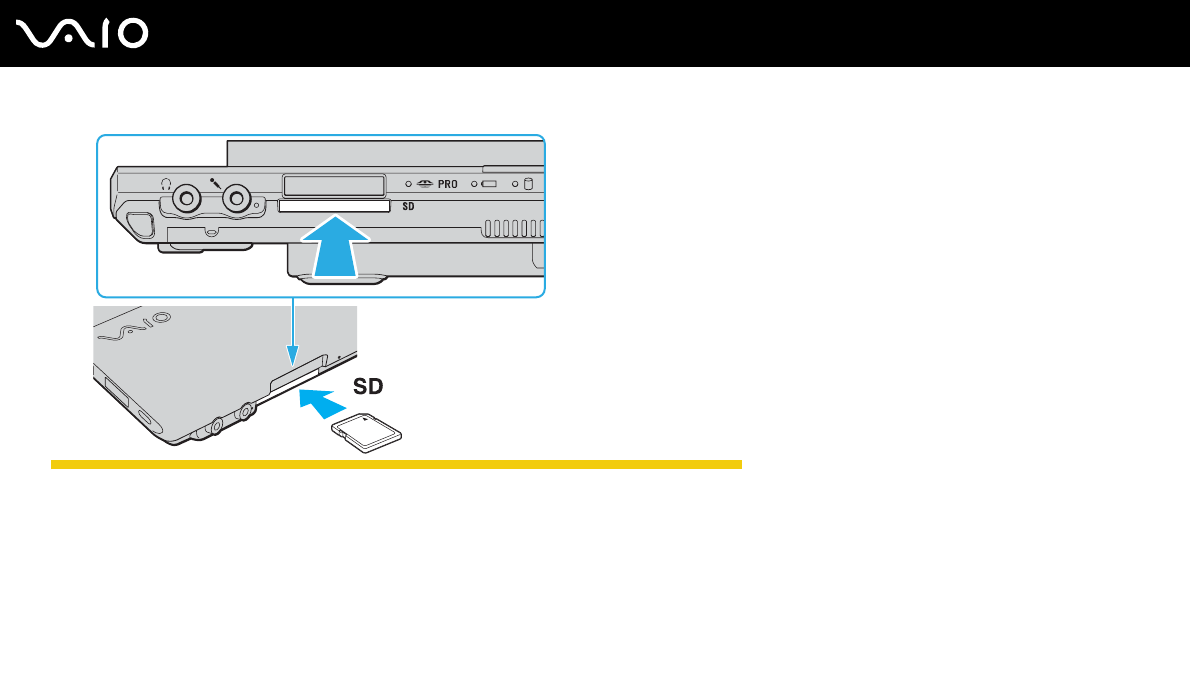
71
nN
Using Your VAIO Computer
IRX-3960_END
3Carefully slide the memory card into the slot until it clicks into place.
Do not force the card into the slot.
✍
If the memory card does not go into the slot easily, remove it gently and verify you are inserting it in the proper direction.
Removing a Memory Card
!
Do not remove a memory card while the Media Access indicator light is on. The card or its data may become damaged.
To remove a memory card
1Check that the Media Access indicator light is off.
2Press the extended part of the memory card, causing it to extend out from the slot.

72
nN
Using Your VAIO Computer
3When the card extends, carefully pull it out of the slot.
Using the Internet
Setting Up a Dial-up Internet Connection
Before you can connect to the Internet, you need to connect your computer to a telephone line with a telephone cable (not
supplied). Once you have set up your telephone cable connection, you are ready to connect to the Internet.
To connect a telephone cable
1Plug one end of the phone cable (1) into the modem port on the computer.
2Plug the other end into the wall jack (2).
✍
Your computer does not work with party lines, cannot be connected to a coin-operated telephone, and may not work with multiple telephone lines or a
private branch exchange (PBX). Some of these connections may result in excess electrical current and could cause a malfunction in the internal modem.
If you connect a telephone cable coming through a splitter, the modem or connected device may not work properly.
To set up a dial-up connection to the Internet
1Click Start and Control Panel
2Click Connect to the Internet under Network and Internet.
The Connect to the Internet window appears.

73
nN
Using Your VAIO Computer
3Click Dial-up.
4Follow the on-screen instructions.
Using Wireless LAN (WLAN)
Using the Sony Wireless LAN (WLAN), all your digital devices with built-in WLAN functionality communicate freely with each
other through a network. A WLAN is a network in which a user can connect to a Local Area Network (LAN) through a wireless
(radio) connection. So there is no need anymore to pull cables or wires through walls and ceilings.
The Sony WLAN supports all normal Ethernet activities, but with the added benefits of mobility and roaming. You can still
access information, Internet/intranet and network resources, even in the middle of a meeting, or as you move from one place
to another.
You can communicate without an access point, which means that you can communicate between a limited number of
computers (ad-hoc). Or you can communicate through an access point, which allows you to create a full infrastructure
network (infrastructure).
IRX-3960_BGN
US model_BGN
❑Wireless WAN model users
Please see the SmartWi Connection Utility Help for setting up wireless LAN and wireless WAN functionalities. For
instructions on how to access the SmartWi Connection Utility Help, see Non-printed Documentation (page 10).
❑Other model users
Please see the following for setting up wireless LAN functionality.
US model_END
IRX-3960_END
US model_BGN

74
nN
Using Your VAIO Computer
✍
In some countries, using WLAN products may be restricted by the local regulations (e.g. limited number of channels). Therefore, before activating the
WLAN functionality, read the Safety Information carefully.
US model_END
Euro model_BGN
✍
In some countries, using WLAN products may be restricted by the local regulations (e.g. limited number of channels). Therefore, before activating the
WLAN functionality, read the Regulations Guide carefully.
Euro model_END
Except Euro_BGN
Except US model_BGN
✍
In some countries, using WLAN products may be restricted by the local regulations (e.g. limited number of channels). Therefore, before activating the
WLAN functionality, read the Safety Regulations carefully.
Except US model_END
Except Euro_END
WLAN uses the IEEE 802.11a*/b/g/n* standard, which specifies the used technology. The standard includes the encryption methods: Wired Equivalent
Privacy (WEP), which is a security protocol, Wi-Fi Protected Access 2 (WPA2), and Wi-Fi Protected Access (WPA). Proposed jointly by the IEEE and
Wi-Fi Alliance, both WPA2 and WPA are specifications of standards based, interoperable security enhancements that increase the level of data
protection and access control for existing Wi-Fi networks. WPA has been designed to be forward compatible with the IEEE 802.11i specification. It
utilizes the enhanced data encryption TKIP (Temporal Key Integrity Protocol) in addition to user authentication using 802.1X and EAP (Extensible
Authentication Protocol). Data encryption protects the vulnerable wireless link between clients and access points. Besides that, there are other typical
LAN security mechanisms to ensure privacy, such as: password protection, end-to-end encryption, virtual private networks, and authentication. WPA2,
the second generation of WPA, provides stronger data protection and network access control and is also designed to secure all versions of 802.11

75
nN
Using Your VAIO Computer
devices, including 802.11b, 802.11a, 802.11g, and 802.11n, multi-band and multi-mode. In addition, based on the ratified IEEE 802.11i standard, WPA2
provides government grade security by implementing the National Institute of Standards and Technology (NIST) FIPS 140-2 compliant AES encryption
algorithm and 802.1X-based authentication. WPA2 is backward compatible with WPA.
Except China_BGN
Except GVD model_BGN
* See the online Specifications to see whether your model supports the IEEE 802.11a/n standard.
Except GVD model_END
Except China_END
Except Euro_BGN
Except US model_BGN
* See the printed Specifications sheet to see whether your model supports the IEEE 802.11a/n standard.
Except US model_END
Except Euro_END
IEEE 802.11b/g is a wireless LAN standard, using the 2.4 GHz bandwidth. The IEEE 802.11g standard provides high-speed communications, faster than
the IEEE 802.11b standard.
IEEE 802.11a is a wireless LAN standard, using the 5 GHz bandwidth, and provides high-speed communications of up to 54 Mbps.
IEEE 802.11n is a wireless LAN standard, using the 2.4 or 5 GHz bandwidth, and provides high-speed communications of up to 300 Mbps*.
* Actual communication speed varies depending on your access point settings and so on.
Your computer may employ the Intel® Next-Gen Wireless-N technology* compliant with the IEEE 802.11a/b/g standard and the draft form of the
IEEE 802.11n standard. The computer with the Intel® Next-Gen Wireless-N technology can connect only to an access point that supports the "Connect
with Intel® Centrino®" program, using the draft form of the IEEE 802.11n standard.

76
nN
Using Your VAIO Computer
Except China_BGN
Except GVD model_BGN
* See the online Specifications to see whether your model employs the Intel® Next-Gen Wireless-N technology.
Except GVD model_END
Except China_END
Except Euro_BGN
Except US model_BGN
* See the printed Specifications sheet to see whether your model employs the Intel® Next-Gen Wireless-N technology.
Except US model_END
Except Euro_END
Wireless LAN devices using the 2.4 GHz bandwidth and the ones using the 5 GHz bandwidth cannot communicate with each other because the
frequencies are different.
The 2.4 GHz bandwidth used by wireless LAN compatible devices is also used by other various devices. Although technologies to minimize interference
from other devices that use the same bandwidth are employed on wireless LAN compatible devices, such interference may cause lower communication
speed, narrower communication range, or broken wireless connections.
The communication speed varies depending on the distance between communication devices, existence of obstacles between such devices, the device
configuration, the radio conditions, and the software in use. In addition, communications may be cut off depending on the radio conditions.
The communication range varies depending on the actual distance between communication devices, existence of obstacles between such devices, the
radio conditions, the ambient environment that includes existence of walls and materials of such walls, and the software in use.
Deploying IEEE 802.11b and IEEE 802.11g products on the same wireless network may reduce the communication speed due to radio interference.
Taking this into consideration, the IEEE 802.11g products are designed to reduce the communication speed to ensure communications with
IEEE 802.11b products. When the communication speed is not as fast as expected, changing the wireless channel on the access point may increase
the communication speed.
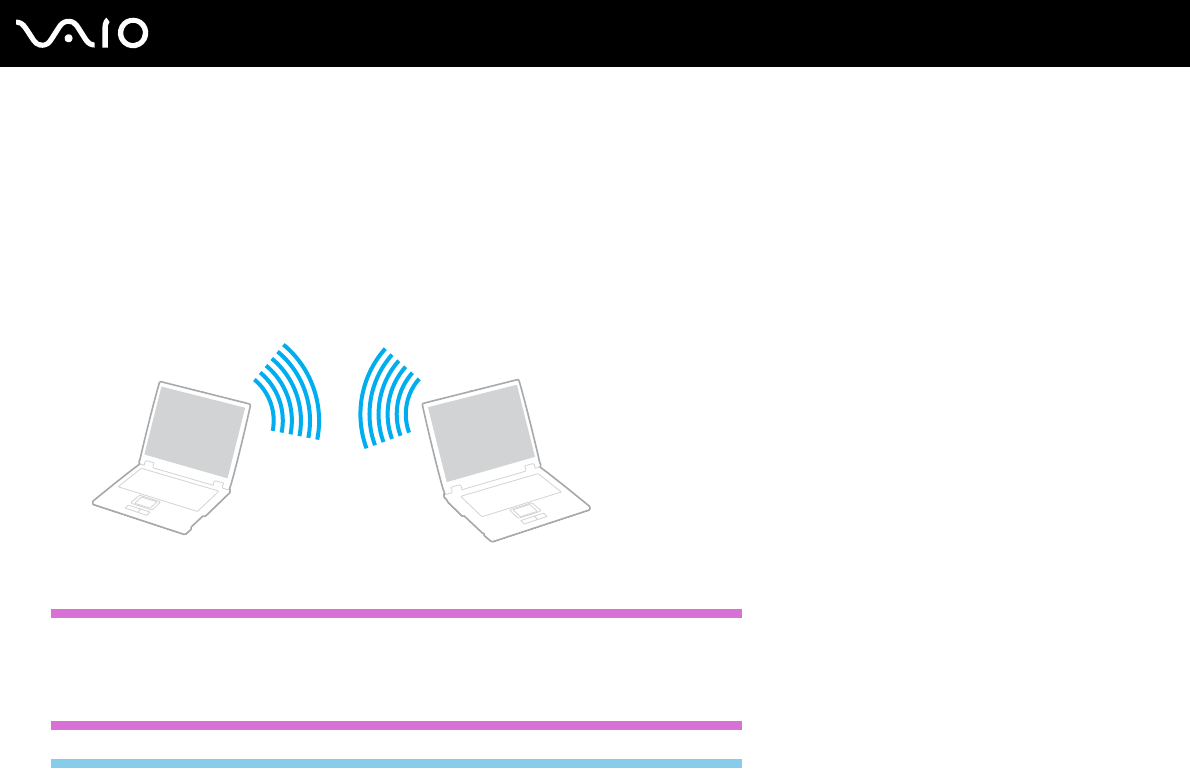
77
nN
Using Your VAIO Computer
Communicating without an Access Point (Ad-hoc)
An ad-hoc network is a network in which a local network is created only by the wireless devices themselves, with no other
central controller or access point. Each device communicates directly with other devices in the network. You can set up an
ad-hoc network easily at home.
❑If the wireless connection is initiated by the VAIO computer, channel 11 will be selected.
❑If the wireless connection is initiated by peer wireless LAN equipment, the wireless LAN communication will make use of
the channel selected by the peer wireless LAN equipment.
To communicate without an access point (ad-hoc)
US model_BGN
!
You cannot select the 5 GHz bandwidth, which is used for the IEEE 802.11a standard, on ad-hoc networks.
The IEEE 802.11n standard, using the 2.4 or 5 GHz bandwidth, is not available on ad-hoc networks.
US model_END
GVD model_BGN

78
nN
Using Your VAIO Computer
!
In Taiwan, Hong Kong, Malaysia, Australia, New Zealand, Saudi Arabia, India, Indonesia, Singapore, and the Philippines, you cannot select the 5 GHz
bandwidth, which is used for the IEEE 802.11a standard, on ad-hoc networks.
The IEEE 802.11n standard, using the 2.4 or 5 GHz bandwidth, is not available on ad-hoc networks.
GVD model_END
Except US model_BGN
Except GVD model_BGN
!
The IEEE 802.11n standard, using the 2.4 or 5 GHz bandwidth, is not available on ad-hoc networks.
Except GVD model_END
Except US model_END
Except IRX-3960_BGN
1Turn on the WIRELESS or WIRELESS LAN switch.
The Wireless LAN indicator lights up.
2Double-click ( / ) on the taskbar to display the Wireless Device Switch window. Select your desired wireless
option(s) and click OK.
Except IRX-3960_END
IRX-3960_BGN
Except Euro_BGN
1Turn on the WIRELESS switch.
The Wireless LAN indicator lights up.
2Double-click ( / ) on the taskbar to display the Wireless Device Switch window. Select your desired wireless
option(s) and click OK.

79
nN
Using Your VAIO Computer
Except Euro_END
Euro model_BGN
1Turn on the WIRELESS switch.
The Wireless LAN indicator lights up and the VAIO Smart Network window appears.
If the VAIO Smart Network window does not appears, follow these steps:
1Click Start, All Programs, and VAIO Control Center.
2Double-click Network Connections and VAIO Smart Network.
✍
For information on the VAIO Smart Network software, see the help file on the software.
2Click the button next to your desired wireless option.
Euro model_END
IRX-3960_END
3Click Start and Control Panel.
4Click View network status and tasks under Network and Internet.
5Click Set up a connection or network on the left pane.
The Set up a connection or network window appears.
6Select an option to specify the ad-hoc network settings and click Next.
7Follow the on-screen instructions.
Except GVD model_BGN
Except China_BGN
✍
See the online Specifications to see whether your model supports the Bluetooth functionality and/or the IEEE 802.11a/b/g/n standard.

80
nN
Using Your VAIO Computer
Except China_END
Except GVD model_END
Except US model_BGN
Except Euro_BGN
✍
See the printed Specifications sheet to see whether your model supports the Bluetooth functionality and/or the IEEE 802.11a/b/g/n standard.
Except Euro_END
Except US model_END
Communicating with an Access Point (Infrastructure)
An infrastructure network is a network that extends an existing wired local network to wireless devices by providing an access
point (not supplied), for example the Sony Access Point. The access point bridges the wireless and wired LAN and acts as a
central controller for the wireless LAN. The access point coordinates transmission and reception from multiple wireless
devices within a specific range.
The access point will select which channel to use on an infrastructure network.
!
For details on how to select the channel that will be used by the access point, see the manual that came with your access point.
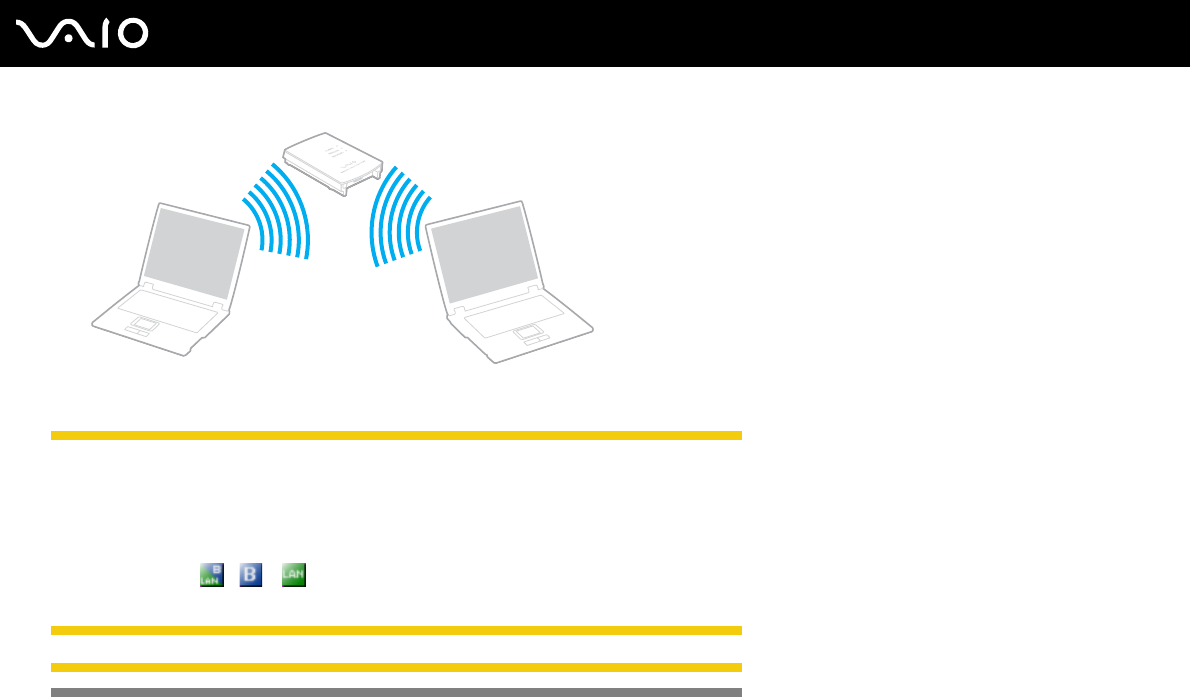
81
nN
Using Your VAIO Computer
To connect to a wireless network
Except IRX-3960_BGN
1Make sure an access point is set up.
See the manual that came with your access point for more information.
2Turn on the WIRELESS or WIRELESS LAN switch.
The Wireless LAN indicator lights up.
3Double-click ( / ) on the taskbar to display the Wireless Device Switch window. Select your desired wireless
option(s) and click OK.
Except IRX-3960_END
IRX-3960_BGN
Except Euro_BGN
1Make sure an access point is set up.
See the manual that came with your access point for more information.

82
nN
Using Your VAIO Computer
2Turn on the WIRELESS switch.
The Wireless LAN indicator lights up.
3Double-click ( / ) on the taskbar to display the Wireless Device Switch window. Select your desired wireless
option(s) and click OK.
Except Euro_END
Euro model_BGN
1Make sure an access point is set up.
See the manual that came with your access point for more information.
2Turn on the WIRELESS switch.
The Wireless LAN indicator lights up and the VAIO Smart Network window appears.
If the VAIO Smart Network window does not appears, follow these steps:
1Click Start, All Programs, and VAIO Control Center.
2Double-click Network Connections and VAIO Smart Network.
✍
For information on the VAIO Smart Network software, see the help file on the software.
3Click the button next to your desired wireless option.
Euro model_END
IRX-3960_END
4Right-click or on the taskbar and select Connect to a network.
5Select the desired access point and click Connect.
Except GVD model_BGN
Except China_BGN

83
nN
Using Your VAIO Computer
✍
See the online Specifications to see whether your model supports the Bluetooth functionality and/or the IEEE 802.11a/b/g/n standard.
Except China_END
Except GVD model_END
Except US model_BGN
Except Euro_BGN
✍
See the printed Specifications sheet to see whether your model supports the Bluetooth functionality and/or the IEEE 802.11a/b/g/n standard.
Except Euro_END
Except US model_END
To disconnect from a wireless network
Turn off the WIRELESS or WIRELESS LAN switch.
!
Turning off the wireless LAN functionality while accessing remote documents, files, or resources may result in data loss.
✍
For WPA-PSK or WPA2-PSK authentication, you must enter a passphrase. The passphrase is case sensitive and must be between 8 and 63
alphanumeric characters long or up to 64 characters long using numbers from 0 to 9 and letters from A to F.
Using the Bluetooth Functionality
Except IRX-3960_BGN
Except China_BGN
Except GVD model_BGN
The Bluetooth functionality is available on selected models only. See the online Specifications to see whether your model
supports the Bluetooth functionality.

84
nN
Using Your VAIO Computer
Except GVD model_END
Except China_END
Except Euro_BGN
Except US model_BGN
The Bluetooth functionality is available on selected models only. See the printed Specifications sheet to see whether your
model supports the Bluetooth functionality.
Except US model_END
Except Euro_END
Except IRX-3960_END
US model_BGN
You can establish wireless communication between your computer and other Bluetooth devices such as another computer
or a mobile phone. You can transfer data between these devices without cables and up to 33 feet (10 meters) range in open
space.
IRX-3960_BGN
❑Wireless WAN model users
Please see the SmartWi Connection Utility Help for setting up Bluetooth functionality. For instructions on how to access
the SmartWi Connection Utility Help, see Non-printed Documentation (page 10).
❑Other model users
Please see the following for setting up Bluetooth functionality.
IRX-3960_END
US model_END
Except US model_BGN
You can establish wireless communication between your computer and other Bluetooth devices such as another computer
or a mobile phone. You can transfer data between these devices without cables and up to 10 meters range in open space.

85
nN
Using Your VAIO Computer
Except US model_END
To connect to a Bluetooth device
Except IRX-3960_BGN
1Turn on the WIRELESS switch.
2Double-click ( / ) on the taskbar to display the Wireless Device Switch window.
3Select the Enable Bluetooth Device option.
4Click OK.
Except IRX-3960_END
IRX-3960_BGN
Euro model_BGN
1Turn on the WIRELESS switch.
The Wireless LAN indicator lights up and the VAIO Smart Network window appears.
If the VAIO Smart Network window does not appears, follow these steps:
1Click Start, All Programs, and VAIO Control Center.
2Double-click Network Connections and VAIO Smart Network.
✍
For information on the VAIO Smart Network software, see the help file on the software.
2Click the button next to your desired wireless option.
3Click OK.
Euro model_END
Except Euro_BGN
1Turn on the WIRELESS switch.

86
nN
Using Your VAIO Computer
2Double-click ( / ) on the taskbar to display the Wireless Device Switch window.
3Select the Enable Bluetooth Device option.
4Click OK.
Except Euro_END
IRX-3960_END
Notes on using the Bluetooth functionality
❑The data transfer rate varies, depending on the following conditions:
❑Obstacles, such as walls, located between devices
❑Distance between devices
❑Material used in walls
❑Proximity to microwaves and cordless telephones
❑Radio frequency interference and other environmental conditions
❑Device configuration
❑Type of software application
❑Type of operating system
❑Use of both wireless LAN and Bluetooth functionalities at the same time on your computer
❑Size of file being exchanged
❑Note that due to limitations of the Bluetooth standard, large files may occasionally be corrupted during continuous transfer
due to electromagnetic interference from the environment.

87
nN
Using Your VAIO Computer
❑All Bluetooth devices must be certified to make sure that the applicable standard requirements are maintained. Even if
standards are met, individual device performance, specifications, and operation procedures can vary. Data exchange may
not be possible in all situations.
❑As general characteristics of Bluetooth technology, video and audio may go out of synchronization if you play videos on
your computer with audio output from the connected Bluetooth device.
❑The 2.4 GHz band, with which Bluetooth devices or wireless LAN devices work, is used by various devices. Bluetooth
devices use the technology to minimize the interference from other devices that use the same wave length. Simultaneous
use of the Bluetooth functionality and wireless communication devices, however, may cause radio interference and result
in poorer communication speeds and distances than the standard values.
Euro model_BGN
✍
Read the Regulations Guide before using the Bluetooth functionality.
Euro model_END
❑The Bluetooth functionality may not work depending on the third party devices or the software version used by third party
companies.
❑As general characteristics of Bluetooth technology, connecting multiple Bluetooth devices to your computer may cause
bandwidth congestion, resulting in poor performance of the devices.
Bluetooth Security
The Bluetooth wireless technology has an authentication function, which allows you to determine with whom you choose to
communicate. With the authentication function, you can avoid any anonymous Bluetooth device to access your computer.
The first time two Bluetooth devices communicate, a common passkey (a password required for authentication) should be
determined for both devices to be registered. Once a device is registered, there is no need to re-enter the passkey.

88
nN
Using Your VAIO Computer
✍
The passkey can be different each time, but must be the same at both ends.
For certain devices, such as a mouse, no passkey can be entered.
Communicating with Another Bluetooth Device
You can connect your computer to a Bluetooth device such as another computer, a mobile phone, a PDA, a headset, a
mouse, or a digital camera without the use of any cables.

89
nN
Using Your VAIO Computer
To communicate with another Bluetooth device
To communicate with another Bluetooth device, you need first to set up the Bluetooth functionality. For setting up and using
the Bluetooth functionality, see the help file on the Bluetooth utility software.
To see the help file
1Right-click the Bluetooth icon on the taskbar, and select Help from the menu.
Stopping the Bluetooth Connection
To stop the Bluetooth connection, turn off the WIRELESS switch. The Bluetooth indicator turns off.
Using the Bluetooth Headset
The Bluetooth headset (not supplied) will come in handy during a video conference over the Internet using instant messaging
software. For details on using the Bluetooth headset, see the manual that came with your Bluetooth headset.
To connect the headset with your computer
1Press and hold the headset power button for at least five seconds to turn on the Bluetooth headset.
2Press and hold the volume buttons for at least five seconds until the indicator light blinks in red and green.
3Right-click the Bluetooth icon on the taskbar and select Bluetooth Settings from the menu.
The Bluetooth Settings window appears and Add New Connection Wizard automatically starts.
4If the Add New Connection Wizard window does not appear, click New Connection.
The Add New Connection Wizard window appears.
5Select Express Mode (Recommended) and then click Next.
The wizard searches for Bluetooth devices in range and lists available devices, if any.

90
nN
Using Your VAIO Computer
6Select the device name for your Bluetooth headset and then click Next.
The Bluetooth Manager-Bluetooth Security window appears when a connection is established.
7Enter "0000" for Bluetooth Passkey (PIN) and then click OK.
8Click Next.
The headset icon appears in the Bluetooth Settings window.
9Right-click the icon and select Connect from the menu.
To disconnect the headset from your computer
1Right-click the Bluetooth icon on the taskbar and select Bluetooth Settings from the menu.
The Bluetooth Settings window appears.
2Right-click the headset icon and select Disconnect from the menu.
3Click Yes.

91
nN
Using Peripheral Devices
Using Peripheral Devices
You can add functionality to your VAIO computer by using the various ports on the computer.
❑Connecting a Docking Station (page 91)
❑Connecting External Speakers (page 99)
❑Connecting an External Display (page 100)
❑Selecting Display Modes (page 105)
❑Using the Multiple Monitors Function (page 107)
❑Connecting an External Microphone (page 109)
❑Connecting a Universal Serial Bus (USB) Device (page 110)
❑Connecting a Printer (page 112)
❑Connecting an i.LINK Device (page 113)
❑Connecting to a Network (LAN) (page 115)
Connecting a Docking Station
Attaching a docking station enables you to connect additional peripherals to your computer, such as a printer and an external
display.
A docking station is not supplied with your computer and is available as an optional accessory.
Locating Ports on the Docking Station
IRX-3960_BGN
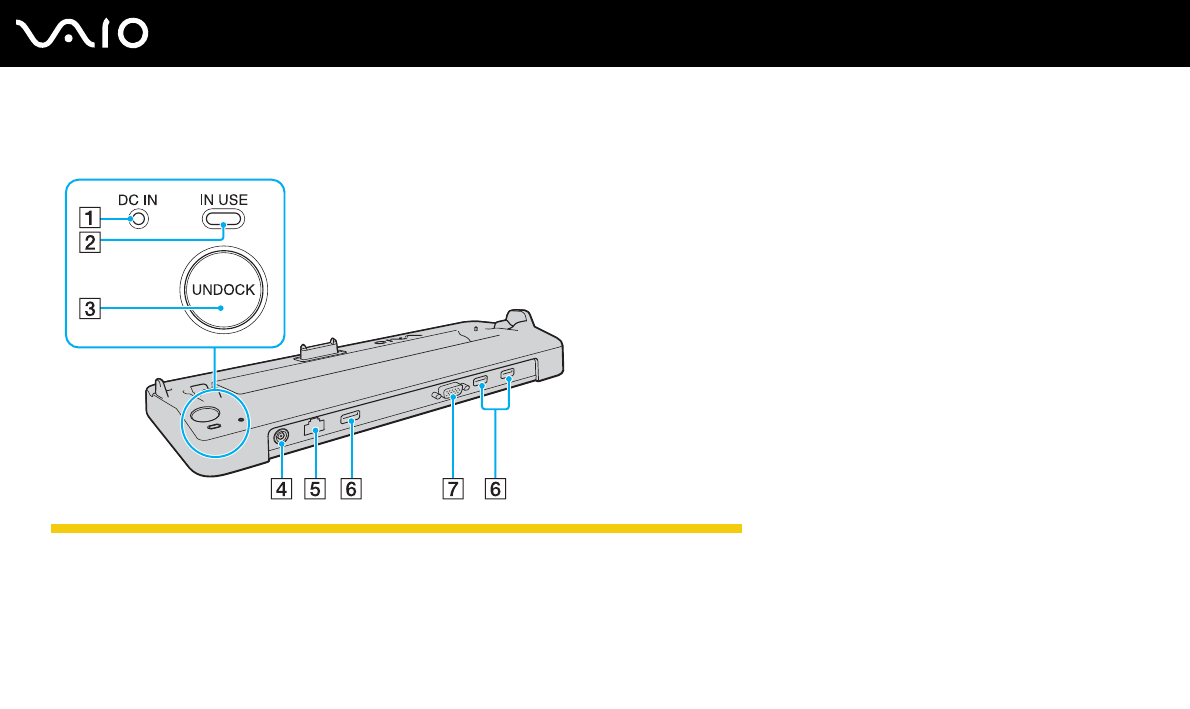
92
nN
Using Peripheral Devices
Back
IRX-3960_END
!
The docking station can be powered only through the AC adapter supplied with your computer. Do not unplug the AC adapter from the docking station
and the AC outlet while using the docking station; this may cause data damage or hardware malfunctions.
Attaching Your Computer to the Docking Station
!
When your computer has no battery pack installed, do not attach the computer to the docking station.
ADC IN indicator
Illuminates when the docking station is powered.
BIN USE indicator (page 96)
CUNDOCK button (page 96)
DDC IN port (page 92)
ENetwork (Ethernet) port (1000BASE-T / 100BASE-TX /
10BASE-T) (page 115)
FHi-Speed USB (USB 2.0) ports* (page 110)
GMONITOR (VGA) port (page 100)
* Supports high-/full-/low- speeds.

93
nN
Using Peripheral Devices
To attach your computer to the docking station
!
Use the AC adapter supplied with your computer.
To prevent loss of unsaved data, be sure to turn off your computer before attaching it to the docking station.
Do not move your computer while attached to the docking station; this may detach the docking station and cause damage to both units.
1Disconnect all peripherals from the computer.
2Plug one end of the power cord (1) into the AC adapter (2) and the other end into an AC outlet.
3Plug the cable attached to the AC adapter (2) into the DC IN port (3) on the docking station (4).
IRX-3960_BGN
IRX-3960_END
4Slide open the docking station connector cover on the bottom of the computer.
IRX-3960_BGN

96
nN
Using Peripheral Devices
Disconnecting Your Computer from the Docking Station
!
To prevent loss of unsaved data, be sure to turn off your computer before disconnecting it from the docking station.
Be sure that no devices connected to the docking station are in use before disconnecting your computer.
Do not disconnect your computer from the docking station when the IN USE indicator is lit. Disconnecting the computer while the IN USE indicator is
lit may result in loss of unsaved data or a failure of the computer.
When the battery pack is running out of power, disconnecting your computer from the docking station may result in loss of unsaved data.
Do not disconnect your computer from the docking station during video playback. Be sure to close video playback software before disconnection.
Once you have completed the steps in To disconnect your computer from the docking station (page 96), make sure to place your computer off the
docking station. Use of the computer still on the docking station may cause unstable operations.
To disconnect your computer from the docking station
1Press the UNDOCK button (1) and wait until the IN USE indicator (2) turns off.
IRX-3960_BGN
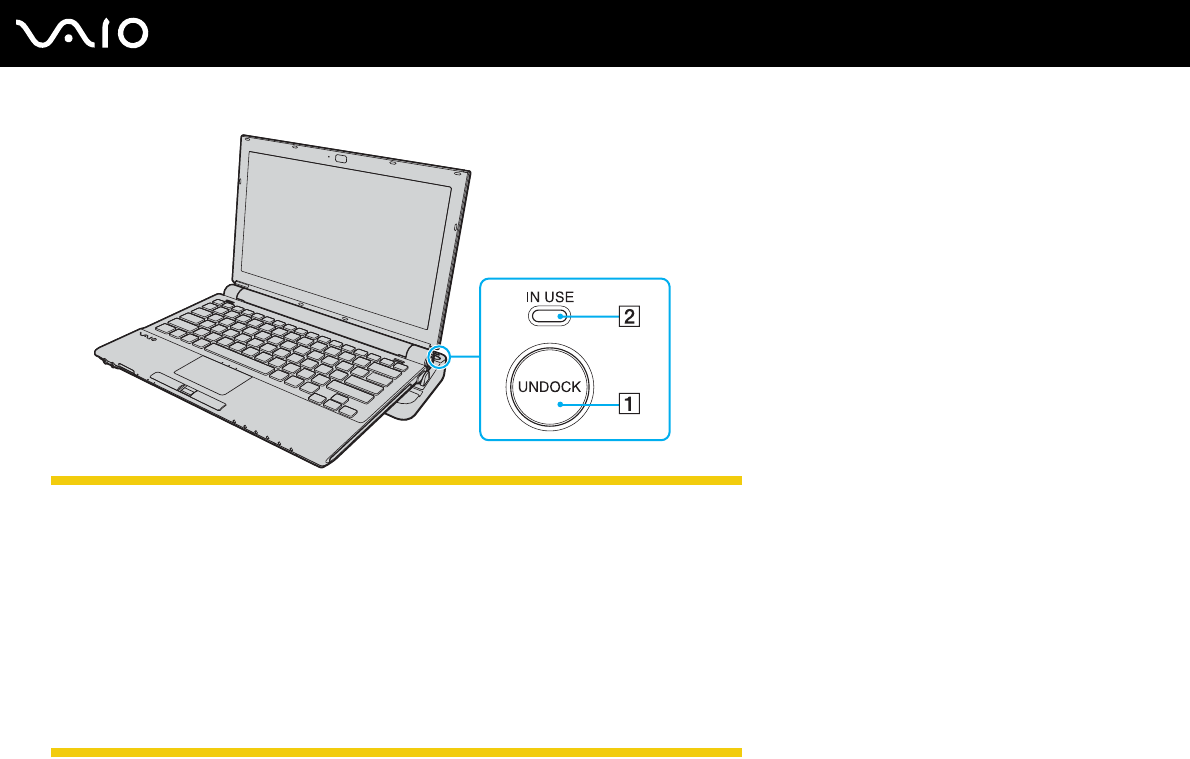
97
nN
Using Peripheral Devices
IRX-3960_END
✍
If the IN USE indicator is unlit, you do not have to press the UNDOCK button.
Pressing the UNDOCK button while your computer is in a power saving mode returns the computer to Normal mode first, and then initiates the
disconnection process.
!
Once you have placed your computer back in Normal mode, make sure to place your computer off the docking station. Use of the computer still on the
docking station may cause unstable operations.
2Lift the computer away from the docking station.
IRX-3960_BGN
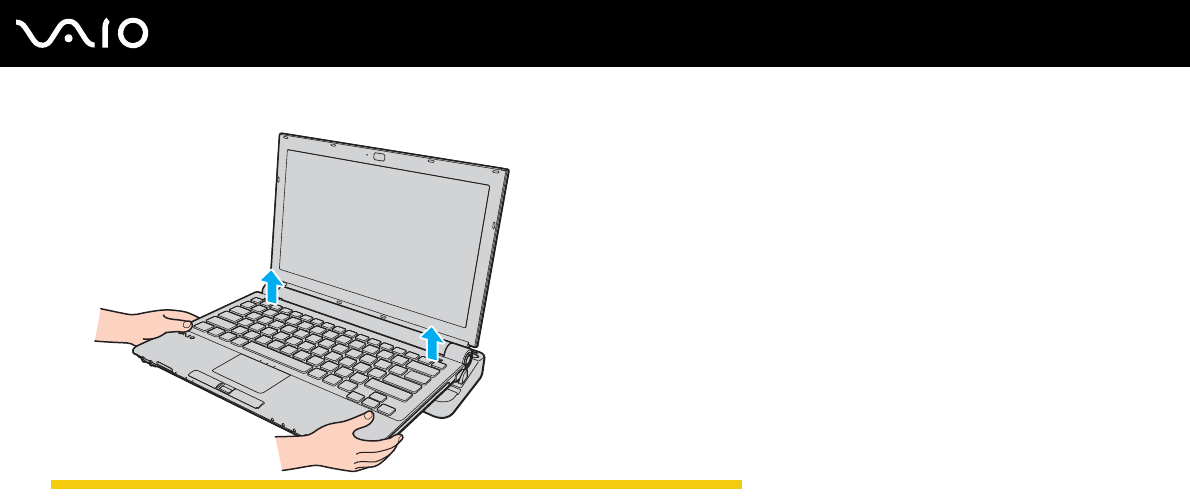
98
nN
Using Peripheral Devices
IRX-3960_END
3Close the docking station connector cover on the bottom of the computer.
Alternatively, you can disconnect the computer from the docking station as follows:
1Click Start and Undock Computer.
2Make sure that a message balloon appears and the IN USE indicator turns off; and then lift the computer away from the
docking station.
3Close the docking station connector cover on the bottom of the computer.
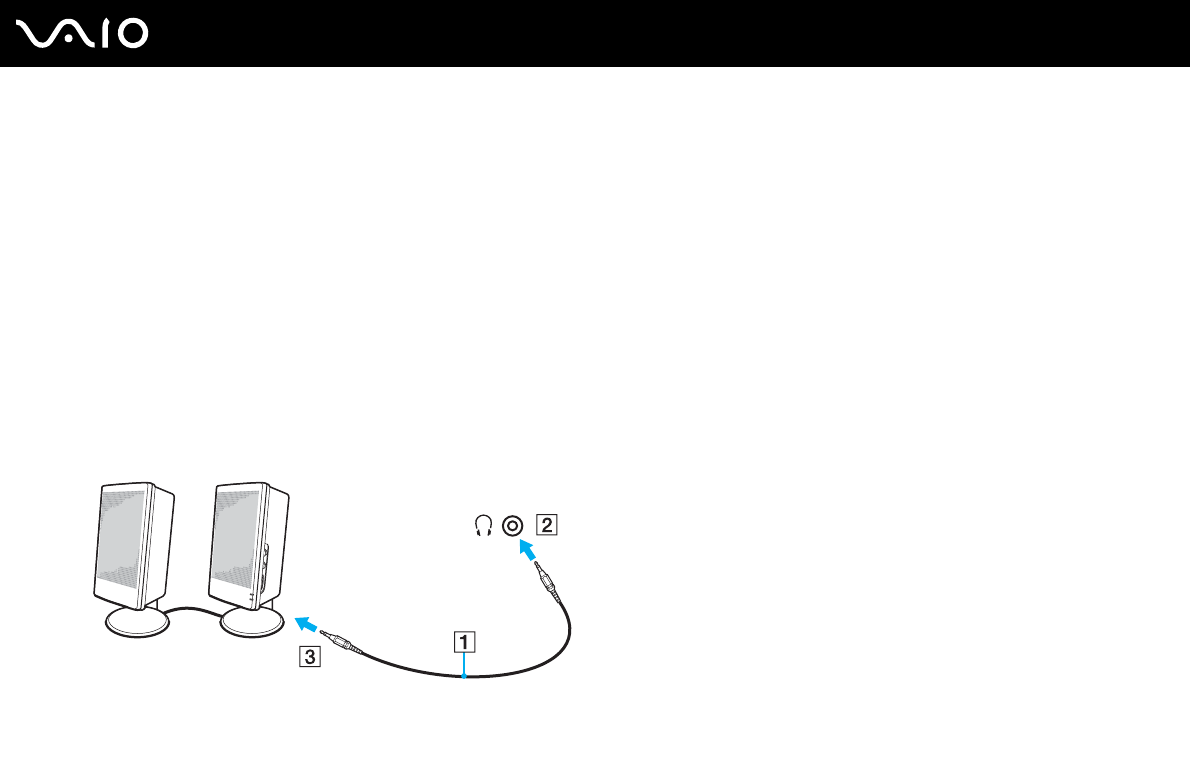
99
nN
Using Peripheral Devices
✍
It is extremely important to close the docking station connector cover after disconnecting your computer from the docking station. If the cover is left
open, dust may get inside and damage the computer.
To disconnect the docking station completely from AC power, unplug the AC adapter.
Connecting External Speakers
You can enhance the sound quality of your computer by connecting external speakers.
To connect external speakers
1Plug the speaker cable (1) into the headphones jack (2) i.
2Plug the other end of the speaker cable to the external speaker (3).
3Turn down the volume of the speakers before you turn them on.
✍
Make sure your speakers are designed for computer use.
!
Do not place floppy disks on the speakers; their magnetic field may damage the data on the disks.

100
nN
Using Peripheral Devices
Connecting an External Display
You can connect an external display (not supplied) to your computer. For example, you can use the computer with a computer
display or a projector.
✍
Connect the power cord after connecting all other cables.
Connected external displays are used as secondary screens.
On the Windows operating system, you can also use an external display to set up multiple monitors.
Connecting a Computer Display
Except IRX-3960_BGN
You can connect a computer display (monitor) either directly to your computer or via the (optional) port replicator.
Except IRX-3960_END
IRX-3960_BGN
You can connect a computer display (monitor) either directly to your computer or via the optional docking station.
IRX-3960_END
To connect a computer display
IRX-3960_BGN
!
The monitor (VGA) port on your computer is not accessible when the computer is attached to the docking station.
1If necessary, plug one end of the display's power cord (1) into your display, and the other end into an AC outlet.
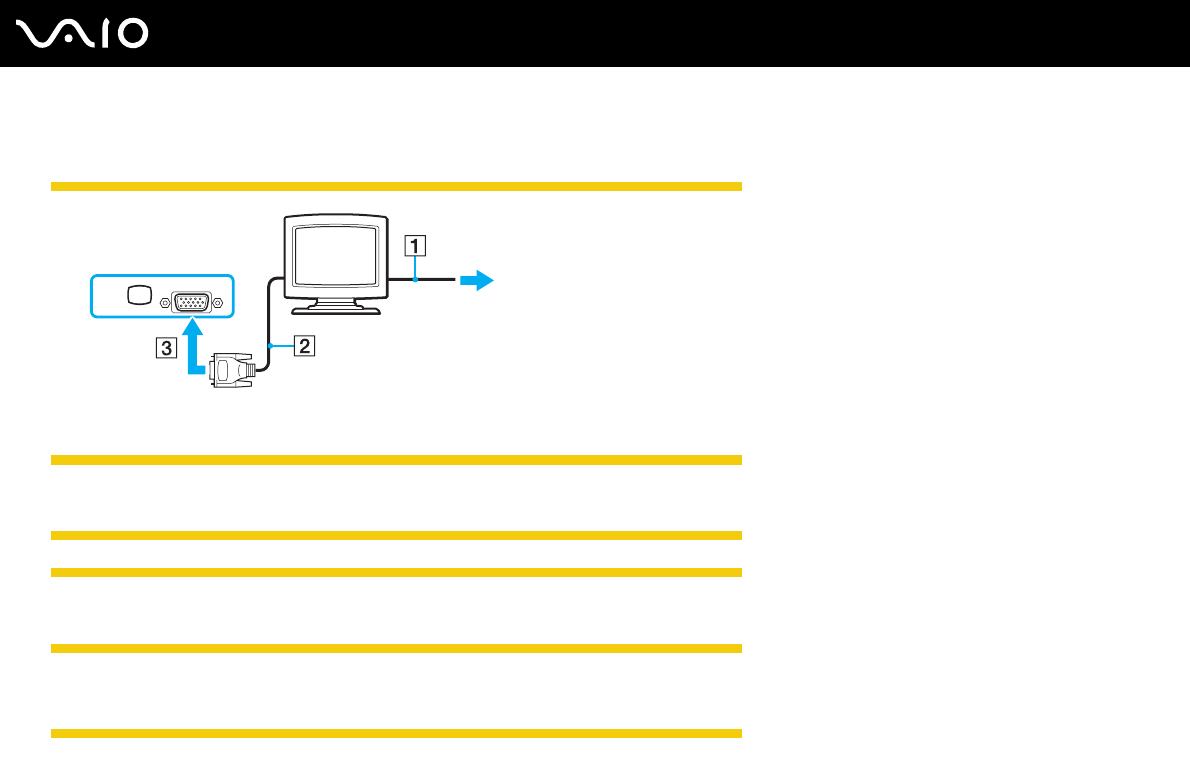
101
nN
Using Peripheral Devices
2If you want to connect a VGA monitor, plug the display cable (2) (not supplied) into the monitor (VGA) port (3) a on the
computer or on the docking station.
IRX-3960_END
Connecting a Multimedia Computer Display
Except IRX-3960_BGN
You can connect a multimedia computer display that includes built-in speakers and a microphone directly to your computer
or via the (optional) port replicator.
Except IRX-3960_END
IRX-3960_BGN
You can connect a multimedia computer display that includes built-in speakers and a microphone directly to your computer
or via the optional docking station.
IRX-3960_END
To connect a multimedia computer display
IRX-3960_BGN
!
The monitor (VGA) port on your computer is not accessible when the computer is attached to the docking station.

102
nN
Using Peripheral Devices
IRX-3960_END
1Plug the power cord of your multimedia computer display (1) into an AC outlet.
Except IRX-3960_BGN
2Plug the display cable (2) (not supplied) into the monitor (VGA) port (3) a on the computer or on the port replicator.
Except IRX-3960_END
IRX-3960_BGN
3Plug the display cable (2) (not supplied) into the monitor (VGA) port (3) a on the computer or on the docking station.
IRX-3960_END
4Plug the speaker cable (4) into the headphones jack (5) i on the computer.
5Plug the microphone cable (6) into the microphone jack (7) m on the computer.
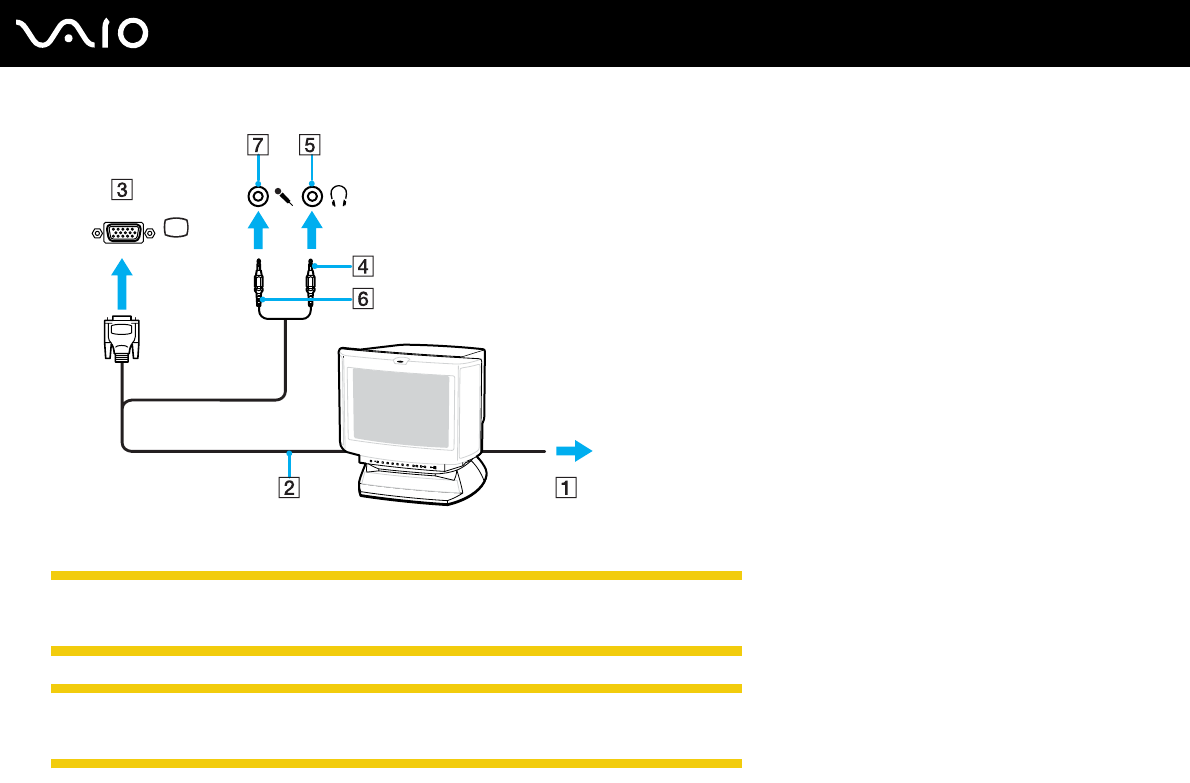
103
nN
Using Peripheral Devices
Connecting a Projector
Except IRX-3960_BGN
You can connect a projector (for example, the Sony LCD projector) directly to your computer or via the (optional) port
replicator.
Except IRX-3960_END
IRX-3960_BGN
You can connect a projector (for example, the Sony LCD projector) directly to your computer or via the optional docking
station.
IRX-3960_END

104
nN
Using Peripheral Devices
To connect a projector
IRX-3960_BGN
!
The monitor (VGA) port on the computer is not accessible when the computer is attached to the docking station.
IRX-3960_END
1Connect the power cord (1) of your projector into an AC outlet.
Except IRX-3960_BGN
2Plug an RGB signal cable (2) (not supplied) into the monitor (VGA) port (3) a on the computer or on the port replicator.
Except IRX-3960_END
IRX-3960_BGN
3Plug an RGB signal cable (2) (not supplied) into the monitor (VGA) port (3) a on the computer or on the docking station.
IRX-3960_END
4Plug an audio cable (4) (not supplied) into the headphones jack (5) i on the computer.
5Plug the RGB signal cable and the audio cable into the jack and port on the projector (6).
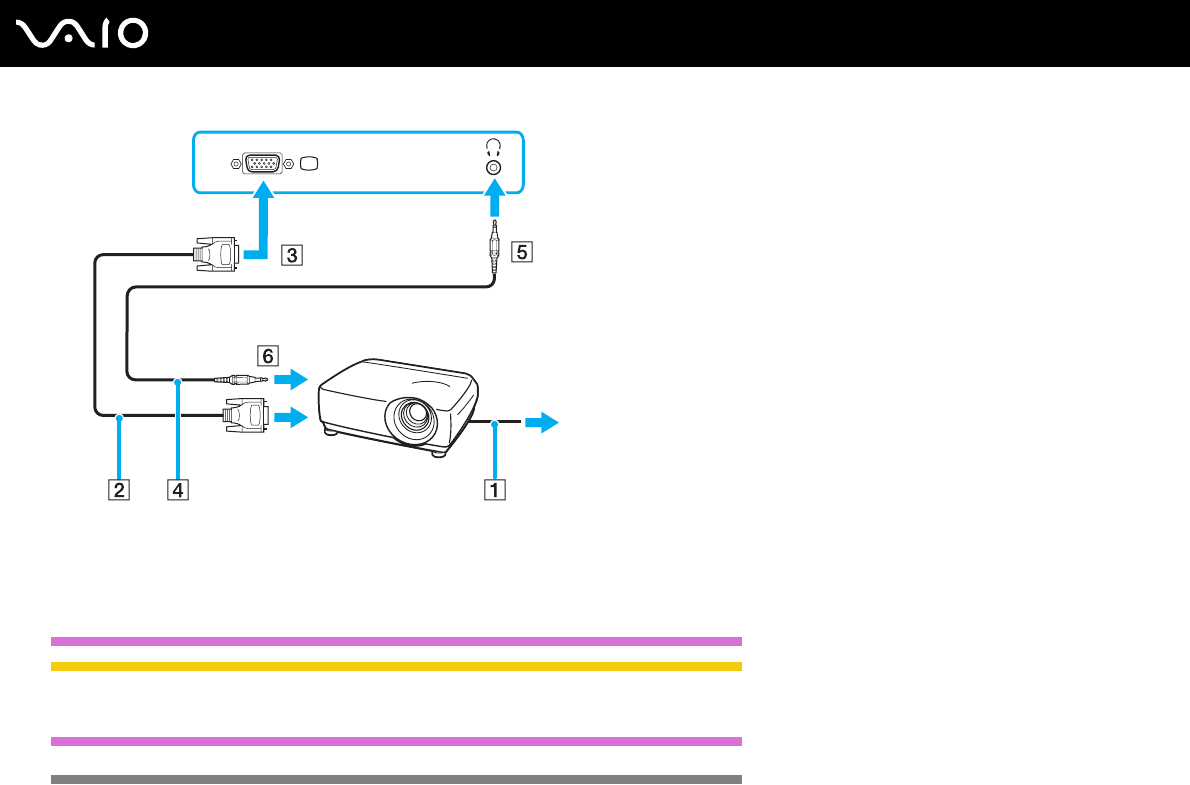
105
nN
Using Peripheral Devices
Selecting Display Modes
You can select which display to be used as the primary monitor when an external display (desktop monitor, etc.) is connected
to your computer.
US model_BGN
Except IRX-3960_BGN
The procedure for selecting a display depends on the video controller used in the computer. See the online Specifications
for detailed information on the video controller.
US model_END
Euro model_BGN

106
nN
Using Peripheral Devices
The procedure for selecting a display depends on the video controller used in the computer. See the online Specifications
for detailed information on the video controller.
Euro model_END
GVD model_BGN
The procedure for selecting a display depends on the video controller used in the computer. See the printed Specifications
sheet for detailed information on the video controller.
GVD model_END
China model_BGN
The procedure for selecting a display depends on the video controller used in the computer. See the printed Specifications
sheet for detailed information on the video controller.
China model_END
Except IRX-3960_END
If you want to work on your computer screen and the external display at the same time, see Using the Multiple Monitors
Function (page 107) for more information.
To select a display
IRX-3960_BGN
!
The monitor (VGA) port on your computer is not accessible when the computer is attached to the docking station.
1Right-click on the desktop and select Personalize from the shortcut menu.
2Click Display Settings.
The Display Settings window appears.
3Follow the on-screen instructions to change the settings.

107
nN
Using Peripheral Devices
✍
You may not be able to display the same contents on your computer screen and the external display or projector at the same time, depending on the
type of your external display or projector.
Before turning on your computer, turn on the peripheral devices.
IRX-3960_END
Using the Multiple Monitors Function
The Multiple Monitors function allows you to distribute portions of your desktop across separate displays. For example, if you
have an external display attached to the monitor (VGA) port, your computer screen and the external display can function as
a single desktop.
You can move the cursor from one display to the other. This allows you to drag objects, such as an open application window
or a toolbar, from one display to the other.

108
nN
Using Peripheral Devices
✍
Your external display may not support the Multiple Monitors function.
Certain software applications may not be compatible with Multiple Monitors settings.
Make sure that your computer does not enter Sleep or Hibernate mode while you are using Multiple Monitors mode; otherwise the computer may not
return to Normal mode.
If you set different colors on each display, do not expand a single window across two displays; otherwise your software may not work properly.
Set fewer colors or a lower resolution for each display.
To select the Multiple Monitors mode
IRX-3960_BGN
!
The monitor (VGA) port on your computer is not accessible when the computer is attached to the docking station.
1Right-click on the desktop and select Personalize from the shortcut menu.
2Click Display Settings.
The Display Settings window appears.
3Follow the on-screen instructions to change the settings.
Except China_BGN
✍
Additionally, you can set the display colors and resolution for each display and customize the Multiple Monitors mode.
Except China_END
China model_BGN
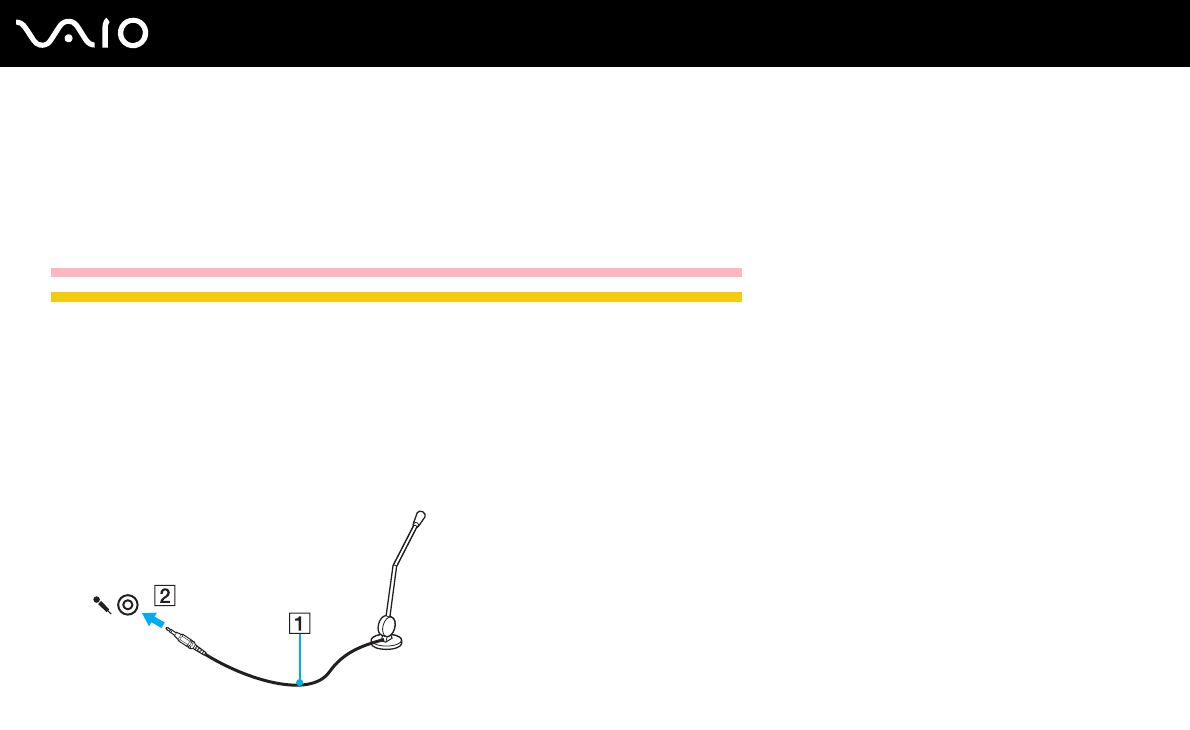
109
nN
Using Peripheral Devices
✍
On models without the built-in optical disc drive, you can also change the S button assignment to activate the Multiple Monitors mode with the S button.
To change the S button assignment, press and hold the S button to display the window for changing the assignment. For details on the S button, see
Using Special-function Buttons (page 45).
Additionally, you can set the display colors and resolution for each display and customize the Multiple Monitors mode.
China model_END
IRX-3960_END
Connecting an External Microphone
If you need to use a sound input device (for example, to chat over the Internet) you need to plug in an external microphone
(not supplied).
To connect an external microphone
Plug the microphone cable (1) into the microphone jack (2) m.
✍
Make sure your microphone is designed for computer use.
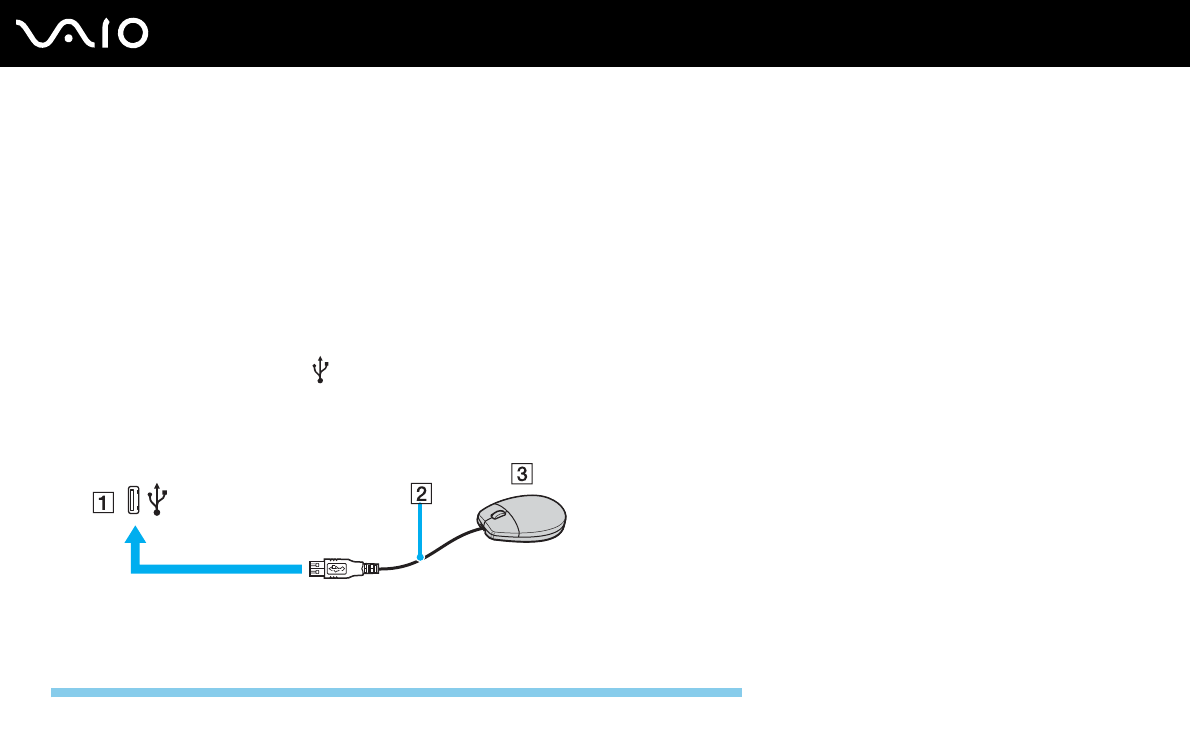
110
nN
Using Peripheral Devices
Connecting a Universal Serial Bus (USB) Device
To prevent your computer and/or USB devices from damage, observe the following:
❑When moving the computer with USB devices connected, avoid any shock or force to the USB ports.
❑Do not put the computer into a bag or carrying case when it has USB devices connected.
Connecting a USB Mouse
To connect a USB mouse
1Choose the USB port (1) you prefer to use.
2Plug the USB mouse cable (2) into the USB port.
You can now use your USB mouse (not supplied) (3).
Connecting a USB Floppy Disk Drive
You can purchase a USB floppy disk drive and connect it to your computer.
GVD model_BGN
✍
The optional USB floppy disk drive may not be available, depending on your country or region.
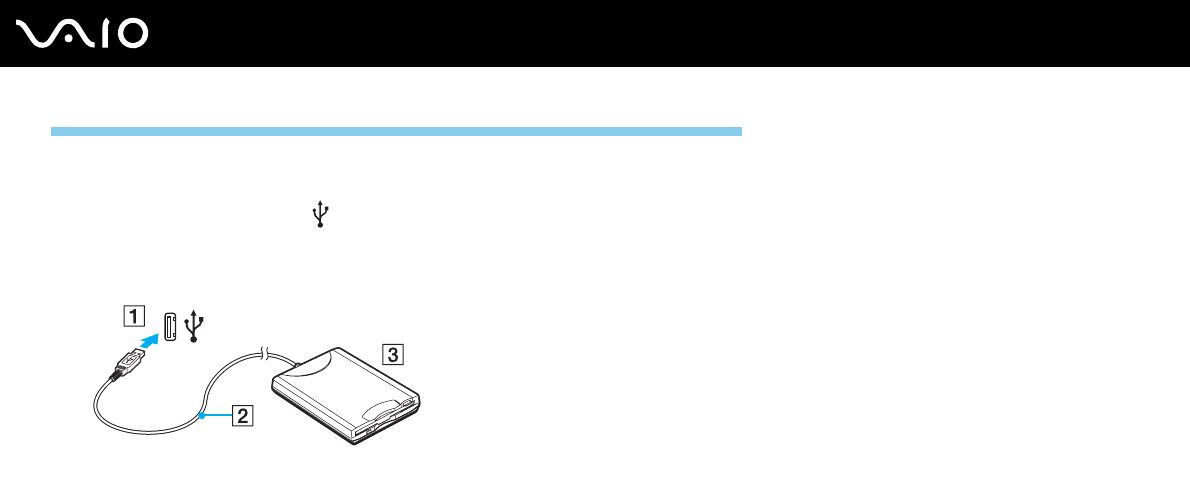
111
nN
Using Peripheral Devices
GVD model_END
To connect a USB floppy disk drive
1Choose the USB port (1) you prefer to use.
2Plug the USB floppy disk drive cable (2) into the USB port.
Your USB floppy disk drive (3) is now ready for use.
!
When using a USB floppy disk drive, do not apply force on the USB port. This may cause a malfunction.
Disconnecting a USB floppy disk drive
You can disconnect a USB floppy disk drive when your computer is on or off. Disconnecting the drive when the computer is
in a power saving mode (Sleep or Hibernate) may cause the computer to malfunction.
If the computer is off, you can unplug the USB cable directly from the computer.
To disconnect a USB floppy disk drive
1Close all programs accessing the floppy disk drive.
2Double-click the Safely Remove Hardware icon on the taskbar.
The Safely Remove Hardware window appears.
3Select the floppy disk drive you want to unplug.

112
nN
Using Peripheral Devices
4Click Stop.
The Stop a Hardware device window appears.
5Confirm that the floppy disk drive can be safely removed from the system.
6Click OK.
A message appears stating it is now safe to remove the hardware device.
7Click OK.
8Click Close to close the Safely Remove Hardware window.
9Disconnect the floppy disk drive from the computer.
Connecting a Printer
You can connect a Windows-compatible printer to your computer to print documents.
Connecting a Printer Using the USB Port
You can connect a USB printer compatible with your version of Windows to the computer.
To connect a printer using the USB port
1Plug the power cord (1) of your printer into an AC outlet.
2Choose the USB port (3) you prefer to use.
3Plug one end of a USB printer cable (2) (not supplied) into the USB port and the other end to your printer.
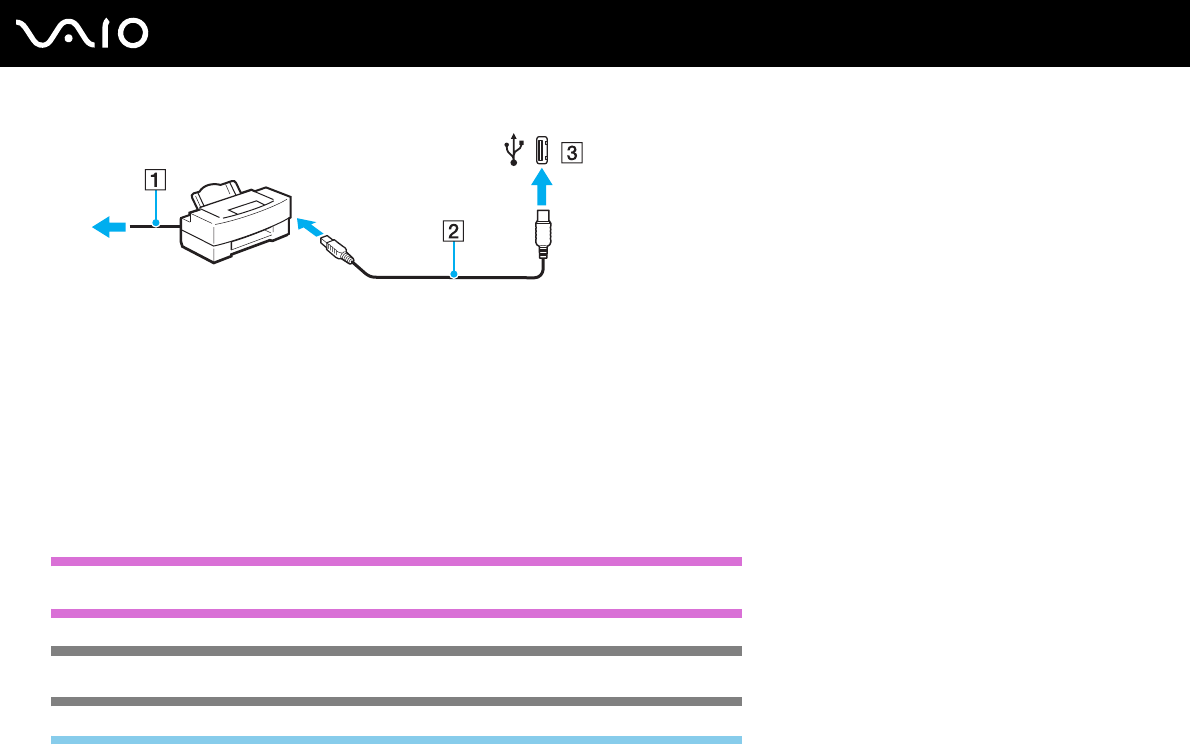
113
nN
Using Peripheral Devices
Connecting an i.LINK Device
Notes on connecting i.LINK devices
❑Your computer is equipped with an i.LINK port, which you can use to connect to an i.LINK device such as a digital video
camcorder.
❑The i.LINK port on your computer does not supply power to external devices generally powered by i.LINK ports.
❑The i.LINK port supports transfer rates up to 400 Mbps; however, the actual transfer rate depends on the transfer rate of
the external device.
US model_BGN
❑The optional i.LINK cables may not be available, depending on the country or area of your residency.
US model_END
Euro model_BGN
❑The optional i.LINK cables may not be available, depending on the country or area of your residency.
Euro model_END
GVD model_BGN
❑The optional i.LINK cables may not be available, depending on your country or region.

114
nN
Using Peripheral Devices
GVD model_END
❑An i.LINK connection with other compatible devices is not fully guaranteed.
❑The i.LINK connection varies depending on the software applications, operating system, and i.LINK-compatible devices
you use. See the manual that came with your software for more information.
❑Check the working conditions and operating system compatibility of i.LINK-compatible PC peripherals (for example, an
HDD or a CD-RW drive) before you connect them to your computer.
IRX-3960_BGN
❑The i.LINK port is disabled if you select the option to disable the i.LINK port with the Peripheral Device & Storage Media
Restriction Setting Utility or power supply to the i.LINK port on the VAIO Power Management tab in the Power Options
window.
IRX-3960_END
Connecting a Digital Video Camcorder
To connect a digital video camcorder
Plug one end of an i.LINK cable (1) (not supplied) into the i.LINK port (2) on the computer and the other end into the DV In/
Out port (3) on the digital video camcorder.
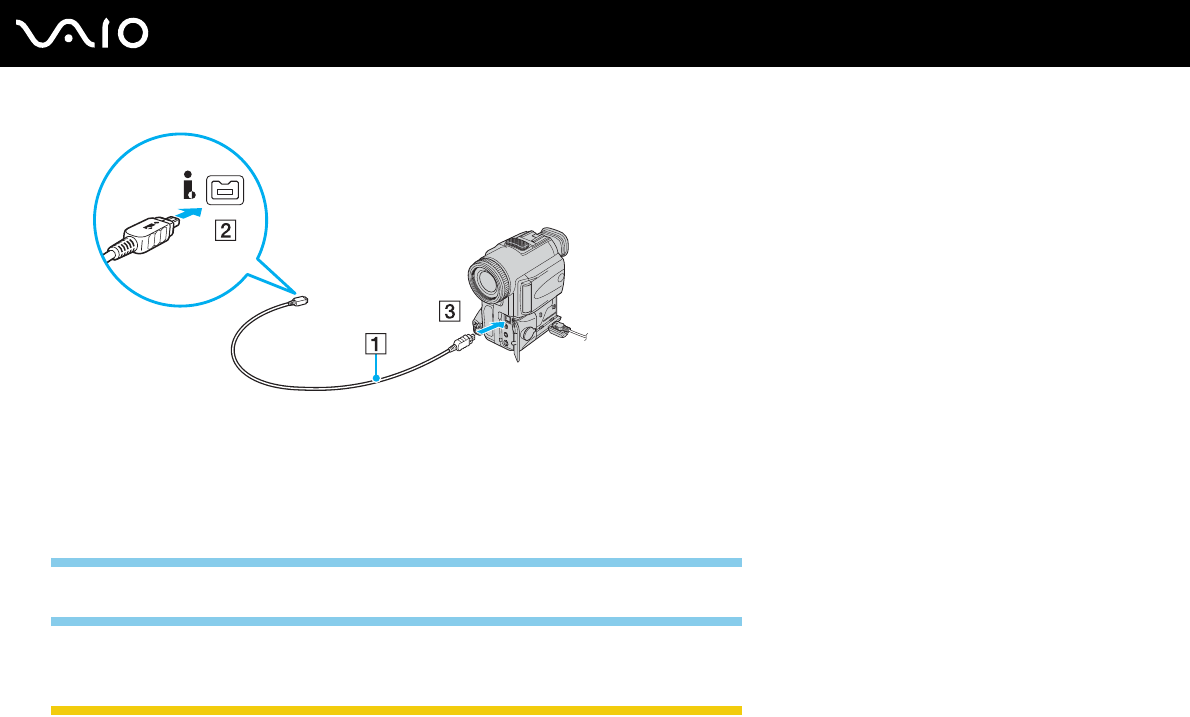
115
nN
Using Peripheral Devices
✍
On Sony digital video cameras, ports labeled DV Out, DV In/Out, or i.LINK are i.LINK-compatible.
The Sony digital video camcorder shown here is an example; your digital video camcorder may need to be connected differently.
You cannot access the pictures stored on a Memory Stick media when using an i.LINK connection.
GVD model_BGN
Switch the video format between NTSC and PAL with the software that you use.
GVD model_END
Connecting to a Network (LAN)
Except IRX-3960_BGN
You can connect your computer to 100BASE-TX/10BASE-T-type networks with an Ethernet network cable. Connect one end
of a network cable (not supplied) to the network (Ethernet) port on the computer or the (optional) port replicator and the other
end to your network. For detailed settings and devices needed to connect to the network, ask your network administrator.
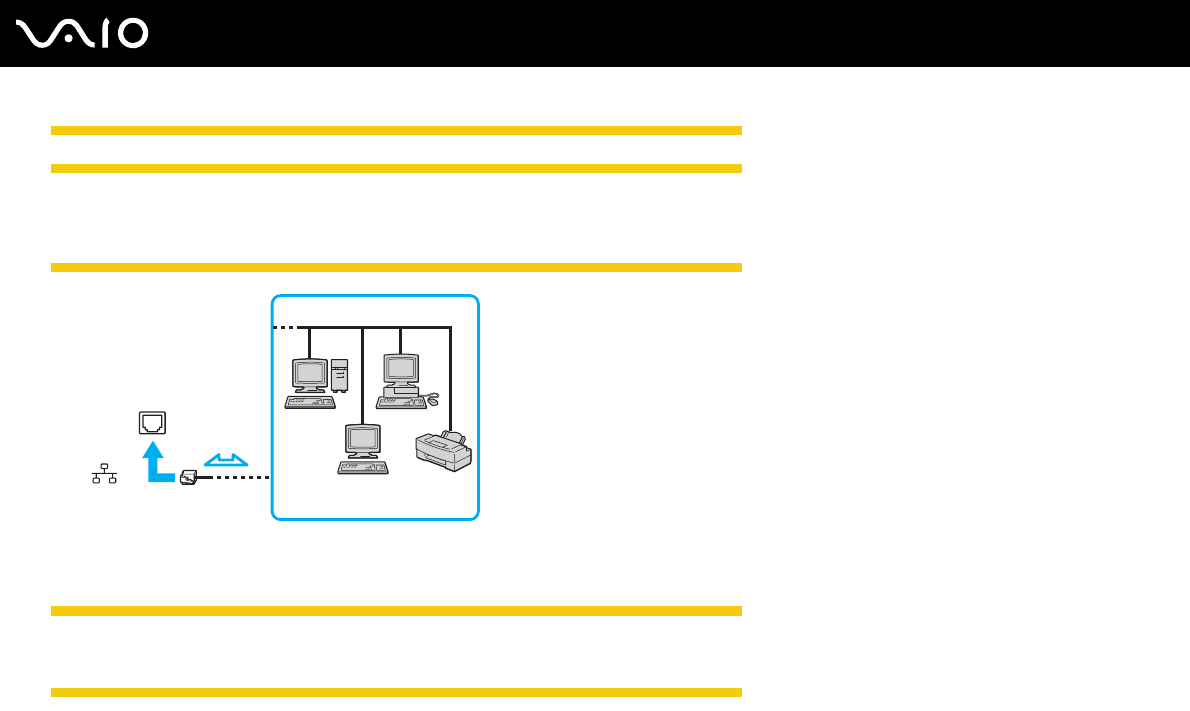
116
nN
Using Peripheral Devices
Except IRX-3960_END
IRX-3960_BGN
You can connect your computer to 1000BASE-T/100BASE-TX/10BASE-T-type networks with an Ethernet network cable.
Connect one end of a network cable (not supplied) to the network (Ethernet) port on the computer and the other end to your
network. For detailed settings and devices needed to connect to the network, ask your network administrator.
IRX-3960_END
✍
Your computer can be connected to the network with the default settings.
IRX-3960_BGN
When your computer is attached to the optional docking station, you need to select which network (Ethernet) port to use. Follow the on-screen
instructions.
IRX-3960_END

117
nN
Using Peripheral Devices
!
Telephone lines cannot be connected to the network (LAN) connector on your computer.
If the network (LAN) connector is connected to the telephone lines mentioned below, high electric current to the connector may cause damage,
overheating, or fire.
- Home (intercom speakerphone) or business-use telephone lines (multi-line business telephone)
- Public telephone subscriber line
- PBX (private branch exchange)
Do not plug a telephone cable into the network port.

118
nN
Customizing Your VAIO Computer
Customizing Your VAIO Computer
Except China_BGN
Except GVD model_BGN
This section briefly describes how to change the main settings of your VAIO computer. Among other things, you will learn
how to use and customize the look of your Sony software and utilities, etc.
Except GVD model_END
Except China_END
Except Euro_BGN
Except US model_BGN
This section briefly describes how to change the main settings of your VAIO computer. Among other things, you will learn
how to prepare your modem for use, how to use and customize the look of your Sony software and utilities, etc.
Except US model_END
Except Euro_END
❑Setting the Password (page 119)
❑Using Fingerprint Authentication (page 145)
❑Using Trusted Platform Module (TPM) (page 156)
Except US model_BGN
❑Setting Up Your Computer with VAIO Control Center (page 166)
Except US model_END
US model_BGN
❑Setting Up Your Computer with VAIO Central (page 167)

119
nN
Customizing Your VAIO Computer
US model_END
❑Using the VAIO Status Monitor (page 167)
❑Using the Power Saving Modes (page 168)
❑Managing Power with VAIO Power Management (page 173)
❑Changing the Performance Setting (page 176)
❑Protecting Data from Unauthorized Use (page 177)
Except US model_BGN
❑Configuring Your Modem (page 178)
Except US model_END
❑Protecting the Hard Disk (page 181)
Setting the Password
Except China_BGN
Except Euro_BGN
In addition to the Windows password, you can use BIOS functions to set two types of passwords to protect your computer:
power-on password and hard disk password.
Once you have set the power-on password, you will be prompted to enter the password after the VAIO logo appears to start
your computer. The power-on password allows you to protect your computer from unauthorized access.
The hard disk password provides additional security for the data stored on your built-in flash memory storage or hard disk
drive*. If you set the hard disk password, no other users will be able to access the data without knowing the password, even
if the password-protected flash memory storage or hard disk drive is installed in another computer.
US model_BGN

120
nN
Customizing Your VAIO Computer
* Your computer may be equipped with either the built-in flash memory storage or hard disk drive, depending on the model you purchased. See the online Specifications
to find which storage device your model is equipped with.
US model_END
GVD model_BGN
* Your computer may be equipped with either the built-in flash memory storage or hard disk drive, depending on the model you purchased. See the printed Specifications
sheet to find which storage device your model is equipped with.
GVD model_END
Except Euro_END
Except China_END
Euro model_BGN
In addition to the Windows password, you can use one of the BIOS functions to set a power-on password to protect your
computer.
Once you have set the power-on password, you will be prompted to enter the password after the VAIO logo appears to start
your computer. The power-on password allows you to protect your computer from unauthorized access.
Euro model_END
China model_BGN
If your computer is equipped with the fingerprint sensor, you can use BIOS functions to set two types of passwords to protect
your computer in addition to the Windows password: power-on password and hard disk password.
Once you have set the power-on password, you will be prompted to enter the password after the VAIO logo appears to start
your computer. The power-on password allows you to protect your computer from unauthorized access.
The hard disk password provides additional security for the data stored on your built-in flash memory storage or hard disk
drive*. If you set the hard disk password, no other users will be able to access the data without knowing the password, even
if the password-protected flash memory storage or hard disk drive is installed in another computer.
* Your computer may be equipped with either the built-in flash memory storage or hard disk drive as the primary storage device, depending on the model you purchased.
See the printed Specifications sheet to find which storage device your model is equipped with.

121
nN
Customizing Your VAIO Computer
China model_END
Adding the Power-on Password
The power-on password is provided to protect your computer from unauthorized access.
Except IRX-3960_BGN
There are two types of the power-on password: machine password and user password. The machine password is provided
for users with administrator rights on the computer to change all the setup options on the BIOS setup screen, as well as to
start the computer. The user password is provided for other standard users to allow for changing some of the BIOS setup
options, as well as starting the computer. To set the user password, you must first set the machine password.
Except IRX-3960_END
IRX-3960_BGN
Except China_BGN
Except Euro_BGN
There are two types of the power-on password: machine password and user password. The machine password is provided
for users with administrator rights on the computer to change all the setup options on the BIOS setup screen, as well as to
start the computer. The user password is provided for other standard users to allow for changing some of the BIOS setup
options, as well as starting the computer. To set the user password, you must first set the machine password.
Except Euro_END
Except China_END
Except GVD model_BGN
Except US model_BGN

122
nN
Customizing Your VAIO Computer
On models with the fingerprint sensor, there are two types of the power-on password: machine password and user password.
The machine password is provided for users with administrator rights on the computer to change all the setup options on the
BIOS setup screen, as well as to start the computer. The user password is provided for other standard users to allow for
changing some of the BIOS setup options, as well as starting the computer. To set the user password, you must first set the
machine password.
Except US model_END
Except GVD model_END
IRX-3960_END
!
Once you have set the power-on password, you cannot start your computer without entering the password. Make sure not to forget the password. Write
down your password and keep it safe and private from other people.
If you forget the power-on password and need assistance to reset it, a password reset fee will be charged, and your computer may need to be sent in
for depot service for password reset.
IRX-3960_BGN
Except China_BGN
Except Euro_BGN
✍
If you have set the power-on password in conjunction with the fingerprint authentication functionality, you can substitute fingerprint recognition for
password entry when turning on your computer. For more information, see Using Fingerprint Authentication (page 145).
Except Euro_END
Except China_END
Except GVD model_BGN
Except US model_BGN

123
nN
Customizing Your VAIO Computer
✍
If your computer is equipped with the fingerprint sensor and you have set the power-on password in conjunction with the fingerprint authentication
functionality, you can substitute fingerprint recognition for password entry when turning on your computer. For more information, see Using
Fingerprint Authentication (page 145).
Except US model_END
Except GVD model_END
IRX-3960_END
Except IRX-3960_BGN
To add the power-on password (machine password)
1Turn on the computer.
2Press the F2 key when the VAIO logo appears.
The BIOS setup screen appears. If not, restart the computer and press the F2 key several times when the VAIO logo
appears.
3Press the < or , key to select Security to display the Security tab, select Set Machine Password, and then press the
Enter key.
4On the password entry screen, enter the password twice and press the Enter key.
The password can be up to 32 alphanumeric characters (including spaces) long.
5Select Password when Power On under Security.
Press the space bar to change the setting from Disabled to Enabled.
6Press the < or , key to select Exit, select Exit Setup, and then press the Enter key.
At the confirmation prompt, press the Enter key.
To add the power-on password (user password)
!
Make sure you set the machine password before setting the user password.

124
nN
Customizing Your VAIO Computer
1Turn on the computer.
2Press the F2 key when the VAIO logo appears.
The BIOS setup screen appears. If not, restart the computer and press the F2 key several times when the VAIO logo
appears.
3Enter the machine password for Enter Password and press the Enter key.
4Press the < or , key to select Security to display the Security tab, select Set User Password, and then press the
Enter key.
5On the password entry screen, enter the password twice and press the Enter key.
The password can be up to 32 alphanumeric characters (including spaces) long.
6Press the < or , key to select Exit, select Exit Setup, and then press the Enter key.
At the confirmation prompt, press the Enter key.
To add the power-on password
1Turn on the computer.
2Press the F2 key when the VAIO logo appears.
The BIOS setup screen appears. If not, restart the computer and press the F2 key several times when the VAIO logo
appears.
3Press the < or , key to select Security to display the Security tab, select Set Machine Password, and then press the
Enter key.
4On the password entry screen, enter the password twice and press the Enter key.
The password can be up to 32 alphanumeric characters (including spaces) long.
5At the confirmation prompt, press the Enter key.
✍
The following is to configure your computer to prompt password entry when you turn it on or display the BIOS setup screen.

125
nN
Customizing Your VAIO Computer
6Select Password when Power On under Security.
Press the space bar to change the setting from Disabled to Enabled.
7Press the < or , key to select Exit, select Exit Setup, and then press the Enter key.
At the confirmation prompt, press the Enter key.
Except IRX-3960_END
IRX-3960_BGN
Except China_BGN
Except Euro_BGN
To add the power-on password (machine password)
1Turn on the computer.
2Press the F2 key when the VAIO logo appears.
The BIOS setup screen appears. If not, restart the computer and press the F2 key several times when the VAIO logo
appears.
3Press the < or , key to select Security to display the Security tab, select Set Machine Password, and then press the
Enter key.
4On the password entry screen, enter the password twice and press the Enter key.
The password can be up to 32 alphanumeric characters (including spaces) long.
5Select Password when Power On under Security.
Press the space bar to change the setting from Disabled to Enabled.
6Press the < or , key to select Exit, select Exit Setup, and then press the Enter key.
At the confirmation prompt, press the Enter key.
To add the power-on password (user password)
!
Make sure you set the machine password before setting the user password.

126
nN
Customizing Your VAIO Computer
1Turn on the computer.
2Press the F2 key when the VAIO logo appears.
The BIOS setup screen appears. If not, restart the computer and press the F2 key several times when the VAIO logo
appears.
3Enter the machine password for Enter Password and press the Enter key.
4Press the < or , key to select Security to display the Security tab, select Set User Password, and then press the
Enter key.
5On the password entry screen, enter the password twice and press the Enter key.
The password can be up to 32 alphanumeric characters (including spaces) long.
6Press the < or , key to select Exit, select Exit Setup, and then press the Enter key.
At the confirmation prompt, press the Enter key.
Except Euro_END
Except China_END
Except GVD model_BGN
Except US model_BGN
On models with the fingerprint sensor
To add the power-on password (machine password)
1Turn on the computer.
2Press the F2 key when the VAIO logo appears.
The BIOS setup screen appears. If not, restart the computer and press the F2 key several times when the VAIO logo
appears.
3Press the < or , key to select Security to display the Security tab, select Set Machine Password, and then press the
Enter key.

127
nN
Customizing Your VAIO Computer
4On the password entry screen, enter the password twice and press the Enter key.
The password can be up to 32 alphanumeric characters (including spaces) long.
5Select Password when Power On under Security.
Press the space bar to change the setting from Disabled to Enabled.
6Press the < or , key to select Exit, select Exit Setup, and then press the Enter key.
At the confirmation prompt, press the Enter key.
To add the power-on password (user password)
!
Make sure you set the machine password before setting the user password.
1Turn on the computer.
2Press the F2 key when the VAIO logo appears.
The BIOS setup screen appears. If not, restart the computer and press the F2 key several times when the VAIO logo
appears.
3Enter the machine password for Enter Password and press the Enter key.
4Press the < or , key to select Security to display the Security tab, select Set User Password, and then press the
Enter key.
5On the password entry screen, enter the password twice and press the Enter key.
The password can be up to 32 alphanumeric characters (including spaces) long.
6Press the < or , key to select Exit, select Exit Setup, and then press the Enter key.
At the confirmation prompt, press the Enter key.

128
nN
Customizing Your VAIO Computer
On models without the fingerprint sensor
To add the power-on password
1Turn on the computer.
2Press the F2 key when the VAIO logo appears.
The BIOS setup screen appears. If not, restart the computer and press the F2 key several times when the VAIO logo
appears.
3Press the < or , key to select Security to display the Security tab, select Set Machine Password, and then press the
Enter key.
4On the password entry screen, enter the password twice and press the Enter key.
The password can be up to 32 alphanumeric characters (including spaces) long.
5At the confirmation prompt, press the Enter key.
✍
The following is to configure your computer to prompt password entry when you turn it on or display the BIOS setup screen.
6Select Password when Power On under Security.
Press the space bar to change the setting from Disabled to Enabled.
7Press the < or , key to select Exit, select Exit Setup, and then press the Enter key.
At the confirmation prompt, press the Enter key.
Except US model_END
Except GVD model_END
IRX-3960_END
Changing/Removing the Power-on Password
Except IRX-3960_BGN

129
nN
Customizing Your VAIO Computer
To change or remove the power-on password (machine password)
1Turn on the computer.
2Press the F2 key when the VAIO logo appears.
The BIOS setup screen appears. If not, restart the computer and press the F2 key several times when the VAIO logo
appears.
3Enter the machine password and press the Enter key.
4Press the < or , key to select Security to display the Security tab, select Set Machine Password, and then press the
Enter key.
5On the password entry screen, enter the current password once and a new password twice, and then press the Enter key.
To remove the password, leave the Enter New Password and Confirm New Password fields blank and press the Enter
key.
6Press the < or , key to select Exit, select Exit Setup, and then press the Enter key.
At the confirmation prompt, press the Enter key.
To change or remove the power-on password (user password)
1Turn on the computer.
2Press the F2 key when the VAIO logo appears.
The BIOS setup screen appears. If not, restart the computer and press the F2 key several times when the VAIO logo
appears.
3Enter the user password and press the Enter key.
4Press the < or , key to select Security to display the Security tab, select Set User Password, and then press the
Enter key.

130
nN
Customizing Your VAIO Computer
5On the password entry screen, enter the current password once and a new password twice, and then press the Enter key.
To remove the password, leave the Enter New Password and Confirm New Password fields blank and press the Enter
key.
6Press the < or , key to select Exit, select Exit Setup, and then press the Enter key.
At the confirmation prompt, press the Enter key.
To change or remove the power-on password
1Turn on the computer.
2Press the F2 key when the VAIO logo appears.
The BIOS setup screen appears. If not, restart the computer and press the F2 key several times when the VAIO logo
appears.
3Enter the current password and press the Enter key.
4Press the < or , key to select Security to display the Security tab, select Set Machine Password, and then press the
Enter key.
5On the password entry screen, enter the current password once and a new password twice, and then press the Enter key.
To remove the password, leave the Enter New Password and Confirm New Password fields blank and press the Enter
key.
When confirmation to save the changes is prompted, press the Enter key.
6Press the < or , key to select Exit, select Exit Setup, and then press the Enter key.
At the confirmation prompt, press the Enter key.
Except IRX-3960_END
IRX-3960_BGN
Except China_BGN
Except Euro_BGN

131
nN
Customizing Your VAIO Computer
To change or remove the power-on password (machine password)
1Turn on the computer.
2Press the F2 key when the VAIO logo appears.
The BIOS setup screen appears. If not, restart the computer and press the F2 key several times when the VAIO logo
appears.
3Enter the machine password and press the Enter key.
4Press the < or , key to select Security to display the Security tab, select Set Machine Password, and then press the
Enter key.
5On the password entry screen, enter the current password once and a new password twice, and then press the Enter key.
To remove the password, leave the Enter New Password and Confirm New Password fields blank and press the Enter
key.
6Press the < or , key to select Exit, select Exit Setup, and then press the Enter key.
At the confirmation prompt, press the Enter key.
To change or remove the power-on password (user password)
1Turn on the computer.
2Press the F2 key when the VAIO logo appears.
The BIOS setup screen appears. If not, restart the computer and press the F2 key several times when the VAIO logo
appears.
3Enter the user password and press the Enter key.
4Press the < or , key to select Security to display the Security tab, select Set User Password, and then press the
Enter key.

132
nN
Customizing Your VAIO Computer
5On the password entry screen, enter the current password once and a new password twice, and then press the Enter key.
To remove the password, leave the Enter New Password and Confirm New Password fields blank and press the Enter
key.
6Press the < or , key to select Exit, select Exit Setup, and then press the Enter key.
At the confirmation prompt, press the Enter key.
Except Euro_END
Except China_END
Except GVD model_BGN
Except US model_BGN
On models with the fingerprint sensor
To change or remove the power-on password (machine password)
1Turn on the computer.
2Press the F2 key when the VAIO logo appears.
The BIOS setup screen appears. If not, restart the computer and press the F2 key several times when the VAIO logo
appears.
3Enter the machine password and press the Enter key.
4Press the < or , key to select Security to display the Security tab, select Set Machine Password, and then press the
Enter key.
5On the password entry screen, enter the current password once and a new password twice, and then press the Enter key.
To remove the password, leave the Enter New Password and Confirm New Password fields blank and press the Enter
key.
6Press the < or , key to select Exit, select Exit Setup, and then press the Enter key.
At the confirmation prompt, press the Enter key.

133
nN
Customizing Your VAIO Computer
To change or remove the power-on password (user password)
1Turn on the computer.
2Press the F2 key when the VAIO logo appears.
The BIOS setup screen appears. If not, restart the computer and press the F2 key several times when the VAIO logo
appears.
3Enter the user password and press the Enter key.
4Press the < or , key to select Security to display the Security tab, select Set User Password, and then press the
Enter key.
5On the password entry screen, enter the current password once and a new password twice, and then press the Enter key.
To remove the password, leave the Enter New Password and Confirm New Password fields blank and press the Enter
key.
6Press the < or , key to select Exit, select Exit Setup, and then press the Enter key.
At the confirmation prompt, press the Enter key.
On models without the fingerprint sensor
To change or remove the power-on password
1Turn on the computer.
2Press the F2 key when the VAIO logo appears.
The BIOS setup screen appears. If not, restart the computer and press the F2 key several times when the VAIO logo
appears.
3Enter the current password and press the Enter key.
4Press the < or , key to select Security to display the Security tab, select Set Machine Password, and then press the
Enter key.

134
nN
Customizing Your VAIO Computer
5On the password entry screen, enter the current password once and a new password twice, and then press the Enter key.
To remove the password, leave the Enter New Password and Confirm New Password fields blank and press the Enter
key.
When confirmation to save the changes is prompted, press the Enter key.
6Press the < or , key to select Exit, select Exit Setup, and then press the Enter key.
At the confirmation prompt, press the Enter key.
Except US model_END
Except GVD model_END
IRX-3960_END
Except Euro_BGN
Adding the Hard Disk Password
Except IRX-3960_BGN
The hard disk password provides additional security for the data stored on your hard disk drive. If you enable the hard disk
password, this adds an extra level of security.
When adding the hard disk password, you must set both the master and user passwords. The master password is provided
for users with administrator rights on the computer to reset the user password on the BIOS setup screen. The user password
is provided to lock your hard disk drive. Once you set the user password, you will have to enter the password along with the
power-on password (if set), after the VAIO logo appears.
Except IRX-3960_END
IRX-3960_BGN
Except China_BGN
The hard disk password provides additional security for the data stored on your built-in flash memory storage or hard disk
drive*. If you enable the hard disk password, this adds an extra level of security.

135
nN
Customizing Your VAIO Computer
US model_BGN
* Your computer may be equipped with either the built-in flash memory storage or hard disk drive, depending on the model you purchased. See the online Specifications
to find which storage device your model is equipped with.
US model_END
GVD model_BGN
* Your computer may be equipped with either the built-in flash memory storage or hard disk drive, depending on the model you purchased. See the printed Specifications
sheet to find which storage device your model is equipped with.
GVD model_END
When adding the hard disk password, you must set both the master and user passwords. The master password is provided
for users with administrator rights on the computer to reset the user password on the BIOS setup screen. The user password
is provided to lock your built-in flash memory storage or hard disk drive. Once you set the user password, you will have to
enter the password along with the power-on password (if set), after the VAIO logo appears.
Except China_END
China model_BGN
If your computer is equipped with the fingerprint sensor, you can use the hard disk password to enhance security for the data
stored on your built-in flash memory storage or hard disk drive*.
* Your computer may be equipped with either the built-in flash memory storage or hard disk drive as the primary storage device, depending on the model you purchased.
See the printed Specifications sheet to find which storage device your model is equipped with.
When adding the hard disk password, you must set both the master and user passwords. The master password is provided
for users with administrator rights on the computer to reset the user password on the BIOS setup screen. The user password
is provided to lock your built-in flash memory storage or hard disk drive. Once you set the user password, you will have to
enter the password along with the power-on password (if set), after the VAIO logo appears.
China model_END
IRX-3960_END
Except IRX-3960_BGN

136
nN
Customizing Your VAIO Computer
!
You cannot start your computer with the master password.
Except IRX-3960_END
IRX-3960_BGN
Except China_BGN
!
You cannot start your computer with the master password.
Except China_END
China model_BGN
!
If your computer has a built-in flash memory storage as the primary data storage device and a built-in 2.5-inch hard disk drive as the secondary one,
you can set the hard disk password on either device.
You cannot start your computer with the master password.
China model_END
IRX-3960_END
If you forget the master password or the keyboard fails, which is critical to password entry, no bypass is possible and the data stored on the hard disk
drive will not be accessible. There is NO RESET of this password. You will have to replace the hard disk drive at your own expense and lose all the data
stored on the original hard disk drive. Be sure to write down the master password and keep it safe and private from other people.
✍
If you have set the hard disk password in conjunction with the fingerprint authentication functionality, you can substitute fingerprint recognition for
password entry when turning on your computer. For more information, see Using Fingerprint Authentication (page 145).
To add the hard disk password
Except IRX-3960_BGN
1Turn on the computer.

137
nN
Customizing Your VAIO Computer
2Press the F2 key when the VAIO logo appears.
The BIOS setup screen appears. If not, restart the computer and press the F2 key several times when the VAIO logo
appears.
✍
If you have set the power-on password, enter your power-on password for Enter Password.
3Press the < or , key to select Security to display the Security tab, select Hard Disk Password, and then press the
Enter key.
The password entry screen appears.
4Select Enter Master and User Passwords and press the Enter key.
5Select Continue on the warning screen and press the Enter key.
6Enter the master password twice and press the Enter key.
The password should be up to 32 alphanumeric characters (including spaces) long.
7Enter the user password twice and press the Enter key.
The password should be up to 32 alphanumeric characters (including spaces) long.
8At the confirmation prompt, press the Enter key.
9Press the Esc key.
10 Press the < or , key to select Exit, select Exit Setup, and then press the Enter key.
At the confirmation prompt, press the Enter key.
Except IRX-3960_END
IRX-3960_BGN
1Turn on the computer.
2Press the F2 key when the VAIO logo appears.
The BIOS setup screen appears. If not, restart the computer and press the F2 key several times when the VAIO logo
appears.

138
nN
Customizing Your VAIO Computer
✍
If you have set the power-on password, enter your power-on password for Enter Password.
Except China_BGN
3Press the < or , key to select Security to display the Security tab, select Hard Disk Password, and then press the
Enter key.
The password entry screen appears.
Except China_END
China model_BGN
4Do either of the following depending on your model.
❑Models with a single built-in storage device
Press the < or , key to select Security to display the Security tab, select Hard Disk Password, and then press
the Enter key.
The password entry screen appears.
❑Models with two built-in storage devices
Press the < or , key to select Security to display the Security tab, select Hard Disk1 Password or Hard Disk2
Password, and then press the Enter key.
China model_END
5Select Enter Master and User Passwords and press the Enter key.
6Select Continue on the warning screen and press the Enter key.
7Enter the master password twice and press the Enter key.
The password should be up to 32 alphanumeric characters (including spaces) long.
8Enter the user password twice and press the Enter key.
The password should be up to 32 alphanumeric characters (including spaces) long.
9At the confirmation prompt, press the Enter key.

139
nN
Customizing Your VAIO Computer
10 Press the Esc key.
11 Press the < or , key to select Exit, select Exit Setup, and then press the Enter key.
At the confirmation prompt, press the Enter key.
IRX-3960_END
Changing the Hard Disk Password
To change the hard disk password
Except IRX-3960_BGN
1Turn on the computer.
2Press the F2 key when the VAIO logo appears.
The BIOS setup screen appears. If not, restart the computer and press the F2 key several times when the VAIO logo
appears.
✍
If you have set the power-on password, enter your power-on password for Enter Password.
3Press the < or , key to select Security to display the Security tab, select Hard Disk Password, and then press the
Enter key.
The password entry screen appears.
4Select Change Master Password or Change User Password and press the Enter key.
5Enter the current password once and then a new password twice.
6Press the Enter key.
7Press the Enter key when the success message appears.
8Press the Esc key.

140
nN
Customizing Your VAIO Computer
9Press the < or , key to select Exit, select Exit Setup, and then press the Enter key.
At the confirmation prompt, press the Enter key.
Except IRX-3960_END
IRX-3960_BGN
1Turn on the computer.
2Press the F2 key when the VAIO logo appears.
The BIOS setup screen appears. If not, restart the computer and press the F2 key several times when the VAIO logo
appears.
✍
If you have set the power-on password, enter your power-on password for Enter Password.
Except China_BGN
3Press the < or , key to select Security to display the Security tab, select Hard Disk Password, and then press the
Enter key.
The password entry screen appears.
Except China_END
China model_BGN
4Do either of the following depending on your model.
❑Models with a single built-in storage device
Press the < or , key to select Security to display the Security tab, select Hard Disk Password, and then press
the Enter key.
The password entry screen appears.
❑Models with two built-in storage devices
Press the < or , key to select Security to display the Security tab, select Hard Disk1 Password or Hard Disk2
Password, and then press the Enter key.

141
nN
Customizing Your VAIO Computer
China model_END
5Select Change Master Password or Change User Password and press the Enter key.
6Enter the current password once and then a new password twice.
7Press the Enter key.
8Press the Enter key when the success message appears.
9Press the Esc key.
10 Press the < or , key to select Exit, select Exit Setup, and then press the Enter key.
At the confirmation prompt, press the Enter key.
IRX-3960_END
Removing the Hard Disk Password
To remove the hard disk password
Except IRX-3960_BGN
1Turn on the computer.
2Press the F2 key when the VAIO logo appears.
The BIOS setup screen appears. If not, restart the computer and press the F2 key several times when the VAIO logo
appears.
✍
If you have set the power-on password, enter your power-on password for Enter Password.
3Press the < or , key to select Security to display the Security tab, select Hard Disk Password, and then press the
Enter key.
The password entry screen appears.
4Select Enter Master and User Password and press the Enter key.

142
nN
Customizing Your VAIO Computer
5Enter the current password for Enter Current Hard Disk Master Password and press the Enter key, leaving everything
else blank.
6Press the Enter key when the success message appears.
7Press the Esc key.
8Press the < or , key to select Exit, select Exit Setup, and then press the Enter key.
At the confirmation prompt, press the Enter key.
Except IRX-3960_END
IRX-3960_BGN
1Turn on the computer.
2Press the F2 key when the VAIO logo appears.
The BIOS setup screen appears. If not, restart the computer and press the F2 key several times when the VAIO logo
appears.
✍
If you have set the power-on password, enter your power-on password for Enter Password.
Except China_BGN
3Press the < or , key to select Security to display the Security tab, select Hard Disk Password, and then press the
Enter key.
The password entry screen appears.
Except China_END
China model_BGN
4Do either of the following depending on your model.

143
nN
Customizing Your VAIO Computer
❑Models with a single built-in storage device
Press the < or , key to select Security to display the Security tab, select Hard Disk Password, and then press
the Enter key.
The password entry screen appears.
❑Models with two built-in storage devices
Press the < or , key to select Security to display the Security tab, select Hard Disk1 Password or Hard Disk2
Password, and then press the Enter key.
China model_END
5Select Enter Master and User Password and press the Enter key.
6Enter the current password for Enter Current Hard Disk Master Password and press the Enter key, leaving everything
else blank.
7Press the Enter key when the success message appears.
8Press the Esc key.
9Press the < or , key to select Exit, select Exit Setup, and then press the Enter key.
At the confirmation prompt, press the Enter key.
IRX-3960_END
Except Euro_END
Adding the Windows Password
The Windows password comes in handy when you have to share a single computer with other people. By setting the Windows
password, you can protect your user account from unauthorized access.
Entry of the Windows password will be prompted after you select your user account.
!
Make sure not to forget the password. Write down your password and keep it safe and private from other people.

144
nN
Customizing Your VAIO Computer
✍
If you have set the Windows password in conjunction with the fingerprint authentication functionality, you can substitute fingerprint recognition for
password entry when turning on your computer. For more information, see Using Fingerprint Authentication (page 145).
To add the Windows password
1Click Start and Control Panel.
2Click User Accounts and Family Safety or User Accounts.
3Click User Accounts.
4Click Create a password for your account under Make changes to your account.
5In the New password and Confirm new password fields, enter the password for your account.
6Click Create password.
✍
See Windows Help and Support for more information on the Windows password.
Changing/Removing the Windows Password
To change the Windows password
1Click Start and Control Panel.
2Click User Accounts and Family Safety or User Accounts.
3Click User Accounts.
4Click Change your password.
5In the Current password field, enter your current password.
6In the New password and Confirm new password fields, enter a new password.

145
nN
Customizing Your VAIO Computer
7Click Change password.
To remove the Windows password
1Click Start and Control Panel.
2Click User Accounts and Family Safety or User Accounts.
3Click User Accounts.
4Click Remove my password.
5In the Current password field, enter the current password that you want to remove.
6Click Remove password.
Using Fingerprint Authentication
Except GVD model_BGN
Except US model_BGN
Your computer may be equipped with a fingerprint sensor to provide you with additional convenience. A small horizontal bar
located between the left and right touch-pad buttons is the sensor of the fingerprint reader and will be referred to as the
fingerprint sensor hereinafter.
Euro model_BGN
See the online Specifications to see whether your model is equipped with the fingerprint sensor.
Euro model_END
China model_BGN
See the printed Specifications sheet to see whether your model is equipped with the fingerprint sensor.
China model_END
Except US model_END

146
nN
Customizing Your VAIO Computer
Except GVD model_END
Except China_BGN
Except Euro_BGN
Your computer is equipped with a fingerprint sensor to provide you with additional convenience. A small horizontal bar located
between the left and right touch-pad buttons is the sensor of the fingerprint reader and will be referred to as the fingerprint
sensor hereinafter.
Except Euro_END
Except China_END
Once you have registered your fingerprint(s), the fingerprint authentication functionality offers:
❑A substitute for password entry
❑Logging onto Windows (page 152)
If you have enrolled your fingerprints for your user account, you can substitute fingerprint authentication for password
entry when logging onto Windows.
Except Euro_BGN
❑Power-on Security feature (page 152)
If you have set the power-on password (page 121) or the hard disk password (page 134), you can substitute fingerprint
authentication for password entry when starting your computer.
Except Euro_END
Euro model_BGN
❑Power-on Security feature (page 152)
If you have set the power-on password (page 121), you can substitute fingerprint authentication for password entry
when starting your computer.
Euro model_END

147
nN
Customizing Your VAIO Computer
❑Password bank for quick Web site access (page 153)
You can substitute fingerprint authentication for entering required information and access the password-protected Web
sites.
Except China_BGN
❑File Safe feature to encrypt/decrypt data (page 153)
With the File Safe feature, you can encrypt files and folder to create an encrypted archive. To decrypt or access such
encrypted archives, you can use the fingerprint authentication or enter the password you specified at encryption.
Except China_END
❑Application launcher function for quick application access (page 154)
Once you have assigned an application to your finger, you can then swipe the finger across the fingerprint sensor to
launch the assigned application.
Precautions on Using Fingerprint Authentication
❑The fingerprint authentication technology does not assure complete user authentication or complete protection of your
data and hardware.
Sony assumes no liabilities for any problems and damages arising out of your use of or inability to use the fingerprint
sensor.
❑The fingerprint recognition rate depends on your operating conditions and varies among individuals as well.
Except IRX-3960_BGN
Except China_BGN
❑Be sure to make a backup copy of the data stored on the hard disk drive, especially in the encrypted archives created
with the File Safe feature, before sending your computer for repair.
Sony assumes no liabilities for any loss or modification of your data that might have occurred during the course of repair.
Except China_END

148
nN
Customizing Your VAIO Computer
China model_BGN
❑Be sure to make a backup copy of the data stored on the hard disk drive before sending your computer for repair.
Sony assumes no liabilities for any loss or modification of your data that might have occurred during the course of repair.
China model_END
Except IRX-3960_END
IRX-3960_BGN
Except China_BGN
❑Be sure to make a backup copy of the data stored on the built-in flash memory storage or hard disk drive*, especially in
the encrypted archives created with the File Safe feature, before sending your computer for repair.
Sony assumes no liabilities for any loss or modification of your data that might have occurred during the course of repair.
US model_BGN
* Your computer may be equipped with either the built-in flash memory storage or hard disk drive, depending on the model you purchased. See the online Specifications
to find which storage device your model is equipped with.
US model_END
GVD model_BGN
* Your computer may be equipped with either the built-in flash memory storage or hard disk drive, depending on the model you purchased. See the printed Specifications
sheet to find which storage device your model is equipped with.
GVD model_END
Except China_END
China model_BGN
❑Be sure to make a backup copy of the data stored on the built-in flash memory storage or hard disk drive* before sending
your computer for repair.
Sony assumes no liabilities for any loss or modification of your data that might have occurred during the course of repair.
* Your computer may be equipped with either the built-in flash memory storage or hard disk drive as the primary storage device, depending on the model you purchased.
See the printed Specifications sheet to find which storage device your model is equipped with.

149
nN
Customizing Your VAIO Computer
China model_END
IRX-3960_END
Except IRX-3960_BGN
❑In case the hard disk drive has to be initialized, for example after the repair work, the fingerprint templates will be lost.
You will have to enroll them all over again.
Except IRX-3960_END
IRX-3960_BGN
❑In case the built-in flash memory storage or hard disk drive has to be initialized, for example after the repair work, the
fingerprint templates will be lost. You will have to enroll them all over again.
IRX-3960_END
❑The maintenance and management of data concerning fingerprint authentication must be carried out at your own risk.
Sony assumes no liabilities for any defects arising out of your data maintenance and management.
❑Before disposing of your computer or transferring it to a third person, it is strongly recommended you erase the fingerprint
data enrolled on the fingerprint sensor after erasing the data stored on your hard disk drive. See Erasing the Enrolled
Fingerprints (page 155) for the detailed procedure.
Enrolling a Fingerprint
To use the fingerprint authentication functionality, you must enroll your fingerprint(s) in your computer.
✍
Set the Windows password on your computer before enrollment. See Adding the Windows Password (page 143) for the detailed instructions.
To enroll a fingerprint
!
Up to 10 fingerprints can be enrolled for each user and up to 21 fingerprints can be enrolled for logging onto your system using the Power-on Security
feature. You can also select the finger of which fingerprint you want to use for the Power-on Security feature later.
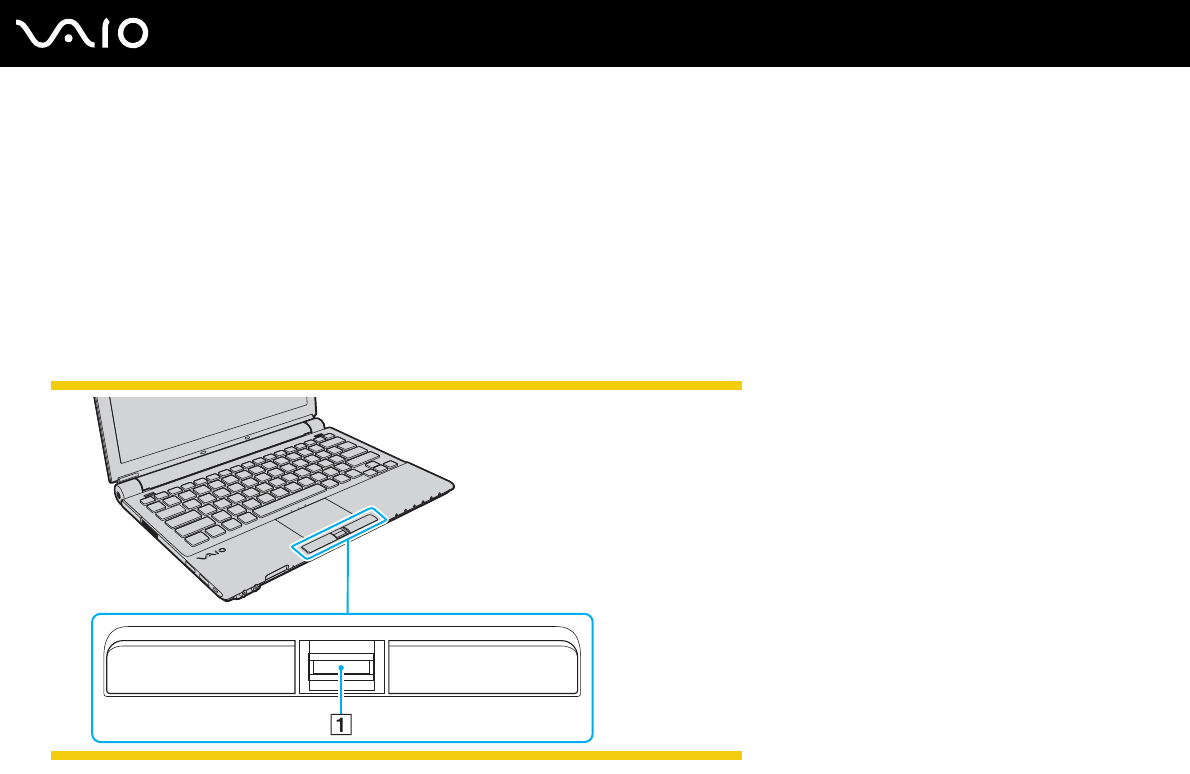
150
nN
Customizing Your VAIO Computer
1Click Start, All Programs, Protector Suite QL, and Control Center.
The Fingerprint Control Center window appears.
2Click Fingerprints and Initialize.
3Follow the on-screen instructions.
✍
To read the detailed description, click Help in step 2.
If you have failed to enroll a fingerprint, follow these steps to try again.
1Place the top joint of your finger on the fingerprint sensor (1).
IRX-3960_BGN
IRX-3960_END
2Swipe your finger perpendicularly across the fingerprint sensor.

151
nN
Customizing Your VAIO Computer
!
Place your fingertip flat in the center of the fingerprint sensor.
Scan your fingerprint from the top joint of the finger to the fingertip.
Keep your finger in contact with the fingerprint sensor while swiping.
Fingerprint enrollment may fail if you move your finger too fast or too slow. Let the fingerprint sensor take about one second to scan your fingerprint.
Enroll more than one fingerprint in case of inability to recognize the fingerprint due to injury.
You may not be able to enroll and/or recognize your fingerprint(s) if your finger is dry or wet, wrinkled, injured, dirty, etc.
Up to 10 fingerprints can be enrolled per person. Note that up to 21 fingerprints can be enrolled for logging onto your system using the Power-on
Security feature.
When swiping your finger across the fingerprint sensor, be sure to place your fingertip flat in the center of the fingerprint sensor, scan your fingerprint
from the top joint of the finger to the fingertip, swipe your finger perpendicularly across the fingerprint sensor, keep your finger in contact with the
fingerprint sensor while swiping, and let the fingerprint sensor take about one second to scan your fingerprint.
Be sure to clean your fingertip(s) and the fingerprint sensor before swiping in order to keep good recognition performance.

152
nN
Customizing Your VAIO Computer
Logging Onto Your System
IRX-3960_BGN
Except Euro_BGN
To use the fingerprint authentication functionality in place of password entry to log onto your system, you need to set the
power-on, hard disk, and Windows passwords and configure your computer for fingerprint authentication.
For setting the power-on, hard disk, and Windows passwords, see Setting the Password (page 119).
Except Euro_END
Euro model_BGN
To use the fingerprint authentication functionality in place of password entry to log onto your system, you need to set the
power-on and Windows passwords and configure your computer for fingerprint authentication.
For setting the power-on and Windows passwords, see Setting the Password (page 119).
Euro model_END
IRX-3960_END
Logging onto Windows
If you have set the Windows password, you can substitute fingerprint authentication for Windows password entry. To log onto
Windows, swipe the finger with the enrolled fingerprint across the fingerprint sensor when the Windows log-on window
appears.
For detailed information on logging onto Windows, click Start, All Programs, Protector Suite QL, and Help to read the help
file.
Power-on Security feature
Except Euro_BGN

153
nN
Customizing Your VAIO Computer
If you have set the power-on password (page 121) or the hard disk password (page 134), you can substitute fingerprint
authentication for password entry when starting your computer.
Except Euro_END
Euro model_BGN
If you have set the power-on password (page 121), you can substitute fingerprint authentication for password entry when
starting your computer.
Euro model_END
For detailed information on the power-on security feature, click Start, All Programs, Protector Suite QL, and Help to read
the help file.
✍
You can log onto your user account just by swiping the finger with the enrolled fingerprint even if your computer is shared by multiple users.
Using the Password Bank
Once you have registered your user information (user accounts, passwords, etc.) for Web sites in the password bank, you
can substitute fingerprint authentication for entering required information and access the password-protected Web sites.
For detailed information on using the password bank, click Start, All Programs, Protector Suite QL, and Help to read the
help file.
Except China_BGN
Using the File Safe Feature
With the File Safe feature, you can create an encrypted archive to include a file or folder for protection against unauthorized
access. The encrypted archive can be decrypted or unlocked for included file/folder access by swiping your finger across the
fingerprint sensor or entering the backup password you specified for encryption.

154
nN
Customizing Your VAIO Computer
For detailed information on using the File Safe feature, click Start, All Programs, Protector Suite QL, and Help to read the
help file.
Except China_END
Using the Application Launcher
The application launcher feature is available on your computer for launching your preferred application (executable file) that
is assigned to one of your fingers with the enrolled fingerprint. Once you have assigned an application to your finger, you can
launch the assigned application simply by swiping your finger across the fingerprint sensor.
For detailed information on using the application launcher feature, click Start, All Programs, Protector Suite QL, and Help
to read the help file.
Except China_BGN
Using Fingerprint Authentication with the TPM
With the TPM data encryption feature, using fingerprint authentication can strengthen computer security. For instructions on
how to use the TPM, see Using Trusted Platform Module (TPM) (page 156).
Except GVD model_BGN
Except China_BGN
To use fingerprint authentication with the TPM, your computer needs to be equipped with both a fingerprint sensor and the
TPM. See the online Specifications to find whether your model is equipped with them.
Except China_END
Except GVD model_END
Except US model_BGN
Except Euro_BGN
To use fingerprint authentication with the TPM, your computer needs to be equipped with both a fingerprint sensor and the
TPM. See the printed Specifications sheet to find whether your model is equipped with them.

155
nN
Customizing Your VAIO Computer
Except Euro_END
Except US model_END
For detailed information on using fingerprint authentication with the TPM, click Start, All Programs, Protector Suite QL, and
Help to read the help file.
Except China_END
Erasing the Enrolled Fingerprints
Except IRX-3960_BGN
Before disposing of your computer or transferring it to a third person, it is strongly recommended you erase the fingerprint
data enrolled on the fingerprint sensor after erasing the data stored on your hard disk drive.
Except IRX-3960_END
IRX-3960_BGN
Before disposing of your computer or transferring it to a third person, it is strongly recommended you erase the fingerprint
data enrolled on the fingerprint sensor after erasing the data stored on your built-in flash memory storage or hard disk drive.
IRX-3960_END
To erase the enrolled fingerprints
1Turn on the computer.
2Press the F2 key when the VAIO logo appears.
The BIOS setup screen appears. If not, restart the computer and press the F2 key several times when the VAIO logo
appears.
3Press the < or , key to select Security to display the Security tab.
4Press the m key to select Clear Fingerprint Data and press the Enter key.
The fingerprint data enrolled on the fingerprint sensor is erased automatically after your system restarts.

156
nN
Customizing Your VAIO Computer
Using Trusted Platform Module (TPM)
Except IRX-3960_BGN
The embedded Trusted Platform Module (TPM) provides your computer with basic security functions. In combination with the
TPM, you can encrypt and decrypt your data to strengthen computer security against inappropriate access.
TPMs are defined by Trusted Computing Group (TCG) and also called security chips.
Except IRX-3960_END
IRX-3960_BGN
Except GVD model_BGN
Except US model_BGN
Trusted Platform Module (TPM) is embedded in selected models and provides your computer with basic security functions.
In combination with the TPM, you can encrypt and decrypt your data to strengthen computer security against inappropriate
access.
TPMs are defined by Trusted Computing Group (TCG) and also called security chips.
Euro model_BGN
See the online Specifications to find whether the TPM is available on your model.
Euro model_END
China model_BGN
See the printed Specifications sheet to find whether the TPM is available on your model.
China model_END
Except US model_END
Except GVD model_END
Except China_BGN
Except Euro_BGN

157
nN
Customizing Your VAIO Computer
The embedded Trusted Platform Module (TPM) provides your computer with basic security functions. In combination with the
TPM, you can encrypt and decrypt your data to strengthen computer security against inappropriate access.
TPMs are defined by Trusted Computing Group (TCG) and also called security chips.
Except Euro_END
Except China_END
IRX-3960_END
US model_BGN
Except IRX-3960_BGN
See the online Specifications to find whether your model is equipped with the TPM.
US model_END
Euro model_BGN
See the online Specifications to find whether your model is equipped with the TPM.
Euro model_END
GVD model_BGN
See the printed Specifications sheet to find whether your model is equipped with the TPM.
GVD model_END
China model_BGN
See the printed Specifications sheet to find whether your model is equipped with the TPM.
China model_END
Except IRX-3960_END

158
nN
Customizing Your VAIO Computer
Precautions on Using the TPM
❑Although your computer is provided with the latest TPM security functions, these functions do not assure complete
protection of your data and hardware. Sony assumes no liabilities for any problems and damages arising out of your use
of the functions.
Except China_BGN
❑After you have installed the Infineon TPM Professional Package, you need to set a few TPM passwords on your computer.
Without these passwords, you will not be able to restore any TPM-protected data. Be sure to write down the passwords
and keep them safe and private from other people.
❑Be sure to make backup copies of the latest emergency recovery archive file, emergency recovery token file, password
reset token file, and personal secret file and keep them safe and private from other people before sending your computer
for repair. The data stored in the TPM that is embedded on the motherboard may be lost or corrupted during the course
of repair.
❑During the course of repair, the TPM may be replaced even if there are no problems with the modules. In such a case,
use the backup copies of the emergency recovery archive file, emergency recovery token file, password reset token file,
and personal secret file to restore the TPM configuration.
❑Be sure to make a backup copy of the data stored on the hard disk drive before sending your computer for repair. The
hard disk drive may be initialized and returned after the repair work and, in such a case, you will not be able to restore
the data on the hard disk drive using the backup copies of the emergency recovery archive file, emergency recovery token
file, password reset token file, and personal secret file.
❑Make sure you set up the automatic backup operations after completing the TPM initialization wizard. If the window
containing the Run automatic backup now check box is displayed after the setup, select the check box and update the
backup files. The restore process using the backup files may fail if you do not set up the automatic backup operations.
Except China_END
China model_BGN

159
nN
Customizing Your VAIO Computer
❑After you have installed the Sinosun TPM SecureTools, you need to set a few TPM passwords on your computer. Without
these passwords, you will not be able to restore any TPM-protected data. Be sure to write down the passwords and keep
them safe and private from other people.
❑Be sure to make backup copies of the latest TPM security information backup file and keep it safe and private from other
people before sending your computer for repair.
❑During the course of repair, the TPM may be replaced even if there are no problems with the modules. In such a case,
use the backup copies of the TPM security information backup file to restore the TPM configuration.
❑Be sure to make a backup copy of the data stored on the hard disk drive before sending your computer for repair. The
hard disk drive may be initialized and returned after the repair work and, in such a case, you will not be able to restore
the data on the hard disk drive using the backup copies of the TPM security information backup file.
China model_END
❑The maintenance and management of TPM-protected data must be carried out at your own risk. Sony assumes no
liabilities for any defects arising out of your data maintenance and management.
Important Notice
Except China_BGN
❑Do not encrypt files containing keys to be used for encryption and folders including such files.
Encrypting the files in the folders containing basic user keys and others, using the Encrypting File System (EFS) will
disable you to launch your TPM software and decrypt the encrypted data in the following cases:
❑The TPM software has been installed.
❑The platform has been initialized.
❑The EFS functionality has been enabled in user initialization process.
With the default settings, the files in the folders below cannot be encrypted because they have system attributes.
Do not change the system attributes of the files in the folders below.

160
nN
Customizing Your VAIO Computer
!
The following folders are invisible by default.
❑Folders containing basic user keys and others
C:\<username>\All Users\Infineon\TPM Software 2.0\BackupData
C:\<username>\All Users\Infineon\TPM Software 2.0\PlatformKeyData
C:\<username>\All Users\Infineon\TPM Software 2.0\RestoreData
(C:\<username>\All Users is a shortcut to C:\ProgramData.)
C:\<username>\<account>\AppData\Roaming\Infineon\TPM Software 2.0\UserKeyData
❑Do not encrypt the following archive, backup, or token files. There will be no way to restore them if you carelessly encrypt
them.
Sony assumes no liabilities for any troubles and damages arising out of your careless encryption of the following files and
folders including them.
❑Automatic backup file
Default file name: SPSystemBackup.xml
Default path: None (Clicking Browse displays the <userfolder>\Documents\Security Platform window.)
❑Storage folder for automatic backup data
Default file name: SPSystemBackup
The folder is created as the subfolder for the SPSystemBackup.xml file.
❑Token file for decryption
Default file name: SPEmRecToken.xml
Default path: Removable media (FD, USB memory, etc.)
❑Key and certificate backup file
Default file name: SpBackupArchive.xml
Default path: None (Clicking Browse displays the <userfolder>\Documents\Security Platform window.)

161
nN
Customizing Your VAIO Computer
❑PSD backup file
Default file name: SpPSDBackup.fsb
Default path: None (Clicking Browse displays the <userfolder>\Documents\Security Platform window.)
❑Do not encrypt the following password reset token or secret files. There will be no way to reset the password if you
carelessly encrypt them.
Sony assumes no liabilities for any troubles and damages arising out of your careless encryption of the following files and
folders including them.
❑Password reset token file
Default file name: SPPwdResetToken.xml
Default path: Removable media (FD, USB memory, etc.)
❑Password reset secret file
Default file name: SPPwdResetSecret.xml
Default path: Removable media (FD, USB memory, etc.)
Except China_END
China model_BGN
❑Do not encrypt the Users folder.
Encrypting the files in the folders containing basic user keys and others, which are listed later in this section, using the
Encrypting File System (EFS) will disable you to launch your TPM software successfully and decrypt the encrypted data if:
❑The TPM software has been installed.
❑The platform has been initialized.
❑The EFS functionality has been enabled in user initialization process.
With the default settings, the files in the folders below cannot be encrypted because they have system attributes.
Do not change the system attributes of the files in the folders below.

162
nN
Customizing Your VAIO Computer
❑Folders containing basic user keys and others
C:\Users\<account>\AppData\Roaming\SINOSUN
(All folders are invisible by default.)
In addition, encrypting the following folder will disable you to log onto your system.
C:\Users\<account>\AppData\Local (invisible by default)
❑Encrypting the TPM security information backup file will disable emergency restoration.
❑Do not encrypt the following folder or files. There will be no way to restore the files or files in the following folder of your
TPM software if you carelessly encrypt them.
Sony assumes no liabilities for any troubles and damages arising out of your careless encryption of the following folder
and files and folders including them.
❑Sinosun TPM SecureTools folder
Default folder name: TPM Secure Tool
Default path: C:\Program Files\SINOSUN
❑Emergency Recovery Token
Default file name: TPM Emergency Recovery Token.xml
Default path: C:\Users\<account>\Documents
❑Emergency Recovery Data
Default file name: <none>.xml
Default path: <none> (Selected by you)
❑TPM Backup File
Default file name: TPM Backup <year>-<month>-<date> <hour>-<minutes>-<second>.xml
Default path: C:\Users\<account>\Documents

163
nN
Customizing Your VAIO Computer
❑Do not encrypt the following password reset token or secret files. There will be no way to reset the password if you
carelessly encrypt them.
Sony assumes no liabilities for any troubles and damages arising out of your careless encryption of the following files and
folders including them.
❑Password reset token
Default file name: TPM Password Reset Token.xml
Default path: C:\Users\<account>\Documents
❑Password reset secret file
Default file name: TPM Password Reset Secret.xml
Default path: C:\Users\<account>\Documents
China model_END
Configuring the TPM
To use the embedded TPM, you need to:
1Enable the TPM on the BIOS setup screen.
Except China_BGN
2Install the Infineon TPM Professional Package.
Except China_END
China model_BGN
3Install the Sinosun TPM SecureTools.
China model_END
4Initialize and configure the TPM.

164
nN
Customizing Your VAIO Computer
To enable the TPM on the BIOS setup screen
1Turn on your computer.
2Press the F2 key when the VAIO logo appears.
The BIOS setup screen appears. If not, restart the computer and press the F2 key several times when the VAIO logo
appears.
Except China_BGN
3Press the < or , key to select TPM State and then select Enabled for Change TPM State.
Except China_END
China model_BGN
4Press the < or , key to select TPM State and then select Enabled for Change TPM State on the TPM State tab.
China model_END
5Press the < or , key to select Exit and then Exit Setup; and press the Enter key.
6After your system restarts, click Execute in the Physical Presence Operations window.
Except Euro_BGN
!
Before enabling the TPM, be sure to set the power-on and hard disk passwords to protect against unauthorized modification of the TPM configuration.
Except Euro_END
Euro model_BGN
!
Before enabling the TPM, be sure to set the power-on password to protect against unauthorized modification of the TPM configuration.
Euro model_END
If the TPM is enabled, it will take longer before the VAIO logo appears due to security checks at computer startup.

165
nN
Customizing Your VAIO Computer
✍
You can also disable the TPM and clear the TPM configuration on the BIOS setup screen. Note that you will not be able to access any TPM-protected
data if you clear the TPM ownership. Before clearing the TPM configuration, be sure to make backup copies of the TPM-protected data.
Except China_BGN
To install the Infineon TPM Professional Package
Read the Readme.txt in the C:\Infineon\Readme folder. Then, double-click C:\Infineon\setup.exe to install the package.
To install this package, you must have administrator rights on the computer.
!
You need to set a few passwords while installing Infineon TPM Professional Package. Without these passwords, you will not be able to restore any
TPM-protected data or backup files. Be sure to write down the passwords and keep them safe and private from other people.
Except China_END
China model_BGN
To install the Sinosun TPM SecureTools
Read the HowToInstall.pdf in the C:\Sinosun TPM SecureTools 3.0\Sinosun TPM SecureTools 3.0\ folder to install the
package.
To install this package, you must have administrator rights on the computer.
!
You need to set a few passwords while installing Sinosun TPM Secure Tools. Without these passwords, you will not be able to restore any TPM-
protected data or backup files. Be sure to write down the passwords and keep them safe and private from other people.
China model_END
To initialize and configure the TPM
Except China_BGN

166
nN
Customizing Your VAIO Computer
See the online documentation for detailed information. To open the documentation, click Start, All Programs, Infineon
Security Platform Solution, and Help.
Except China_END
China model_BGN
See the online documentation for detailed information. To open the documentation, click Start, All Programs, TPM Secure
Tool, and Security Manager. Then, click Help and Help Contents on Security Manager.
China model_END
!
The maintenance and management of TPM-protected data must be carried out at your own risk. Sony assumes no liabilities for any defects arising out
of your data maintenance and management.
Except US model_BGN
Setting Up Your Computer with VAIO Control Center
The VAIO Control Center utility allows you to consult system information and to specify preferences for system behavior.
To use VAIO Control Center
1Click Start, All Programs, and VAIO Control Center.
The VAIO Control Center window appears.
2Select the desired control item and change the settings.
3Once finished, click OK.
The setting of the desired item has been changed.
✍
For more information about each option, click Help on the VAIO Control Center window to display the help file.
Some of the control items will not be visible if you open VAIO Control Center as a standard user.

167
nN
Customizing Your VAIO Computer
Except US model_END
US model_BGN
Setting Up Your Computer with VAIO Central
The VAIO Central utility allows you to consult system information and to specify preferences for system behavior.
To use VAIO Central
1Click Start, All Programs, and VAIO Central.
The VAIO Central window appears.
2Click the Categories tab.
3Select the desired control item and change the settings.
4Once finished, click OK.
The setting of the desired item has been changed.
✍
Some of the control items will not be visible if you open VAIO Central as a standard user.
US model_END
Using the VAIO Status Monitor
The VAIO Status Monitor utility allows you to check various settings, such as the power management settings, security
settings, and current usage of devices, in the VAIO Status Monitor window.
To display the VAIO Status Monitor window
1Click Start, All Programs, and VAIO Status Monitor.
The VAIO Status Monitor window appears.

168
nN
Customizing Your VAIO Computer
✍
You can change the settings for certain items in the VAIO Status Monitor window. To change the settings, select the desired item, click Settings, and
change the settings.
Using the Power Saving Modes
When you use a battery pack as the power source for your computer, you can take advantage of the power management
settings to conserve battery life. In addition to the normal operating mode, which allows you to turn off specific devices, your
computer has two distinct power saving modes: Sleep and Hibernate. When using battery power, you should be aware that
the computer will automatically enter Hibernate mode if the remaining battery charge becomes short, regardless of the power
management setting you select.
!
If the battery level falls below 10 percent, you should either attach the AC adapter to recharge the battery pack or shut down your computer and install
a fully charged battery pack.
Using Normal Mode
This is the normal state of the computer when it is in use. The green power indicator light is on in this mode. To save power
while not working, you can turn off a specific device such as the LCD screen or the hard disk drive.
IRX-3960_BGN
✍
You can change the memory configuration during Normal mode. See Changing the Performance Setting (page 176).
IRX-3960_END
Using Sleep Mode
Except IRX-3960_BGN

169
nN
Customizing Your VAIO Computer
Sleep mode turns off the LCD screen and places the hard disk drive and the CPU into a low power consumption mode. The
umber power light flashes during this mode.
Except IRX-3960_END
IRX-3960_BGN
Sleep mode turns off the LCD screen and places the built-in flash memory storage or hard disk drive* and the CPU into a low
power consumption mode. The umber power light flashes during this mode.
Except China_BGN
Except GVD model_BGN
* Your computer may be equipped with either the built-in flash memory storage or hard disk drive, depending on the model you purchased. See the online Specifications
to find which storage device your model is equipped with.
Except GVD model_END
Except China_END
GVD model_BGN
* Your computer may be equipped with either the built-in flash memory storage or hard disk drive, depending on the model you purchased. See the printed Specifications
sheet to find which storage device your model is equipped with.
GVD model_END
China model_BGN
* Your computer may be equipped with either the built-in flash memory storage or hard disk drive as the primary storage device, depending on the model you purchased.
See the printed Specifications sheet to find which storage device your model is equipped with.
China model_END
IRX-3960_END
!
If you do not use your computer for a long period of time while it is disconnected from AC power, place the computer into Hibernate mode or turn it off.
To activate Sleep mode
Click Start, the arrow next to the Lock button, and Sleep.

170
nN
Customizing Your VAIO Computer
To return to Normal mode
Press any key.
!
If you press and hold the power button for more than four seconds, your computer will turn off automatically. You will lose any unsaved data.
✍
When your computer is in Sleep mode, you cannot insert a disc.
Your computer comes out of Sleep mode quicker than out of Hibernate mode.
Sleep mode uses more power than Hibernate mode.
IRX-3960_BGN
US model_BGN
You can use VAIO Central to configure your computer to return to Normal mode when you open the LCD screen lid. This power resuming preference
will be lost if you remove both the AC adapter and the battery pack. See Setting Up Your Computer with VAIO Central (page 167).
US model_END
Except US model_BGN
You can use VAIO Control Center to configure your computer to return to Normal mode when you open the LCD screen lid. This power resuming
preference will be lost if you remove both the AC adapter and the battery pack. See Setting Up Your Computer with VAIO Control Center (page 166).
Except US model_END
IRX-3960_END
!
If the battery runs down while your computer is in Sleep mode, you will lose any unsaved data. Going back to the previous work state is impossible.
To avoid loss of data, you should save your data frequently.
If the computer is not used for a certain period of time, it will enter Sleep mode. To modify this, you can change the Sleep
mode settings.

171
nN
Customizing Your VAIO Computer
To change the Sleep mode settings
1Right-click the power status icon on the taskbar and select Power Options.
2Click Change plan settings under the current power plan.
3Change the time to put the computer to sleep and click Save Changes.
Using Hibernate Mode
Except IRX-3960_BGN
In Hibernate mode, the state of the system is saved on the hard disk drive and power is turned off. Even when the battery
runs down, no data will be lost. The power indicator light is off in this mode.
Except IRX-3960_END
IRX-3960_BGN
In Hibernate mode, the state of the system is saved on the built-in flash memory storage or hard disk drive* and power is
turned off. Even when the battery runs down, no data will be lost. The power indicator light is off in this mode.
Except China_BGN
Except GVD model_BGN
* Your computer may be equipped with either the built-in flash memory storage or hard disk drive, depending on the model you purchased. See the online Specifications
to find which storage device your model is equipped with.
Except GVD model_END
Except China_END
GVD model_BGN
* Your computer may be equipped with either the built-in flash memory storage or hard disk drive, depending on the model you purchased. See the printed Specifications
sheet to find which storage device your model is equipped with.
GVD model_END
China model_BGN

172
nN
Customizing Your VAIO Computer
* Your computer may be equipped with either the built-in flash memory storage or hard disk drive as the primary storage device, depending on the model you purchased.
See the printed Specifications sheet to find which storage device your model is equipped with.
China model_END
IRX-3960_END
To activate Hibernate mode
Press the Fn+F12 keys.
The computer enters Hibernate mode.
Alternatively, you can click Start, the arrow next to the Lock button, and Hibernate to place the computer to Hibernate mode.
To return to Normal mode
Press the power button.
The computer returns to its normal state.
!
If you press and hold the power button for more than four seconds, your computer will turn off automatically.
✍
If you do not use your computer for a long period of time, place the computer into Hibernate mode. This power saving mode saves you the time of
shutting down or resuming.
When your computer is in Hibernate mode, you cannot insert a disc.
Hibernate mode requires more time than Sleep mode to be activated.
It takes more time to return to Normal mode from Hibernate mode than from Sleep mode.
Hibernate mode uses less power than Sleep mode.
IRX-3960_BGN

173
nN
Customizing Your VAIO Computer
US model_BGN
You can use VAIO Central to configure your computer to return to Normal mode when you open the LCD screen lid. This power resuming preference
will be lost if you remove both the AC adapter and the battery pack. See Setting Up Your Computer with VAIO Central (page 167).
US model_END
Except US model_BGN
You can use VAIO Control Center to configure your computer to return to Normal mode when you open the LCD screen lid. This power resuming
preference will be lost if you remove both the AC adapter and the battery pack. See Setting Up Your Computer with VAIO Control Center (page 166).
Except US model_END
IRX-3960_END
!
Do not move your computer before its power indicator light turns off.
Managing Power with VAIO Power Management
Power management helps you set up power schemes for running on AC power or batteries to suit your requirements for
power consumption.
VAIO Power Management is a software application developed exclusively for VAIO computers. With this software
application, you can enhance the Windows power management functions to ensure better operation of your computer and
longer battery life. For more information on VAIO Power Management, see the help file on the VAIO Power Management
software.
Activating VAIO Power Management
When you start the computer, a power status icon appears on the taskbar. This icon indicates what kind of power source you
are using at that time, for example, AC power. Click this icon to display the window, showing your power status.
VAIO Power Management functionalities are added to the Windows Power Options Properties.

174
nN
Customizing Your VAIO Computer
To activate VAIO Power Management
1Right-click the power status icon on the taskbar and select Power Options.
2Click Change plan settings under the current power plan.
3Click Change advanced power settings.
The Power Options window appears.
4Select the VAIO Power Management tab.
To restore the default settings
1On the VAIO Power Management tab, click Advanced.
The VAIO Power Management window appears.
2Follow the on-screen instructions to change the settings.
Activating VAIO Power Management Power Schemes
VAIO Power Management provides several predefined power schemes. Each power scheme consists of a group of power
management settings that are designed to meet specific power management needs, ranging from maximum power
management to no power management.
To activate a VAIO Power Management power scheme
1Right-click the power status icon on the taskbar and select Power Options.
2Select a power plan.
The power scheme has been activated.
If necessary, you can change advanced power settings. Follow these steps:
3Click Change plan settings under the current power plan.

175
nN
Customizing Your VAIO Computer
4Click Change advanced power settings.
5Select the VAIO Power Management tab.
You can change the items in the list.
IRX-3960_BGN
Except China_BGN
!
If you select the option to disable power supply to the optical disc drive, the substitute drive eject button on the optical disc drive does not work. Use
the disc drive eject button instead.
Except China_END
China model_BGN
!
On models with an built-in optical disc drive, the substitute drive eject button on the optical disc drive does not work if you select the option to disable
power supply to the optical disc drive. Use the disc drive eject button instead.
China model_END
IRX-3960_END
6Click OK.
VAIO Power Management Viewer
To start VAIO Power Management Viewer
Click on the VAIO Power Management tab.
Except US model_BGN
Alternatively, you can click Start, All Programs, VAIO Control Center, and VAIO Power Management Viewer to start the
viewer.

176
nN
Customizing Your VAIO Computer
Except US model_END
US model_BGN
Alternatively, you can use VAIO Central to start VAIO Power Management Viewer. Double-click the Power Management
folder on the Categories tab in the VAIO Central window, and then double-click the VAIO Power Management Viewer icon.
For launching VAIO Central, see Setting Up Your Computer with VAIO Central (page 167).
US model_END
To change the power scheme
Select the desired power scheme from the drop-down list on VAIO Power Management Viewer.
To view performance with the power scheme modified with VAIO Power Management
When both VAIO Power Management and VAIO Power Management Viewer are running, VAIO Power Management
Viewer shows performance with the power scheme that was modified with VAIO Power Management.
✍
Use VAIO Power Management to set up or modify the power scheme.
Changing the Performance Setting
You can change the memory configuration that affects power consumption during Normal mode.
To change the performance setting
US model_BGN
1Click Start, All Programs, and click VAIO Central.
The VAIO Central window appears.
US model_END

177
nN
Customizing Your VAIO Computer
Except US model_BGN
1Click Start, All Programs, and click VAIO Control Center.
The VAIO Control Center window appears.
Except US model_END
2Double-click Power Management on the System Information tab and then Performance.
3Select Memory bus: 400 MHz Priority is given to saving power.
By default, Memory bus: 400 MHz Priority is given to saving power is selected.
4Click OK.
5At the confirmation prompt, click Yes.
!
To activate the change, you must restart your computer.
Protecting Data from Unauthorized Use
Your computer has the Peripheral Device & Storage Media Restriction Setting Utility installed for protecting your data
from unauthorized use. With this software, you can put restrictions on the use of external devices and storage media and
USB ports to read-only access.
To select the options, you need to log onto your computer as a user with administrator rights.
To use the Peripheral Device & Storage Media Restriction Setting Utility
1Click Start, All Programs, and VAIO Control Center.
The VAIO Control Center window appears.
2Double-click Security and Peripheral Device & Storage Media Restriction Setting Utility.
The password authentication window appears.

178
nN
Customizing Your VAIO Computer
✍
The first time you use the Peripheral Device & Storage Media Restriction Setting Utility, you need to set the password for authentication.
3Enter the password and click OK.
4Select the options as desired.
!
Restricting USB ports to read-only access does not apply to all external devices connected to the USB ports on your computer. Certain devices, such
as external optical disc drives, can not be applicable.
IRX-3960_BGN
✍
The options you selected with the Peripheral Device & Storage Media Restriction Setting Utility do not restrict all features on the device. For example,
reading data from the device using the USB port is available.
IRX-3960_END
5Click OK.
6A message prompting you to restart your computer appears, and then click Yes.
The changes are activated after the computer restarts.
!
The options you selected may be different from ones on the device depending on the operating conditions. If a message appears stating a mismatch
for the options between your computer and the device when you start the computer, select the options again.
Except US model_BGN
Configuring Your Modem
Euro model_BGN

179
nN
Customizing Your VAIO Computer
Before you can start using your internal modem (not all modem are built-in), or each time you use your modem while traveling,
make sure that the country of the active location defined in the Phone and Modem Options window matches the country
you are dialing from.
To change your modem country settings
1Click Start and Control Panel.
2Click Hardware and Sound.
3Click Phone and Modem Options.
The Location Information window appears.
4Enter the required information, and then click OK.
The Phone and Modem Options window appears.
5Select your location on the Dialing Rules tab.
6Click the Edit button to change the current configuration.
The Edit Location window appears.
Or
Click the New button to configure your modem.
The New Location window appears.
7Check the country/region settings, and make sure it matches the place you are dialing from.
✍
Pulse dial may not be supported in some counties and/or regions.
8If you modified your location settings, click Apply, and then OK.
The Phone and Modem Options window appears.
9Check that your modem is listed on the Modems tab.
If your modem is not listed, click Add and follow the wizard.

180
nN
Customizing Your VAIO Computer
10 Click Apply/OK. Your modem is configured.
!
Before applying new country settings, please make sure your phone cable is disconnected from your computer.
Euro model_END
Except Euro_BGN
Follow the steps below to make the settings before using the built-in modem.
1Click Start and Control Panel.
2Click Hardware and Sound.
3Click Phone and Modem Options.
The Location Information window appears.
4Enter the required information, and then click OK.
The Phone and Modem Options window appears.
5Select your location on the Dialing Rules tab and click Edit.
The Edit Location window appears.
6Select your location under Country/region.
7Select Tone or Pulse for Dial using.
✍
Pulse dial may not be supported in some counties and/or regions.
8Enter an area code (if there is one).
For some country/region, you do not need to enter an area code.
If you need to dial a special number before accessing an outside line, enter the number for both To access an outside
line for local calls, dial and To access an outside line for long-distance calls, dial.
9Click OK.
The Phone and Modem Options window appears.

181
nN
Customizing Your VAIO Computer
10 Click OK.
Except Euro_END
Except US model_END
Protecting the Hard Disk
Except IRX-3960_BGN
Your computer has the VAIO HDD Protection utility preinstalled for customizing your settings for protecting your hard disk
drive against shock hazards. You can select the sensitivity level of the built-in shock sensor to set the appropriate protection
level.
Except IRX-3960_END
IRX-3960_BGN
If your computer is equipped with a built-in hard disk drive, then it has the VAIO HDD Protection utility preinstalled for
customizing your settings for protecting your hard disk drive against shock hazards. You can select the sensitivity level of the
built-in shock sensor to set the appropriate protection level.
Except China_BGN
Except GVD model_BGN
See the online Specifications whether your computer is equipped with the hard disk drive.
Except GVD model_END
Except China_END
Except Euro_BGN
Except US model_BGN
See the printed Specifications sheet whether your computer is equipped with the hard disk drive.
Except US model_END
Except Euro_END

182
nN
Customizing Your VAIO Computer
!
Be aware that the built-in flash memory storage is not included in the scope of the VAIO HDD Protection utility.
IRX-3960_END
Activating VAIO HDD Protection
To protect your hard disk drive against shock hazards, you must first activate VAIO HDD Protection.
To activate VAIO HDD Protection
US model_BGN
1Click Start, All Programs, and VAIO Central.
2Click Security on the Categories tab and double-click Hard Disk Drive Protection Settings.
The setup window appears.
US model_END
Except US model_BGN
1Click Start, All Programs, and VAIO Control Center.
2Click Security on the Categories tab and double-click Hard Disk Drive Protection Settings.
The setup window appears.
Except US model_END
3Select the Activate hard disk drive protection check box.
4Select one of the desired sensitivity level.
5Click OK.
For more information, click Help on the setup window to open the help file.

183
nN
Customizing Your VAIO Computer
!
VAIO HDD Protection is designed to minimize possibilities of damage to hard disk drives and user data. It does not assure 100% data protection under
any circumstances.
Except IRX-3960_BGN
Hard disk drive protection is disabled before Windows launches and during a shift to Hibernate or Sleep mode, system recovery, and system shutdown.
Except IRX-3960_END
IRX-3960_BGN
Except China_BGN
Hard disk drive protection is disabled before Windows launches and during a shift to Hibernate or Sleep mode, Instant Mode, system recovery, and
system shutdown.
Except China_END
China model_BGN
Hard disk drive protection is disabled before Windows launches and during a shift to Hibernate or Sleep mode, Instant Mode (on selected models only),
system recovery, and system shutdown.
China model_END
IRX-3960_END

184
nN
Upgrading Your VAIO Computer
Upgrading Your VAIO Computer
Except China_BGN
Your VAIO computer and memory modules use high precision components and electronic connectors technology. To avoid
invalidation of the warranty during your product warranty period, we recommend that:
❑You should contact your dealer to install a new memory module.
❑You should not install it yourself, if you are not familiar with upgrading memory on a computer.
❑You should not touch the connectors or open the memory module compartment cover.
Except GVD model_BGN
For the type of module and amount of memory installed on your model, see the online Specifications.
US model_BGN
For assistance, contact an authorized Sony Service Center. To find the nearest center or agent, see Sony Support
Information (page 246) or visit the Sony online support Web site.
US model_END
Euro model_BGN
Contact VAIO HelpdeskVAIO-LinkVAIO HelpdeskVAIO-LinkVAIO HelpdeskSony Computing SupportSony Computing
Support if you need assistance.
Euro model_END
Except GVD model_END
GVD model_BGN
For the type of module and amount of memory installed on your model, see the printed Specifications sheet.
Contact VAIO HelpdeskVAIO-LinkVAIO HelpdeskVAIO-LinkVAIO HelpdeskSony Computing SupportSony Computing
Support if you need assistance.

185
nN
Upgrading Your VAIO Computer
GVD model_END
Except China_END
China model_BGN
Your VAIO computer and memory modules use high precision components and electronic connectors technology. To avoid
invalidation of the warranty during your product warranty period, we recommend that you contact your dealer to install a new
memory module. A flat fee will be charged for repair of any damage derived from your doing of memory upgrade even within
the warranty period.
China model_END
Except China_BGN
Replacing Memory
If you want to expand the functionality of your computer, you can increase the memory by replacing the installed memory
module. Before you upgrade your computer's memory, read the notes and procedures in the following pages.
Notes on replacing memory modules
❑Be careful when changing memory. Improper installation of memory modules may cause damage to your system. This
damage may void your manufacturer's warranty.
❑Only use memory modules that are compatible with your computer. If a memory module is not detected by the computer
or the Windows operating system becomes unstable, contact your sales dealer or the manufacturer of your memory
module.
❑Electrostatic discharge (ESD) can damage electronic components. Before touching a memory module, ensure the
following:
❑The procedures described in this document assume user familiarity with the general terminology associated with
personal computers and with the safety practice and regulatory compliance requirements for using and modifying
electronic equipment.

186
nN
Upgrading Your VAIO Computer
❑Turn off your computer and disconnect it from its power source (that is, battery pack or AC adapter) and from any
telecommunication links, networks, or modems before you remove any cover or panel from the computer. Failure to
do so may result in personal injury or equipment damage.
❑ESD can damage memory modules and other components. Install the memory module only at an ESD workstation.
If such a station is not available, do not work in a carpeted area, and do not handle materials that produce or hold
static electricity (cellophane wrappers, for example). Ground yourself by maintaining contact with an unpainted metal
portion of the chassis while performing the procedure.
❑Do not open the memory module package before you are ready to change the module. The package protects the
module from ESD.
❑Use the special bag delivered with the memory module or wrap the module in aluminum foil to protect it from ESD.
❑Introducing any liquids, foreign substances, or objects into the memory module slots or other internal components of your
computer will result in damage to the computer and any repair costs will not be covered by the warranty.
❑Do not place the memory module in a location subject to:
❑Heat sources such as radiators or air ducts
❑Direct sunlight
❑Excessive dust
❑Mechanical vibration or shock
❑Strong magnets or speakers that are not magnetically shielded
US model_BGN
❑Ambient temperature of more than 95°F (35°C) or less than 41°F (5°C)
US model_END
Except US model_BGN
❑Ambient temperature of more than 35°C or less than 5°C
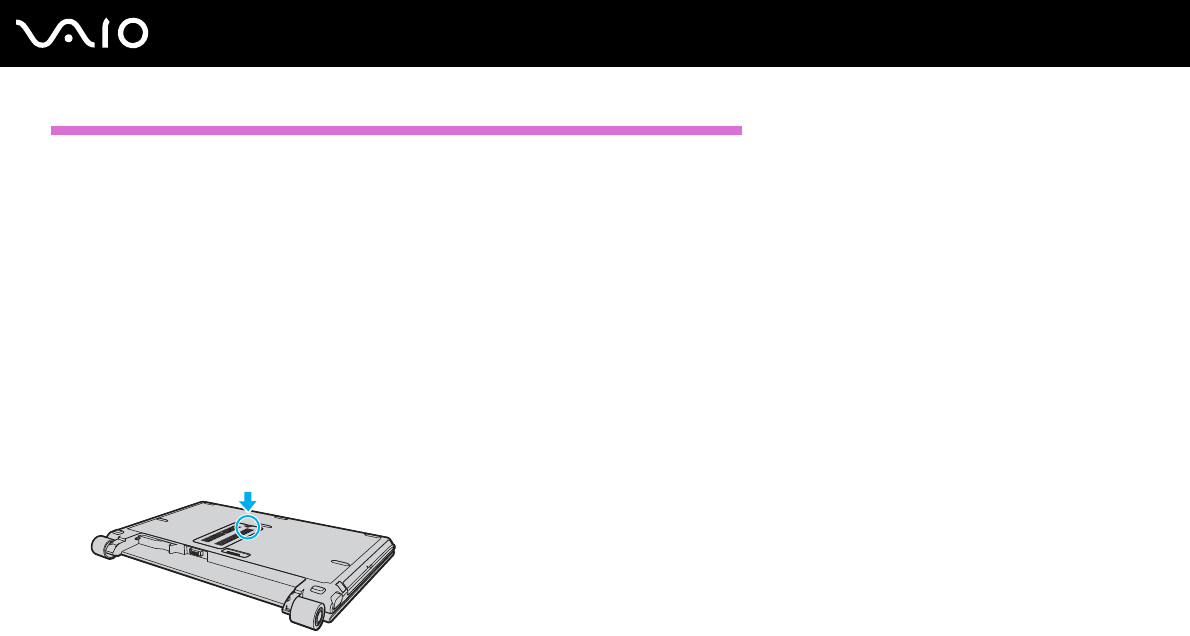
187
nN
Upgrading Your VAIO Computer
Except US model_END
❑High humidity
❑Handle the memory module with care. To avoid injuries to your hands and fingers, do not touch the edges of the
components and circuit boards inside your computer.
Replacing a Memory Module
To replace a memory module
1Shut down the computer and disconnect all peripheral devices.
2Unplug the computer and remove the battery pack.
3Wait until the computer cools down.
4Unscrew the screw (indicated by the arrow below) on the bottom of the computer and remove the memory module
compartment cover.
5Touch a metal object to discharge static electricity.
6Remove the currently installed memory module as follows:
❑Pull the latches in the direction of the arrows (1).
The memory module is released.
❑Make sure that the memory module tilts up and then pull it out in the direction of the arrow (2).

189
nN
Upgrading Your VAIO Computer
!
Do not touch any other components on the motherboard.
Be sure to insert the connector edge of the memory module into the slot while aligning the notch on the module with the small projection in the open
slot.
9Replace the memory module compartment cover.
10 Tighten the screw on the bottom of the computer.
11 Reinstall the battery pack and turn on the computer.
Viewing the Amount of Memory
To view the amount of memory
1Turn on the computer.
US model_BGN
2Click Start, All Programs, and VAIO Central.
The VAIO Central window appears.
3Click the Categories tab.
4Double-click the System Information folder.
5Double-click the System Information icon.
You can view the amount of system memory. If the additional memory does not appear, repeat the whole installation
procedure and restart the computer.
US model_END
Except US model_BGN
6Click Start, All Programs, and VAIO Control Center.

190
nN
Upgrading Your VAIO Computer
7Double-click the System Information folder in the VAIO Control Center window.
8Double-click the System Information icon in the System Information folder.
You can view the amount of system memory. If the additional memory does not appear, repeat the whole installation
procedure and restart the computer.
Except US model_END
Except China_END

191
nN
Precautions
Precautions
This section describes safety guidelines and precautions to help you protect your VAIO computer from potential damage.
❑On Handling the LCD Screen (page 191)
❑On Using the Power Source (page 192)
❑On Handling Your Computer (page 193)
❑On Using the Built-in MOTION EYE Camera (page 196)
❑On Handling Floppy Disks (page 196)
❑On Handling Discs (page 197)
❑On Using the Battery Pack (page 198)
❑On Using Headphones (page 200)
❑On Handling Memory Stick Media (page 200)
❑On Handling the Hard Disk (page 201)
❑On Updating Your Computer (page 203)
On Handling the LCD Screen
❑Do not leave the LCD screen facing the sun. This could damage the LCD screen. Be careful when using your computer
near a window.
❑Do not scratch the LCD screen or exert pressure on it. This could cause a malfunction.
❑Using your computer in low temperature conditions may produce a residual image on the LCD screen. This is not a
malfunction. When the computer returns to normal temperature, the screen returns to normal.

192
nN
Precautions
❑A residual image may appear on the LCD screen if the same image is displayed for a long period of time. The residual
image disappears in a while. You can use a screen saver to prevent residual images.
❑The LCD screen becomes warm during operation. This is normal and does not indicate a malfunction.
❑The LCD screen is manufactured using high-precision technology. You may, however, see tiny black points and/or bright
points (red, blue, or green) that continuously appear on the LCD screen. This is a normal result of the manufacturing
process and does not indicate a malfunction.
❑Avoid rubbing the LCD screen. This could damage the screen. Use a soft, dry cloth to wipe the LCD screen.
❑Do not change the LCD screen orientation setting in the Tablet PC Settings window even when another option is
available for selection, as it may make your computer unstable. Sony assumes no liabilities for any defects arising out of
the change.
IRX-3960_BGN
❑Do not exert pressure on the LCD screen lid with the lid closed, as it may make scratches on the LCD screen or soil the
LCD screen.
IRX-3960_END
On Using the Power Source
Except GVD model_BGN
Except China_BGN
❑See the online Specifications to check the power operation of your model.
Except China_END
Except GVD model_END
Except US model_BGN
Except Euro_BGN
❑See the printed Specifications sheet to check the power operation of your model.

193
nN
Precautions
Except Euro_END
Except US model_END
❑Do not share the AC outlet with other power-consuming equipment, such as a photocopier or shredder.
❑You can purchase a power strip with a surge protector. This device helps prevent damage to your computer caused by
sudden power surges, in an electrical storm, for example.
❑Do not place heavy objects on the power cord.
❑To disconnect the cord, pull it out by the plug. Never pull the cord itself.
❑Unplug your computer from the AC outlet if you are not planning to use the computer for a long period of time.
❑Make sure that the AC outlet is easily accessible.
❑When the AC adapter is not used, unplug it from the AC outlet.
❑Use the AC adapter supplied with your computer or genuine Sony products. Do not use any other AC adapter as it may
cause a malfunction.
On Handling Your Computer
❑Clean the cabinet with a soft cloth, which is dry or lightly moistened with a mild detergent solution. Do not use any type
of abrasive pad, scouring powder, or solvent such as alcohol or benzine, as these may damage the finish of your
computer.
❑If you drop a solid object or any liquid onto your computer, shut down the computer and then unplug it. You may want to
have the computer checked by qualified personnel before operating it again.
❑Do not drop your computer or place any objects on top of the computer.
❑Do not place your computer in a location subject to:
❑Heat sources, such as radiators or air ducts
❑Direct sunlight

194
nN
Precautions
❑Excessive dust
❑Moisture or rain
❑Mechanical vibration or shock
❑Strong magnets or speakers that are not magnetically shielded
US model_BGN
❑Ambient temperature of more than 95°F (35°C) or less than 41°F (5°C)
US model_END
Except US model_BGN
❑Ambient temperature of more than 35°C or less than 5°C
Except US model_END
❑High humidity
❑Do not place electronic equipment near your computer. The electromagnetic field of the computer may cause a
malfunction.
❑Provide adequate air circulation to prevent internal heat from building up. Do not place your computer on porous surfaces
such as rugs or blankets, or near material such as curtains or draperies that may block its air vents.
❑Your computer uses high-frequency radio signals and may cause interference to radio or TV reception. If this occurs,
relocate the computer a suitable distance away from the set.
❑Use only specified peripheral equipment and interface cables; otherwise, problems may occur.
❑Do not use cut or damaged connection cables.
US model_BGN

195
nN
Precautions
❑If your computer is brought directly from a cold location to a warm one, moisture may condense inside the computer. In
this case, allow at least one hour before turning on the computer. If any problems occur, unplug the computer and contact
an authorized Sony Service Center. To find the nearest center or agent, see Sony Support Information (page 246) or
visit the Sony online support Web site.
US model_END
Except US model_BGN
❑If your computer is brought directly from a cold location to a warm one, moisture may condense inside the computer. In
this case, allow at least one hour before turning on the computer. If any problems occur, unplug the computer and contact
VAIO HelpdeskVAIO-LinkVAIO HelpdeskVAIO-LinkVAIO HelpdeskSony Computing SupportSony Computing Support.
Except US model_END
❑Make sure you disconnect the power cord before cleaning your computer.
❑To avoid losing data if your computer is damaged, back up your data regularly.
US model_BGN
❑Do not exert pressure on the LCD screen or its edges when opening the LCD screen lid or lifting your computer. The LCD
screen may be sensitive to pressure or added stress and exerting pressure may damage the screen or cause the screen
to malfunction. To open the computer, hold the base with one hand and gently lift the LCD screen lid with the other. To
carry the computer, be sure to hold the computer with both hands.
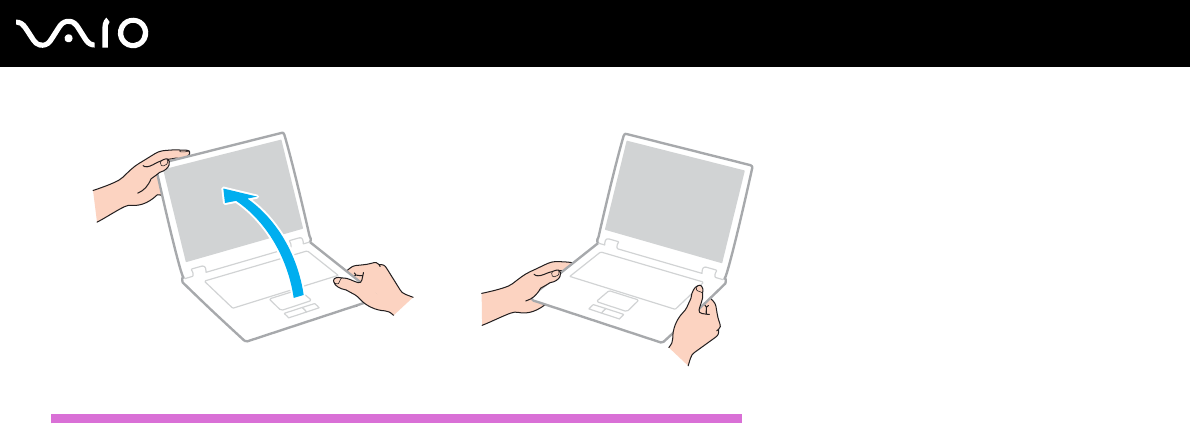
196
nN
Precautions
❑Use a carrying case specially designed to carry your computer.
US model_END
On Using the Built-in MOTION EYE Camera
❑Do not touch the front mirror plate over the lens of the built-in MOTION EYE camera, as it may make scratches on the
plate and such scratches will appear on the captured images.
❑Do not let the direct sunlight get into the scope of the built-in MOTION EYE camera regardless of your computer's power
state, as it may cause a malfunction of the camera.
❑The built-in MOTION EYE camera is disabled while videos or still images are imported from an i.LINK-compatible device
connected to the i.LINK port.
❑Clean the front mirror plate over the lens of the built-in MOTION EYE camera with a blower brush or a soft brush. If the
lens is extremely dirty, wipe it off with a soft dry cloth. Do not rub the plate, as it is force-sensitive.
On Handling Floppy Disks
❑Do not open the shutter manually or touch the surface of the floppy disk.

197
nN
Precautions
❑Keep floppy disks away from magnets.
❑Keep floppy disks away from direct sunlight and other sources of heat.
❑Keep floppy disks away from any liquid. Do not let them get wet. When you are not using your floppy disk, always remove
it from the floppy disk drive and use a storage case.
❑If the floppy disk comes with an adhesive label, make sure that the label is properly affixed. If the edge of the label is
curled up, the label may stick to the inside of the floppy disk drive and cause a malfunction or damage your floppy disk.
On Handling Discs
❑Do not touch the surface of the disc.
❑Do not drop or bend the disc.
❑Fingerprints and dust on the surface of a disc may cause read errors. Always hold the disc by its edges and central hole,
as shown below:
❑Proper care of the disc is essential to its continuous reliability. Do not use solvents (such as benzine, thinner, alcohol,
commercially available cleaners, or anti-static spray) which may cause damage to the disc.
❑For normal cleaning, hold the disc by its edge and use a soft cloth to wipe the surface from the center out.
❑If the disc is badly soiled, moisten a soft cloth with water, wring it out well, and use it to wipe the surface of the disc from
the center out. Wipe off any remaining moisture with a dry soft cloth.
❑Never affix an adhesive label to a disc. This will affect the use of the disc irreparably.

198
nN
Precautions
On Using the Battery Pack
US model_BGN
❑Do not leave battery packs in temperatures above 140°F (60°C), such as in a car parked in the sun or under direct
sunlight.
US model_END
Except US model_BGN
❑Do not leave battery packs in temperatures above 60°C, such as in a car parked in the sun or under direct sunlight.
Except US model_END
❑Battery life is shorter in a cold environment. This is due to decreased battery efficiency at low temperatures.
US model_BGN
❑Charge battery packs at temperatures between 50°F to 86°F (10°C to 30°C). Lower temperatures require longer charging
time.
US model_END
Except US model_BGN
❑Charge battery packs at temperatures between 10°C to 30°C. Lower temperatures require longer charging time.
Except US model_END
US model_BGN
❑This computer is designed to operate only with genuine Sony batteries.
US model_END
Euro model_BGN

199
nN
Precautions
❑Certain rechargeable batteries do not meet Sony quality and safety standards. For safety reasons this computer only
functions with genuine Sony batteries designed for this model. When installing another kind of battery, the battery will not
be charged and the computer will not function.
Euro model_END
GVD model_BGN
❑For your safety, it is highly recommended that you use genuine Sony rechargeable battery packs and AC adapters that
meet the quality assurance standard, supplied by Sony for your VAIO computer. Some VAIO computers may only function
with a genuine Sony battery.
GVD model_END
China model_BGN
!
Insert CS statement a-2 here!
China model_END
❑While the battery pack is in use or being charged, heat builds up in the battery pack. This is normal and is not cause for
concern.
❑Keep the battery pack away from all sources of heat.
❑Keep the battery pack dry.
❑Do not open or try to disassemble the battery pack.
❑Do not expose the battery pack to any mechanical shock.
❑If you are not using your computer for a long period of time, remove the battery pack from the computer to prevent damage
to the battery pack.
❑If, after fully charging the battery pack, the battery power is still low, the battery pack may be reaching the end of its life
and should be replaced.
❑You do not need to discharge the battery pack before recharging.

200
nN
Precautions
❑If you have not used the battery pack for a considerable amount of time, recharge the battery pack.
On Using Headphones
❑Road safety – Do not use headphones while driving, cycling, or operating any motorized vehicle. It may create a traffic
hazard and is illegal in some areas. It can also be potentially dangerous to play loud music while walking, especially at
pedestrian crossings.
❑Preventing hearing damage – Avoid using headphones at high volume. Hearing experts advise against continuous, loud
and extended play. If you experience a ringing in your ears, reduce the volume or discontinue use.
On Handling Memory Stick Media
❑Do not touch the Memory Stick media connector with your finger or metallic objects.
❑Use only the adhesive label supplied with the Memory Stick media as a label.
❑Do not bend, drop, or apply strong shock to the Memory Stick media.
❑Do not disassemble or modify Memory Stick media.
❑Do not let Memory Stick media get wet.
❑Do not use or store Memory Stick media in a location subject to:
❑Static electricity
❑Electrical noise
❑Extremely high temperatures, such as in a car parked in the sun
❑Direct sunlight
❑High humidity
❑Corrosive substances

201
nN
Precautions
❑Use the storage case supplied with the Memory Stick media.
❑Be sure to make a backup copy of your valuable data.
❑Keep the Memory Stick media out of reach of children. There is a risk of swallowing the media.
❑When using the Memory Stick Duo media, do not use a fine-tipped pen to write on the label adhered to the Memory Stick
Duo media. Exerting pressure on the media may damage internal components.
Except IRX-3960_BGN
❑Note the following when using the Memory Stick Duo media:
❑Be sure to insert a Memory Stick Duo media into the Memory Stick Duo adapter before inserting the adapter into the
slot. Inserting the empty adapter into the slot may cause a malfunction.
❑Do not use a fine-tipped pen to write on the label adhered to the Memory Stick Duo media. Exerting pressure on the
media may damage internal components.
Except IRX-3960_END
On Handling the Hard Disk
IRX-3960_BGN
Except China_BGN
Except GVD model_BGN
!
The following precautions apply to the models equipped with the hard disk drive. See the online Specifications to find whether your model is equipped
with the hard disk drive.
Except GVD model_END
Except China_END
GVD model_BGN

202
nN
Precautions
!
The following precautions apply to the models equipped with the hard disk drive. See the printed Specifications sheet to find whether your model is
equipped with the hard disk drive.
GVD model_END
IRX-3960_END
The hard disk drive has a high storage density and reads or writes data in a short time. However, it can be easily damaged
by mechanical vibration, shock, or dust.
Although the hard disk drive has the internal safety device to prevent losing data due to mechanical vibration, shock or dust,
you should be careful when handling your computer.
To avoid damaging your hard disk drive
❑Do not subject your computer to sudden movements.
❑Keep your computer away from magnets.
❑Do not place your computer in a location subject to mechanical vibration or in an unstable position.
❑Do not move your computer while the power is on.
❑Do not turn off the power or restart your computer while reading or writing data to the hard disk drive.
❑Do not use your computer in a place subject to extreme changes in temperature.
China model_BGN
❑Do not use your computer in a place at 3,000 meters or higher above sea level. The hard disk drive may not work properly
under such an environment due to low air pressure.
China model_END
✍
If the hard disk drive is damaged, the data cannot be restored.

203
nN
Precautions
On Updating Your Computer
Confirm that the latest updates have been installed on your computer using the following software applications so that the
computer can run more efficiently.
To confirm that they have been installed on the computer, follow these steps for each software application:
❑Windows Update
Click Start, All Programs, and Windows Update and then follow the on-screen instructions.
❑VAIO Update 3
Click Start, All Programs, VAIO Update 3, and VAIO Update Options and then follow the on-screen instructions.
If you have not yet installed the latest updates, install them with the above software. To download and install the updates on
the computer, the computer must be connected to the Internet. For information on how to connect the computer to the
Internet, see Using the Internet (page 72).

204
nN
Troubleshooting
Troubleshooting
US model_BGN
This section describes how to solve common problems you might encounter when using your VAIO computer. Many problems
have simple solutions. Try these suggestions before visiting the Sony online support Web site
at:
http://esupport.sony.com/EN/VAIO/ for
customers in USA,
http://www.sony.ca/support for customers in Canada,
http://esupport.sony.com/ES/VAIO/ for customers in Spanish speaking Latin American countries or areas, or
http://esupport.sony.com/ES/VAIO/BR/ for customers in Brazil.
US model_END
Except US model_BGN
This section describes how to solve common problems you might encounter when using your VAIO computer. Many problems
have simple solutions. Try these suggestions before contacting VAIO HelpdeskVAIO-LinkVAIO HelpdeskVAIO-LinkVAIO
HelpdeskSony Computing SupportSony Computing Support.
Except US model_END
❑Computer (page 205)
❑System Security (page 212)
❑Battery (page 213)
❑Built-in MOTION EYE Camera (page 214)
❑Internet (page 217)
❑Networking (page 218)
❑Bluetooth Technology (page 221)
❑Optical Discs (page 225)
❑Display (page 231)

205
nN
Troubleshooting
❑Printing (page 234)
❑Microphone (page 235)
❑Mouse (page 236)
❑Speakers (page 236)
❑Touch Pad (page 238)
❑Keyboard (page 239)
❑Floppy Disks (page 239)
❑Audio/Video (page 240)
❑Memory Stick Media (page 242)
❑Peripherals (page 244)
❑Docking Station (page 244)
Computer
What should I do if my computer does not start?
❑Make sure your computer is securely plugged into a power source and turned on. Make sure the power indicator shows
the power is on.
❑Make sure the battery pack is installed properly and charged.
❑Make sure the floppy disk drive (if applicable) is empty.
❑If your computer is plugged into a power strip or an uninterruptible power supply (UPS), make sure the power strip or UPS
is plugged into a power source and turned on.
❑If you are using an external display, make sure it is plugged into a power source and turned on. Make sure the brightness
and contrast controls are adjusted correctly. See the manual that came with your display for more information.

206
nN
Troubleshooting
❑Disconnect the AC adapter and remove the battery pack. Wait three to five minutes. Reinstall the battery pack, reattach
the AC adapter, and then press the power button to turn on your computer.
❑Condensation may cause your computer to malfunction. If this occurs, do not use the computer for at least one hour.
❑Remove any extra memory modules you may have installed since purchase.
❑Check that you are using the supplied Sony AC adapter. For your safety, use only genuine Sony rechargeable battery
packs and AC adapter, which are supplied by Sony for your VAIO computer.
What should I do if a BIOS error appears when I turn on my computer?
If the message "Press <F1> to resume, <F2> to setup" appears at the bottom of the screen, follow these steps:
1Press the F2 key.
The BIOS setup screen appears. If not, restart the computer and press the F2 key several times when the VAIO logo
appears.
2Set the date (month/day/year). Press the Enter key.
3Press the m key to select System Time, and then set the time (hour: minute: second). Press the Enter key.
4Press the , key to select the Exit tab, and then press the F9 key.
At the confirmation prompt, press the Enter key.
5Select Exit Setup, and press the Enter key.
At the confirmation prompt, press the Enter key.
Your computer restarts.
US model_BGN
If this occurs frequently, contact an authorized Sony Service Center. To find the nearest center or agent, see Sony Support
Information (page 246) or visit the Sony online support Web site.
US model_END

207
nN
Troubleshooting
Except US model_BGN
If this occurs frequently, contact VAIO HelpdeskVAIO-LinkVAIO HelpdeskVAIO-LinkVAIO HelpdeskSony Computing
SupportSony Computing Support.
Except US model_END
What should I do if the power indicator (Green) lights but my screen stays blank?
Follow these steps:
1Press and hold the power button for more than four seconds to check that the power indicator goes out. Then turn on your
computer again.
2If your computer screen still stays blank, unplug the AC adapter, remove the battery pack, and leave the computer for
about a minute. Then reinstall the battery pack, plug in the AC adapter, and turn on the computer again.
What should I do if my computer or software stops responding?
❑If your computer stops responding while a software application is running, press the Alt+F4 keys to close the application
window.
❑If the Alt+F4 keys do not work, click Start, the arrow next to the Lock button, and Shut Down to turn off your computer.
❑If your computer does not turn off, press the Ctrl+Alt+Delete keys and click the arrow next to the Shut down button
and Shut Down.
If the Windows Security window appears, click Shut Down.
!
Turning off your computer with the Ctrl+Alt+Delete keys or the power button may cause loss of unsaved data.
❑If your computer still does not turn off, press and hold the power button until the computer turns off.
❑Remove the AC adapter and battery pack.

208
nN
Troubleshooting
❑Try reinstalling the software.
❑Contact the software publisher or designated provider for technical support.
Why doesn't my computer enter Sleep or Hibernate mode?
Your computer may become unstable if the operating mode is changed before the computer completely enters Sleep or
Hibernate mode.
To restore your computer to normal operating stability
1Close all open programs.
2Click Start, the arrow next to the Lock button, and Restart.
3If your computer does not restart, press the Ctrl+Alt+Delete keys and click the arrow next to the Shut down button and
Restart.
4If this procedure does not work, press and hold the power button until the computer turns off.
!
Turning off your computer with the power button may cause loss of unsaved data.
What should I do if the battery indicator is flashing and my computer does not start?
❑This symptom could be due to the battery pack not being installed properly. To resolve this symptom, turn off your
computer and remove the battery pack. Then install the battery pack to the computer again. For details, see Installing
the Battery Pack (page 28).
US model_BGN
❑If the symptom persists after performing the above, it means the installed battery pack is not compatible. Remove the
battery pack and contact an authorized Sony Service Center. To find the nearest center or agent, see Sony Support
Information (page 246) or visit the Sony online support Web site.

209
nN
Troubleshooting
US model_END
Except US model_BGN
❑If the symptom persists after performing the above, it means the installed battery pack is not compatible. Remove the
battery pack and contact VAIO HelpdeskVAIO-LinkVAIO HelpdeskVAIO-LinkVAIO HelpdeskSony Computing
SupportSony Computing Support.
Except US model_END
What should I do if a message window, notifying of incompatibility or improper installation
of the battery pack, appears and my computer enters Hibernate mode?
❑This symptom could be due to the battery pack not being installed properly. To resolve this symptom, turn off your
computer and remove the battery pack. Then install the battery pack to the computer again. For details, see Installing
the Battery Pack (page 28).
US model_BGN
❑If the symptom persists after performing the above, it means the installed battery pack is not compatible. Remove the
battery pack and contact an authorized Sony Service Center. To find the nearest center or agent, see Sony Support
Information (page 246) or visit the Sony online support Web site.
US model_END
Except US model_BGN
❑If the symptom persists after performing the above, it means the installed battery pack is not compatible. Remove the
battery pack and contact VAIO HelpdeskVAIO-LinkVAIO HelpdeskVAIO-LinkVAIO HelpdeskSony Computing
SupportSony Computing Support.
Except US model_END

210
nN
Troubleshooting
Why does the System Properties window display a slower CPU speed than the
maximum?
This is normal. Because your computer's CPU utilizes a type of CPU speed controlling technology for power conservation
purposes, System Properties may display the CPU's current speed instead of the maximum speed.
What should I do if Windows does not start, showing a message, when I start my
computer?
If you enter a wrong power-on password three times consecutively, the Enter Onetime Password message appears. If you
enter a wrong power-on password three times consecutively again, the System Disabled message appears and Windows
will not start. Press and hold the power button for more than four seconds to check that the power indicator goes off. Wait for
10 or 15 seconds, then restart your computer and enter the correct password. When entering the password, check that the
Num lock indicator and Caps lock indicator are off. If any are lit, press the Num Lk key or the Caps Lock key to turn off the
indicator before entering the password.
What should I do if my game software does not work or it keeps crashing?
❑Check the Web site of the game if there are any patches or updates to download.
❑Make sure you have installed the latest video driver.
❑On some VAIO models, the graphics memory is shared with the system. The optimal graphic performance in this case is
not guaranteed.
What should I do if I cannot remember the BIOS password?
US model_BGN
If you have forgotten the BIOS password, contact an authorized Sony Service Center to reset it. A reset fee will be charged.
To find the nearest center or agent, see Sony Support Information (page 246) or visit the Sony online support Web site.

211
nN
Troubleshooting
US model_END
Except US model_BGN
If you have forgotten the BIOS password, contact VAIO HelpdeskVAIO-LinkVAIO HelpdeskVAIO-LinkVAIO HelpdeskSony
Computing SupportSony Computing Support to reset it. A reset fee will be charged.
Except US model_END
Why does it take time before my computer starts?
Except IRX-3960_BGN
If Norton Internet Security's Personal Firewall is active, it may take some time before the desktop screen appears due to
network security checkups.
Except IRX-3960_END
IRX-3960_BGN
❑If Norton Internet Security's Personal Firewall is active, it may take some time before the desktop screen appears due to
network security checkups.
❑If the TPM is enabled, it will take longer before the VAIO logo appears due to security checks at computer startup.
IRX-3960_END
Why doesn't my screen turn off when the time selected for the automatic turn-off action
has passed?
The VAIO Original Screen Saver disables the timer setting, which you can select using the Windows power options, for your
screen to turn off.
Select the screen saver other than the VAIO Original Screen Saver.

212
nN
Troubleshooting
What should I do if I cannot boot my computer from the USB floppy disk drive connected
to the computer?
To boot your computer from the USB floppy disk drive, you need to change the boot device.
Turn on your computer and press the F11 key when the VAIO logo appears.
System Security
How can I protect my computer against security threats, such as viruses?
The Microsoft Windows operating system is preinstalled on your computer. The best way to protect your computer against
security threats, such as viruses, is to download and install the latest Windows updates regularly.
You can get important Windows updates by doing the following:
!
Your computer must be connected to the Internet before you can receive updates.
1Connect to the Internet.
2Double-click the Windows Security Alerts icon on the taskbar.
3Follow the on-screen instructions to set up automatic or scheduled updates.
How do I keep my antivirus software updated?
You can keep the Norton Internet Security software program current with the latest updates from Symantec Corporation.
To download and install the latest security update
1Click Start, All Programs, Norton Internet Security, and Norton Internet Security.
2Click the item to update the software on the left pane.

213
nN
Troubleshooting
3Follow the on-screen instructions to select and download updates.
Battery
How do I find the battery charging status?
See Charging the Battery Pack (page 31).
When is my computer using AC power?
When your computer is directly connected to the AC adapter, it uses AC power, even if the battery pack is installed.
When should I recharge the battery pack?
❑When the battery level falls below 10 percent.
❑When both the battery and power indicators blink.
❑When you have not used the battery pack for a long period of time.
When should I replace the battery pack?
If the battery power is still low after charging it, the battery pack may be reaching the end of its life and should be replaced.
Should I be concerned that the installed battery pack is warm?
No, it is normal for the battery pack to be warm when it is powering your computer.

214
nN
Troubleshooting
Can my computer enter Hibernate mode while using battery power?
Your computer can enter Hibernate mode while using battery power, but some software programs and peripheral devices
prevent the system from entering Hibernate mode. If you are using a program that prevents the system from entering
Hibernate mode, save your data frequently to avoid losing data. See Using Hibernate Mode (page 171) for information on
how you can manually activate Hibernate mode.
Built-in MOTION EYE Camera
Why does the viewer window show no images or poor-quality images?
❑The built-in MOTION EYE camera cannot be shared by more than one software application. If another software
application is using the camera, exit the application before using the built-in MOTION EYE camera.
❑The video memory of your computer may have become insufficient for displaying images from the built-in MOTION EYE
camera. Lowering the resolution or reducing the colors of the LCD screen might help.
❑The viewer window may show some noises, for example horizontal streaks, if you view a rapid-moving object. This is
normal and does not indicate a malfunction.
❑If the problem persists, restart your computer.
Why are captured images poor in quality?
❑The images captured under the fluorescent lamp may show reflection of the light.
❑A dark portion in captured images may appear as a noise.
❑If the front mirror plate over the lens is dirty, you cannot take a clear shot. Clean the lens. See On Using the Built-in
MOTION EYE Camera (page 196).

215
nN
Troubleshooting
Why do captured images contain dropped frames and audio interruptions?
❑The effect settings on your software application may have caused dropped frames. See the help file on your software
application for more information.
❑There may be more software applications running than your computer can handle. Exit the applications that you are not
currently using.
❑The power management function of your computer may have been activated. Check the CPU performance.
Why does movie playback show dropped frames when my computer is running on the
battery?
The battery pack is running out of power. Connect your computer to an AC power source.
Why do the images captured by the built-in MOTION EYE camera flicker?
This problem occurs when you use the camera under fluorescent lights due to the mismatch between lighting output
frequency and shutter speed.
To reduce flicker noise, change the pointing direction of the camera or the brightness of camera images. In some software
applications, you can set an appropriate value to one of the camera properties (e.g. LightSource, Flickness, etc.) to
eliminate flicker noise.
Why is the video input from the built-in MOTION EYE camera suspended for a few
seconds?
The video input may be suspended for a few seconds if:
❑a shortcut key with the Fn key is used.
❑the CPU load increases.

216
nN
Troubleshooting
This is normal and does not indicate a malfunction.
Why can't I use the built-in MOTION EYE camera?
❑The built-in MOTION EYE camera cannot be shared by more than one software application. If another software
application is using the camera, exit the application before using the built-in MOTION EYE camera.
❑If the problem persists, you must reinstall the driver software for the camera. Follow these steps:
1Click Start, Control Panel, Hardware and Sound, and Device Manager.
2Double-click Imaging devices.
3Right-click the device name for your camera and click Update Driver Software.
What should I do if my computer becomes unstable when it enters a power saving mode
while the built-in MOTION EYE camera is in use?
❑Do not place your computer into Sleep or Hibernate mode while you are using the built-in MOTION EYE camera.
❑If your computer automatically enters Sleep or Hibernate mode, change the corresponding power saving mode setting.
For changing the setting, see Using the Power Saving Modes (page 168).
What should I do if I cannot successfully capture videos in the WMV format with the built-
in MOTION EYE camera?
Change the record format to the MPEG-1 format, or click the VAIO Camera Utility icon on the taskbar and the Advanced
Setting tab on the Properties window and cancel the Low Light check box.

217
nN
Troubleshooting
Internet
What should I do if my modem does not work?
❑Make sure the telephone cable is securely plugged into the modem port on your computer and the wall jack.
❑Make sure the telephone cable is working. Plug the cable into an ordinary telephone and listen for a dial tone.
❑Make sure that the telephone number the program is dialing is correct.
❑Make sure the software you are using is compatible with your computer's modem. (All preinstalled Sony programs are
compatible.)
❑Make sure the modem is the only device connected to your telephone line.
❑Follow these steps to check the settings:
1Click Start and Control Panel.
2Click Hardware and Sound.
3Click Phone and Modem Options.
4On the Modems tab, check that your modem is listed.
5On the Dialing Rules tab, check the location information is correct.
Why is my modem connection slow?
Your computer is equipped with a V.92/ V.90 compatible modem. Many factors may influence modem connection speed,
including telephone line noise or compatibility with telephone equipment, such as fax machines or other modems. If you think
your modem is not connecting properly to other PC-based modems, fax machines, or your Internet Service Provider (ISP),
do any of the following:
❑Ask your telephone company to verify your telephone line is free of any line noise.

218
nN
Troubleshooting
❑If your problem is fax-related, make sure there are no problems with the fax machine you are calling and that it is
compatible with fax modems.
❑If you are having a problem connecting with your ISP, make sure the ISP is not experiencing technical problems.
❑If you have a second telephone line, try connecting the modem to that line.
Networking
What should I do if my computer cannot connect to a wireless LAN access point?
❑Connection availability is affected by distance and obstructions. You may need to move your computer away from
obstructions or closer to any access point you may be using.
❑Make sure the WIRELESS or WIRELESS LAN switch is on and the Wireless LAN indicator is lit on your computer.
❑Make sure power to the access point is on.
❑Follow these steps to check the settings:
1Click Start and Control Panel.
2Click View network status and tasks under Network and Internet.
3Click Connect to a network to confirm that your access point is selected.
❑Make sure the encryption key is correct.
❑Make sure Maximum Performance is selected for Wireless Adapter Settings in the Power Options window. Selecting
any other option may result in a communication failure. To change the settings, follow these steps:
1Right-click the power status icon on the taskbar and select Power Options.
2Click Change plan settings under the current power plan.
3Click Change advanced power settings.
The Power Options window appears.

219
nN
Troubleshooting
4Select the Advanced settings tab.
5Double-click Wireless Adapter Settings and Power Saving Mode.
6Select Maximum Performance from the drop-down list both for On battery and Plugged in.
What should I do if I cannot access the Internet?
❑Check the access point settings. See the manual that came with your access point for more information.
❑Make sure your computer and the access point are connected to one another.
❑Move your computer away from obstructions or closer to any access point you may be using.
❑Make sure your computer is properly configured for Internet access.
❑Make sure Maximum Performance is selected for Wireless Adapter Settings in the Power Options window. Selecting
any other option may result in a communication failure. Follow the steps in What should I do if my computer cannot
connect to a wireless LAN access point? (page 218) to change the settings.
Why is the data transfer speed slow?
❑The wireless LAN data transfer speed is affected by distance and obstructions between devices and access points. Other
factors include device configurations, radio conditions, and software compatibility. To maximize the data transfer speed,
move your computer away from obstructions or closer to any access point you may be using.
❑If you are using a wireless LAN access point, the device may be temporarily overloaded depending on how many other
devices are communicating via the access point.
❑If your access point interferes with other access points, change the access point channel. See the manual that came with
your access point for more information.
❑Make sure Maximum Performance is selected for Wireless Adapter Settings in the Power Options window. Selecting
any other option may result in a communication failure. Follow the steps in What should I do if my computer cannot
connect to a wireless LAN access point? (page 218) to change the settings.

220
nN
Troubleshooting
How do I avoid data transfer interruptions?
❑When your computer is connected to an access point, data transfer interruptions may occur when using large files or if
the computer is in close proximity to microwaves and cordless telephones.
❑Move your computer closer to the access point.
❑Make sure the access point connection is intact.
❑Change the access point channel. See the manual that came with your access point for more information.
❑Make sure Maximum Performance is selected for Wireless Adapter Settings in the Power Options window. Selecting
any other option may result in a communication failure. Follow the steps in What should I do if my computer cannot
connect to a wireless LAN access point? (page 218) to change the settings.
What are channels?
❑Wireless LAN communication occurs on divided frequency bands known as channels. Third-party wireless LAN access
point channels may be preset to different channels from Sony devices.
❑If you are using a wireless LAN access point, see connectivity information contained in the manual that came with your
access point.
Why does the network connection stop when I change the encryption key?
Two computers with the wireless LAN functionality may lose a peer-to-peer network connection if the encryption key is
changed. You can either change the encryption key back to the original profile or re-enter the key on both computers so the
key matches.

221
nN
Troubleshooting
Bluetooth Technology
What should I do if other Bluetooth devices cannot discover my computer?
❑Make sure both devices have the Bluetooth functionality enabled.
❑If the Bluetooth indicator is off, turn on the WIRELESS switch.
❑You cannot use the Bluetooth functionality when your computer is in a power saving mode. Return to Normal mode, then
turn on the WIRELESS switch.
US model_BGN
❑Your computer and the device may be too far apart. Wireless Bluetooth technology works best when the devices are within
33 feet (10 meters) of each other.
US model_END
Except US model_BGN
❑Your computer and the device may be too far apart. Wireless Bluetooth technology works best when the devices are within
10 meters of each other.
Except US model_END
Why can't my computer discover other Bluetooth devices?
If the connected device is also connected to other devices, it may not appear in the Bluetooth utility software or you may not
be able to communicate with the device.
What should I do if I cannot find the Bluetooth device with which I want to communicate?
❑Check that the Bluetooth functionality of the device with which you want to communicate is on. See the other device's
manual for more information.

222
nN
Troubleshooting
❑If the device with which you want to communicate is already communicating with another Bluetooth device, it may not be
found or it may not be able to communicate with your computer.
❑To allow other Bluetooth devices to communicate with your computer, right-click the Bluetooth icon on the taskbar and
select Options from the menu to open the Options window. Then, check if proper security modes are selected on the
Security tab. For details on the security modes, see the help file on the Bluetooth utility software.
See Communicating with Another Bluetooth Device (page 88) for more information.
What should I do if other Bluetooth devices cannot connect to my computer?
❑Make sure the other device is authenticated.
❑Your computer may not allow connections from other devices. To enable Bluetooth device connections, follow these steps:
1Right-click the Bluetooth icon on the taskbar.
2Select Options from the menu.
The Options window appears.
3Check if Standard or Low is selected for the Bluetooth security level on the Security tab.
If a custom Bluetooth security level is selected, click the Default level button.
4Click OK.
US model_BGN
❑The data transfer distance can be shorter than 33 feet (10 meters) depending on existing obstacles between the two
devices, on radio wave quality, and on the operating system or the software in use. Move your computer and Bluetooth
devices closer to each other.
US model_END
Except US model_BGN

223
nN
Troubleshooting
❑The data transfer distance can be shorter than 10 meters depending on existing obstacles between the two devices, on
radio wave quality, and on the operating system or the software in use. Move your computer and Bluetooth devices closer
to each other.
Except US model_END
❑If the device with which you want to communicate is already communicating with another Bluetooth device, it may not be
found or it may not be able to communicate with your computer.
❑Check that the Bluetooth functionality of the device with which you want to communicate is on. See the other device's
manual for more information.
Why is my Bluetooth connection slow?
❑The data transfer speed depends on the obstacles and/or the distance between the two devices, on the radio wave quality,
and on the operating system or the software in use. Move your computer and Bluetooth devices closer to each other.
❑The 2.4 GHz radio frequency used by Bluetooth and wireless LAN devices is also used by other devices. Bluetooth
devices incorporate technology that minimizes interference from other devices using the same wavelength, however,
communication speed and connection range may be reduced. Interference from other devices may also stop
communication altogether.
❑Connection availability is affected by distance and obstructions. You may need to move your computer away from
obstructions or closer to the device to which it is connected.
❑Identify and remove obstacles between your computer and the device to which it is connected.
❑Note that due to limitations of the Bluetooth standard, large files may occasionally be corrupted during continuous transfer
due to electromagnetic interference from the environment.

224
nN
Troubleshooting
Why can't I connect to service supported by the target Bluetooth device?
Connection is only possible for services also supported by the computer with the Bluetooth functionality. For more details,
see the help file on the Bluetooth utility software.
Can I use a device with Bluetooth technology on airplanes?
With Bluetooth technology, your computer transmits a radio frequency of 2.4 GHz. Sensitive locations, such as hospitals and
airplanes, may have restrictions on use of Bluetooth devices, due to radio interference. Check with facility staff to see if use
of the Bluetooth functionality on the computer is permitted.
Why can't I connect to a Bluetooth device by specifying its IP address on a Personal Area
Network (PAN)?
The Bluetooth utility software uses Dynamic Host Configuration Protocol (DHCP) to assign IP addresses to active wireless
devices. If you specify a fixed IP address for the device to which you want to connect, the utility cannot assign a dynamic IP
address to the device and fails. Do not specify IP addresses when using a PAN.
Why can't I use the Bluetooth functionality when I log onto my computer as a user with a
standard user account?
The Bluetooth functionality may not be available to a user with a standard user account on your computer. Log onto the
computer as a user with administrator rights.
Why can't I connect to a Bluetooth device in Personal Area Network User mode?
If the device to which you want to connect supports Bluetooth communication in Personal Area Network User mode only, you
cannot establish a connection from your computer.

225
nN
Troubleshooting
Why can't I use the Bluetooth utility software when I switch a user?
If you switch a user without logging off your system, the Bluetooth utility software will not work successfully. Be sure to log off
before switching a user. To log off your system, click Start, the arrow next to the Lock button, and Log Off.
Optical Discs
Why does my computer freeze when I try to read a disc?
IRX-3960_BGN
China model_BGN
!
This Q & A entry applies to models with the built-in optical disc drive only. See the printed Specifications sheet to find whether your model is equipped
with the optical disc drive.
China model_END
IRX-3960_END
The disc that your computer is trying to read may be dirty or damaged. Follow these steps:
1Press the Ctrl+Alt+Delete keys and click the arrow next to the Shut down button and Restart to restart the computer.
2Remove the disc from the optical disc drive.
3Check the disc for dirt or damage. If you need to clean the disc, see On Handling Discs (page 197) for instructions.
What should I do if the drive tray does not open?
IRX-3960_BGN
China model_BGN

226
nN
Troubleshooting
!
This Q & A entry applies to models with the built-in optical disc drive only. See the printed Specifications sheet to find whether your model is equipped
with the optical disc drive.
China model_END
IRX-3960_END
❑Make sure your computer is on.
Except IRX-3960_BGN
❑Press the drive eject button.
❑If the drive eject button does not work, click Start and Computer. Right-click the optical disc drive icon, and select Eject
from the shortcut menu.
❑If none of the above options work, insert a thin, straight object (such as a paper clip) in the manual eject hole on the optical
disc drive.
Except IRX-3960_END
IRX-3960_BGN
❑If power supply to the optical disc drive is disabled by VAIO Power Management, the substitute drive eject button on the
optical disc drive will not work. Use the disc drive eject button located above the keyboard. Note that it will take a while to
eject the drive tray if the optical disc drive is not powered.
❑If the disc drive eject button does not work, click Start and Computer. Right-click the optical disc drive icon, and select
Eject from the shortcut menu.
❑If none of the above options work, insert a thin, straight object (such as a paper clip) in the manual eject hole near the
substitute drive eject button.
IRX-3960_END
❑Try restarting your computer.

227
nN
Troubleshooting
What should I do if I cannot play a disc properly on my computer?
IRX-3960_BGN
China model_BGN
!
This Q & A entry applies to models with the built-in optical disc drive only. See the printed Specifications sheet to find whether your model is equipped
with the optical disc drive.
China model_END
IRX-3960_END
❑Make sure the disc is inserted into the optical disc drive with the label facing upward.
❑Make sure the necessary program(s) is installed according to the manufacturer's instructions.
❑If a disc is dirty or damaged, your computer will stop responding. Follow these steps:
1Press the Ctrl+Alt+Delete keys and click the arrow next to the Shut down button and Restart to restart the computer.
2Remove the disc from the optical disc drive.
3Check the disc for dirt or damage. If you need to clean the disc, see On Handling Discs (page 197) for instructions.
❑If you are playing a disc and cannot hear sound, do any of the following:
IRX-3960_BGN
❑Check if the volume is turned off or minimized by the Fn+F2 or Fn+F3 buttons, respectively.
IRX-3960_END
❑Right-click the volume icon on the taskbar and click Open Volume Mixer to check the settings.
❑Check the volume setting in the audio mixer.
❑If you are using external speakers, check the volume settings on the speakers and the connections between the
speakers and your computer.

228
nN
Troubleshooting
❑Make sure the correct driver software is installed. Follow these steps:
1Click Start and Control Panel.
2Click System and Maintenance.
3Click System.
4Click Device Manager on the left pane.
The Device Manager window appears with a listing of your computer's hardware devices.
If an "X" or an exclamation point appears on the listed device, you may need to enable the device or reinstall the
drivers.
5Double-click the optical disc drive device to open a list of the optical disc drives of your computer.
6Double-click the desired drive.
You can confirm the driver software by selecting the Driver tab, and clicking Driver Details.
7Click OK to close the window.
❑Make sure an adhesive label is not affixed to a disc. Adhesive labels can come off while the disc is in the optical disc drive
and damage the drive or cause it to malfunction.
❑If a region code warning appears, the disc may be incompatible with the optical disc drive. Check the DVD package to
make sure the region code is compatible with the optical disc drive.
❑If you notice condensation on your computer, do not use the computer for at least one hour. Condensation can cause the
computer to malfunction.
❑Make sure your computer is running on AC power supply and try the disc again.
What should I do if I cannot write data to CD media?
IRX-3960_BGN
China model_BGN

229
nN
Troubleshooting
!
This Q & A entry applies to models with the built-in optical disc drive only. See the printed Specifications sheet to find whether your model is equipped
with the optical disc drive.
China model_END
IRX-3960_END
❑Make sure you neither launch any software application nor allow any to launch automatically, not even a screen saver.
❑Stop using the keyboard.
❑If you are using a CD-R/RW disc with an adhesive label affixed, replace it with one with no affixed adhesive label. Using
a disc with an affixed adhesive label could cause a write error or other damage.
What should I do if I cannot write data to DVD media?
US model_BGN
Except IRX-3960_BGN
!
This Q & A entry applies to selected models only. See the online Specifications to find the type of your optical disc drive, and then Reading and Writing
Optical Discs (page 52) to find about the supported disc media.
US model_END
Euro model_BGN
!
This Q & A entry applies to selected models only. See the online Specifications to find the type of your optical disc drive, and then Reading and Writing
Optical Discs (page 52) to find about the supported disc media.
Euro model_END
GVD model_BGN

230
nN
Troubleshooting
!
This Q & A entry applies to selected models only. See the printed Specifications sheet to find the type of your optical disc drive, and then Reading and
Writing Optical Discs (page 52) to find about the supported disc media.
GVD model_END
China model_BGN
!
This Q & A entry applies to selected models only. See the printed Specifications sheet to find the type of your optical disc drive, and then Reading and
Writing Optical Discs (page 52) to find about the supported disc media.
China model_END
Except IRX-3960_END
IRX-3960_BGN
China model_BGN
!
This Q & A entry applies to models with the built-in optical disc drive only. See the printed Specifications sheet to find whether your model is equipped
with the optical disc drive.
China model_END
IRX-3960_END
❑Make sure you are using the correct DVD recordable media.
❑Check which DVD recordable format is compatible with your optical disc drive. Note the possibility that some brands of
DVD recordable media do not work.
What should I do if I cannot use the optical disc drive after unplugging USB Mass Storage
Device in the Safely Remove Hardware window?
The optical disc drive will be disabled if you unplug USB Mass Storage Device in the Safely Remove Hardware window.
To enable the optical disc drive again, do either of the following:

231
nN
Troubleshooting
❑Right-click the optical disc drive icon on the taskbar and select the option to enable power supply to the optical disc drive.
❑Use VAIO Power Management enable power supply to the optical disc drive. See Managing Power with VAIO Power
Management (page 173) for more information.
Display
Why did my screen go blank?
❑Your computer screen may go blank if the computer loses power or enters a power saving mode (Sleep or Hibernate). If
the computer is in LCD (Video) Sleep mode, press any key to bring the computer back into Normal mode. See Using the
Power Saving Modes (page 168) for more information.
❑Make sure your computer is securely plugged into a power source and turned on. Make sure the power indicator shows
the power is on.
❑If your computer is using battery power, make sure the battery pack is installed properly and is charged. See Using the
Battery Pack (page 28) for more information.
❑If the display mode is set to the external display, press the Fn+F7 keys. See Combinations and Functions with the Fn
Key (page 37) for more information.
Why doesn't my screen display a video?
❑If the external display is selected for the display output and the external display is disconnected, you cannot display a
video on your computer screen. Stop video playback, change the display output to the computer screen, and then restart
video playback. See Selecting Display Modes (page 105). Alternatively, you can press the Fn+F7 keys to change the
display output. See Combinations and Functions with the Fn Key (page 37) for more information.
❑The video memory of your computer may be insufficient for displaying high resolution videos. In this case, lower the
resolution of the LCD screen.

232
nN
Troubleshooting
To change the screen resolution, follow these steps:
1Right-click the desktop and select Personalize from the shortcut menu.
2Click Display Settings.
The Display Settings window appears.
3Move the slider under Resolution to the left to reduce or to the right to increase the screen resolution.
!
You can confirm the value of the total available graphics memory and video memory. Right-click on the desktop, select Personalize from the shortcut
menu, and click Display Settings, Advanced Settings, and the Adaptor tab. The value may be displayed differently from the actual memory on your
computer.
What should I do if my screen is dark?
Press the Fn+F6 keys to brighten your computer screen.
What should I do if the LCD brightness of my screen changes?
The LCD brightness setting, adjusted with the Fn+F5/F6 keys, is temporary and may be restored to the original setting when
your computer returns to Normal mode from Sleep or Hibernate mode. To save your preference for the brightness, follow
these steps:
1Right-click the power status icon on the taskbar and select Power Options.
2Click Change plan settings under the current power plan.
3Click Change advanced power settings.
The Power Options window appears.
4Select the Advanced settings tab.
5Double-click Display.
6Adjust the LCD brightness setting in the item for brightness adjustment.

233
nN
Troubleshooting
What should I do if the external display stays blank?
Except US model_BGN
If you cannot change the display output with the Fn+F7 keys, you need to change the settings for the external display with
VAIO Control Center. To change the settings, launch the VAIO Control Center, select the control item for the external
display, and then click to select the check box for changing the options to detect the external display. Then, try the Fn+F7
keys to change the display output.
Except US model_END
US model_BGN
If you cannot change the display output with the Fn+F7 keys, you need to change the settings for the external display with
VAIO Central. To change the settings, launch the VAIO Central, click the Categories tab and select the control item for the
external display, and then click to select the check box for changing the options to detect the external display. Then, try the
Fn+F7 keys to change the display output.
US model_END
How do I run Windows Aero?
!
This Q & A entry applies to selected models only.
To run Windows Aero, follow these steps:
1Click Start and Control Panel.
2Click Customize colors under Appearance and Personalization.
3Click Open classic appearance properties for more color options.
The Appearance Settings window appears.
4Select Windows Aero from the Color scheme options on the Appearance tab.

234
nN
Troubleshooting
5Click OK.
For information about the Windows Aero features, such as Windows Flip 3D, see Windows Help and Support.
Printing
What should I do if I cannot print a document?
❑Make sure your printer is on, and the printer cable is securely connected to the ports on the printer and computer.
❑Make sure your printer is compatible with the Windows operating system installed on your computer.
❑You may need to install the printer driver software before you use your printer. See the manual that came with your printer
for more information.
❑If your printer is not functioning after your computer resumes from a power saving mode (Sleep or Hibernate), then restart
the computer.
❑If the bidirectional communication functions are provided with your printer, disabling the functions on your computer may
enable printing. Follow these steps:
1Click Start and Control Panel.
2Click Printer under Hardware and Sound.
3Right-click the printer icon and select Properties.
4Click the Ports tab.
5Click to cancel the Enable bidirectional support check box.
6Click OK.
This change to the settings disables the bidirectional communication functions of the printer, such as data transfer, status
monitoring, and remote panel.

235
nN
Troubleshooting
Except IRX-3960_BGN
When your printer is connected to the port replicator, check the port replicator to see if it is connected to an AC power
source.
Except IRX-3960_END
IRX-3960_BGN
When your printer is connected to the docking station, check the docking station to see if it is connected to an AC power
source.
IRX-3960_END
Microphone
What should I do if my microphone does not work?
If you are using an external microphone, make sure the microphone is turned on and is properly plugged into the microphone
jack on your computer.
How can I prevent microphone feedback?
Microphone feedback occurs when the microphone receives the sound from a sound output device, such as a speaker.
To prevent this problem:
❑Keep the microphone away from a sound output device.
❑Turn down the volume of the speakers and the microphone.

236
nN
Troubleshooting
Mouse
What should I do if my computer does not recognize my mouse?
❑Make sure your mouse is securely plugged into the port.
❑Restart your computer with your mouse connected.
What should I do if the pointer does not move when I use my mouse?
❑Make sure another mouse is not connected.
❑If the pointer does not move while a software application is running, press the Alt+F4 keys to close the application window.
❑If the Alt+F4 keys do not work, click Start, the arrow next to the Lock button, and Restart to restart your computer.
❑If your computer does not restart, press the Ctrl+Alt+Delete keys and click the arrow next to the Shut down button and
Restart.
If the Windows Security window appears, click Restart.
❑If this procedure does not work, press and hold the power button until the computer turns off.
!
Turning off your computer with the power button may cause loss of unsaved data.
Speakers
What should I do if my external speakers do not work?
❑Make sure your speakers are properly connected and the volume is turned up loud enough to hear sound.
❑Make sure your speakers are designed for computer use.
❑If your speakers have a muting button, set the button to off.

237
nN
Troubleshooting
IRX-3960_BGN
❑The volume may have been turned off by the Fn+F2 keys. Press them once again.
❑The volume may have been minimized by the Fn+F3 keys. Press the Fn+F4 keys to turn up the volume loud enough to
hear sound.
IRX-3960_END
❑If your speakers require external power, make sure the speakers are connected to a power source. See the manual that
came with your speakers for more information.
What should I do if I do not hear sound from the built-in speakers?
❑If you are using a program that has its own volume control, make sure the volume control is properly set. See the
program's help file for more information.
❑Make sure the speaker volume is turned up loud enough and the audio option is enabled.
IRX-3960_BGN
❑The volume may have been turned off by the Fn+F2 keys. Press them once again.
❑The volume may have been minimized by the Fn+F3 keys. Press the Fn+F4 keys to turn up the volume loud enough to
hear sound.
IRX-3960_END
❑Check the Windows volume controls by clicking the volume icon on the taskbar.
Except IRX-3960_BGN
What should I do if I do not hear microphone or line-in sound from my HDMI-compatible
TV?

238
nN
Troubleshooting
Except IRX-3960_END
Touch Pad
What should I do if the touch pad does not work?
US model_BGN
❑You may have disabled the touch pad without connecting a mouse to your computer.
US model_END
Except US model_BGN
❑You may have disabled the touch pad without connecting a mouse to your computer. See Using the Touch Pad (page
42).
Except US model_END
❑Make sure that a mouse is not connected to your computer.
❑If the pointer does not move while a software application is running, press the Alt+F4 keys to close the application window.
❑If the Alt+F4 keys do not work, click Start, the arrow next to the Lock button, and Restart to restart your computer.
❑If your computer does not restart, press the Ctrl+Alt+Delete keys and click the arrow next to the Shut down button and
Restart.
If the Windows Security window appears, click Restart.
❑If this procedure does not work, press and hold the power button until the computer turns off.
!
Turning off your computer with the power button may cause loss of unsaved data.

239
nN
Troubleshooting
Keyboard
What should I do if the keyboard configuration is wrong?
The language layout of your computer's keyboard is labeled on the packaging box. If you choose a different regional keyboard
when you complete the Windows setup, the key configuration will be mismatched.
To change the keyboard configuration, follow these steps:
1Click Start and Control Panel
2Click Clock, Language, and Region, and click Regional and Language Options.
3Change the settings as desired.
What should I do if I cannot enter certain characters with the keyboard?
If you cannot enter U, I, O, P, J, K, L, M, and so on, the Num Lk key may be activated. Check that the Num lock indicator is
off. If the Num lock indicator is on, press the Num Lk key to turn it off before entering these characters.
Floppy Disks
Why doesn't the Safely Remove Hardware icon appear on the taskbar when the drive is
connected?
Your computer does not recognize the floppy disk drive. First, make sure the USB cable is properly connected to the USB
port. If you need to secure the connection, wait a few moments for the computer to recognize the drive. If the icon still does
not appear, follow these steps:
1Close all programs that are accessing the floppy disk drive.
2Wait for the LED indicator on the floppy disk drive to turn off.

240
nN
Troubleshooting
3Push the eject button to remove the disk, and disconnect the USB floppy disk drive from your computer.
4Reconnect the floppy disk drive by inserting the USB connector (with the USB icon facing upward) into the USB port.
5Restart the computer by clicking Start, the arrow next to the Lock button, and Restart.
What should I do if I cannot write data to a floppy disk?
❑Make sure the floppy disk is properly inserted in the drive.
❑If the disk is inserted properly and you are still unable to write data to it, the disk may be full or write-protected. You can
either use a floppy disk that is not write-protected or disable the write-protect feature.
IRX-3960_BGN
❑If you select the option to restrict USB ports to read-only access with the Peripheral Device & Storage Media
Restriction Setting Utility, you cannot write data to a floppy disk connected to your computer using the USB port. To
change the settings, see Protecting Data from Unauthorized Use (page 177).
IRX-3960_END
Audio/Video
What should I do if I cannot use my DV camcorder?
If it is prompted that the i.LINK device seems to be disconnected or turned off, the i.LINK cable may not be securely plugged
into the port on your computer or camcorder. Unplug the cable, and plug it in once again. See Connecting an i.LINK Device
(page 113) for more information.

241
nN
Troubleshooting
✍
i.LINK is a trademark of Sony used only to designate that a product contains an IEEE 1394 connection. The procedure to establish an i.LINK connection
may vary, depending on a software application, an operating system, and a compatible i.LINK device. Not all products with an i.LINK connection can
communicate with each other. See the manual that came with your compatible i.LINK device for more information on operating conditions and proper
connection. Before connecting compatible i.LINK PC peripherals to your system, such as a CD-RW or hard disk drive, confirm their operating system
compatibility and required operating conditions.
How do I turn off the Windows startup sound?
To turn off the Windows startup sound, follow these steps:
1Click Start and Control Panel.
2Click Hardware and Sound.
3Click Manage audio devices under Sound.
4On the Sounds tab, click to cancel the Play Windows Startup sound check box.
5Click OK.
What should I do if I cannot use my i.LINK device?
If it is prompted that the i.LINK device seems to be disconnected or turned off, the i.LINK cable may not be securely plugged
into the port on your computer or camcorder. Unplug the cable, and plug it in once again. See Connecting an i.LINK Device
(page 113) for more information.
✍
i.LINK is a trademark of Sony used only to designate that a product contains an IEEE 1394 connection. The procedure to establish an i.LINK connection
may vary, depending on a software application, an operating system, and a compatible i.LINK device. Not all products with an i.LINK connection can
communicate with each other. See the manual that came with your compatible i.LINK device for more information on operating conditions and proper
connection. Before connecting compatible i.LINK PC peripherals to your system, such as a CD-RW or hard disk drive, confirm their operating system
compatibility and required operating conditions.

242
nN
Troubleshooting
Memory Stick Media
What should I do if I cannot use Memory Stick media, which were formatted on a VAIO
computer, on other devices?
You may need to reformat your Memory Stick media.
Formatting Memory Stick media erases all data, including music data previously saved on it. Before you reformat Memory
Stick media, back up important data and confirm that the media does not contain files you want to keep.
Except IRX-3960_BGN
1Copy the data from the Memory Stick media onto your computer's hard disk drive to save data or images.
Except IRX-3960_END
IRX-3960_BGN
1Copy the data from the Memory Stick media onto your built-in flash memory storage or hard disk drive* to save data or
images.
IRX-3960_END
2Format the Memory Stick media by following the steps in To format a Memory Stick media (page 67).
IRX-3960_BGN
Except China_BGN
Except GVD model_BGN
* Your computer may be equipped with either the built-in flash memory storage or hard disk drive, depending on the model you purchased. See the online Specifications
to find which storage device your model is equipped with.
Except GVD model_END
Except China_END

243
nN
Troubleshooting
Except Euro_BGN
Except US model_BGN
* Your computer may be equipped with either the built-in flash memory storage or hard disk drive, depending on the model you purchased. See the printed Specifications
sheet to find which storage device your model is equipped with.
Except US model_END
Except Euro_END
IRX-3960_END
Why can't I save music files onto my Memory Stick media?
Copyright protected music cannot be checked out to any Memory Stick media other than those with the MagicGate logo.
!
Use of recorded music requires permission from the copyright holders.
Sony is not responsible for music files that cannot be recorded from a CD or downloaded from other sources.
Can I copy images from a digital camera using Memory Stick media?
Yes, and you can view video clips that you have recorded with Memory Stick media-compatible digital cameras.
Why can't I write data to Memory Stick media?
Except IRX-3960_BGN
Some versions of Memory Stick media are equipped with an erasure prevention switch to protect data from accidental erasure
or overwriting. Make sure the erasure prevention switch is off.
Except IRX-3960_END
IRX-3960_BGN
❑Some versions of Memory Stick media are equipped with an erasure prevention switch to protect data from accidental
erasure or overwriting. Make sure the erasure prevention switch is off.

244
nN
Troubleshooting
❑You cannot write data to the Memory Stick media if you select the option to disable the Memory Stick PRO/Duo media
slot with the Peripheral Device & Storage Media Restriction Setting Utility or power supply to the Memory Stick PRO/
Duo media slot on the VAIO Power Management tab in the Power Options window. To change the settings, see
Protecting Data from Unauthorized Use (page 177) or Activating VAIO Power Management Power Schemes (page
174).
IRX-3960_END
Peripherals
What should I do if I cannot connect a USB device?
❑If applicable, check the USB device is turned on and using its own power supply. For example, if you are using a digital
camera, check if the battery is charged. If you are using a printer, check if the power cable is connected properly to the
AC outlet.
❑Try using another USB port on your computer. The driver could be installed to the specific port you used the first time you
connected the device.
❑See the manual that came with your USB device for more information. You may need to install software before you connect
the device.
❑Try connecting a simple, low-powered device such as a mouse to test if the port is working at all.
❑USB hubs may prevent a device from working because of the distribution of power. We recommend you connect the
device directly to your computer without a hub.
Docking Station
Except IRX-3960_BGN

245
nN
Troubleshooting
Why can't I use my TFT/DVI monitor connected to the DVI-D port?
Except IRX-3960_END
What should I do if an error message appears when I press the UNDOCK button or select
Undock Computer from the Start menu?
❑When any device inserted or connected to the docking station is in use, you cannot disconnect your computer from the
docking station. Save unsaved data, exit applications using such devices, and then try again.
If the above does not work, shut down your computer and disconnect it from the docking station.
❑Make sure to return to the original log-on user before disconnecting your computer from the docking station. An attempt
to disconnect it as any other user may cause malfunctions.
For switching users, see Help and Support Center.

246
nN
Support Options
Support Options
US model_BGN
This section contains information on where to go for answers to questions about your VAIO computer and the preinstalled
software.
US model_END
Except US model_BGN
This section contains information on where to go for answers to questions about your VAIO computer.
Except US model_END
Sony Support Information
See the following sources for answers in the sequence listed below.
US model_BGN
1VAIO Computer Documentation
This on-screen User Guide (this manual) and the printed Welcome mat provide information on how to maximize your
computer's capabilities and solve common problems.
2Program Guides and Help Files
Except IRX-3960_BGN
The preinstalled programs on your computer may be supplied with individual help guides. These guides are stored on the
hard disk drive as on-screen help files. You can find the help files from the help menu under the specific program.
Except IRX-3960_END
IRX-3960_BGN

247
nN
Support Options
The preinstalled programs on your computer may be supplied with individual help guides. These guides are stored on the
built-in flash memory storage or hard disk drive as on-screen help files. You can find the help files from the help menu
under the specific program.
IRX-3960_END
3Operating System Online Support
Your computer comes preinstalled with a Microsoft Windows operating system. For operating system support, you can
visit Microsoft customer support at: http://support.microsoft.com/directory/.
4Sony Computing Support
This service provides instant access to information on commonly encountered problems. Type a description of the
problem and the Knowledge Database searches for the corresponding solutions online.
You can visit the Sony online support Web site at:
http://esupport.sony.com/EN/VAIO/ for customers in USA,
http://www.sony.ca/support for customers in Canada,
http://esupport.sony.com/ES/VAIO/ for customers in Spanish speaking Latin American countries or areas, or
http://esupport.sony.com/ES/VAIO/BR/ for customers in Brazil.
5VAIO Update
When your computer is connected to the Internet, VAIO Update automatically notifies you when critical software and
security information is posted on the support Web site. Click the VAIO Update notice to open the VAIO Support Web site
and view the information.
For users in Latin American countries or areas
Customer Information Center
If you do not find the information you are looking for at our site, you may call Sony directly. In order to receive the fastest and
most efficient services, please have the following information readily available:

248
nN
Support Options
1Your VAIO computer model
You can find it at the lower right corner of the display on the notebook, and in the same place on the front panel of the
CPU on the desktop.
2Your computer's serial number
You can find it on the back or bottom of the notebook or on the back of the desktop; the serial number is the last 7 digits
of the number below the barcode.
3The operating system on your computer
4The hardware component or the software program that is causing you the problem
5A brief description of the problem
In order to contact a Sony technical support representative, please call the following numbers:
❑In Argentina:
(011) 6770-SONY (7669)
❑In Mexico:
In Mexico City: 5002-9819
In the Mexican Republic: 01-800-759-7669
❑In Colombia:
01-800-550-7000
❑In Peru:
0-801-1-7000 or 511-6100
❑In Chile:
Sony answers: 800-261-800

249
nN
Support Options
From cellular phones: 02-754-6333
❑In Venezuela:
0-800-1-SONY-00 (0-800-1-7669-00)
❑In Panama:
800-2050
❑In Brazil:
(11) 3677-1080
US model_END
Except US model_BGN
See Documentation (page 8) for details on the printed and non-printed documentation supplied with your computer, as well
as further sources of reference.
❑Go to the help files that accompany your software for instructions on using the software.
Euro model_BGN
❑Use the search functionality in Windows Help and Support by pressing and holding the Microsoft Windows key and
pressing the F1 key.
❑VAIO-Link Web site: If you have any problem with the computer, you can access the VAIO-Link Web site for
troubleshooting. Go to http://support.vaio.sony.eu.
❑e-Support: This interactive part of our Web site http://support.vaio.sony.eu allows you to get in contact with our dedicated
support team over the Internet. Using a personalized account, you can log your technical queries with ease.
Euro model_END
GVD model_BGN

250
nN
Support Options
❑VAIO Online Web site: If you have any problem with the computer, you can access the VAIO Online Web site for
troubleshooting.
Go to http://www.css.ap.sony.com/vaio/ (English), http://scs.sony.co.kr/ (Korean), or
http://www.twsupport.css.ap.sony.com/vaio/ (Traditional Chinese).
GVD model_END
China model_BGN
❑VAIO Online Web site: If you have any problem with the computer, you can access the VAIO Online Web site for
troubleshooting. Go to http://vaio-online.sony.com/cn/.
China model_END
❑VAIO HelpdeskVAIO-LinkVAIO HelpdeskVAIO-LinkVAIO HelpdeskSony Computing SupportSony Computing
Support help lines: Before contacting VAIO HelpdeskVAIO-LinkVAIO HelpdeskVAIO-LinkVAIO HelpdeskSony
Computing SupportSony Computing Support by telephone, try to solve the problem by reading the printed and non-
printed documentation.
❑Visit the other Sony Web sites:
Euro model_BGN
❑http://www.club-vaio.com if you want to know more about VAIO and become part of the growing VAIO community.
❑http://www.sonystyle-europe.com for online purchases.
❑http://www.sony.net for other Sony products.
Euro model_END
GVD model_BGN
❑http://vaio-online.sony.com/ (English), http://vaio-online.sony.co.kr/ (Korean), or
http://www.ecat.sony.com.tw/vaio/ (Traditional Chinese) for available optional accessories.
❑http://www.sony.net/ for other Sony products.

251
nN
Support Options
❑http://www.sonystyle.co.kr for additional information in Korean.
GVD model_END
China model_BGN
❑http://vaio-online.sony.com/cn/ for available optional accessories.
❑http://www.sony.net/ for other Sony products.
China model_END
✍
You need to set up an Internet connection before you can access the online features described here.
Except US model_END
US model_BGN
Program Support Information
Depending on the computer model and particular configuration you purchased, your computer may not include all of the
software programs listed below.
Contacts for Sony software products are listed below:
❑For users in USA
Web site http://esupport.sony.com/EN/VAIO/
Telephone 888-4-SONY-PC (888-476-6972)
❑For users in Canada
Web site http://www.sony.ca/support
Telephone 888-4-SONY-PC (888-476-6972)
❑For users in Spanish speaking Latin American countries or areas
Web site http://esupport.sony.com/ES/VAIO/

252
nN
Support Options
❑For users in Brazil
Web site http://esupport.sony.com/ES/VAIO/BR/
For contacts about third-party software products, see the following.
Adobe® Photoshop® Elements, Premiere®, Reader®
Adobe Systems Inc.
❑For users in USA and Canada
Web site http://www.adobe.com/support
Telephone 800-685-3652
America Online® (Dial-Up)
America Online, Inc.
❑For users in USA and Canada
Web site http://www.aol.com
AOL® Music Now
America Online, Inc.
❑For users in USA and Canada
Web site http://www.premiumservices.aol.com
AOL® Explorer

253
nN
Support Options
America Online, Inc.
❑For users in USA and Canada
Web site http://www.aol.com
AOL® Toolbar
America Online, Inc.
❑For users in USA and Canada
Web site http://help.aol.com/help
AOL® Instant Messenger™
America Online, Inc.
❑For users in USA and Canada
Web site http://www.aim.com
Bluetooth® Utility
TOSHIBA Corporation
For contacts about the software, see Program Support Information (page 251).
Cingular Connection Manager
Cingular Wireless
For contacts about the software, see Program Support Information (page 251).

254
nN
Support Options
Click to DVD® software
Sony Electronics Inc.
At the touch of a button, Click to DVD software allows you to automatically burn DVDs from a digital video (DV) device.
Create DVDs by capturing video content straight from a DV device or by importing video from stored files — and you can
also edit the video. Create DVD photo albums and slide shows with picture files or by importing pictures from a digital still
camera. What's more, you can give a professional look to your DVDs by adding chapter menus, backgrounds, and menu
screens. You are only a few clicks away from your own DVDs!
For contacts about the software, see Program Support Information (page 251).
InstantOn
InterVideo, Inc.
❑For users in USA and Canada
Web site http://www.intervideo.com/jsp/Support.jsp
Microsoft® Office Basic Edition, Office Professional Edition, Office Small Business Edition
Microsoft Corp.
❑For users in USA and Canada
Web site http://support.microsoft.com
60-Day Trial Version of Microsoft® Office

255
nN
Support Options
!
The Microsoft Office 60-Day Trial software included with this computer system is intended for evaluation purposes only. The software has been installed
and you must activate the software before you can use it. Product activation procedures will be detailed during initial launch of the software; activation
requires Internet access. This software has an expiration date of 60 days from the date of first use, at which time the software will operate under
reduced-functionality mode, limiting end-user options and operations.
Microsoft Corp.
❑For users in USA and Canada
Web site http://support.microsoft.com
Microsoft® Internet Explorer, Movie Maker, Media Player, Works
Microsoft Corp.
❑For users in USA and Canada
Web site http://support.microsoft.com
MobiTV®
MobiTV, Inc.
❑For users in USA and Canada
Web site http://www.mobitv.com/support/support.php
Norton Internet Security™
Symantec Corporation
❑For users in USA and Canada
Web site http://www.symantec.com/techsupp

256
nN
Support Options
One Voice
One Voice Technologies, Inc.
❑For users in USA and Canada
Web site http://www.onev.com/
PenPlus for VAIO® PC
Sony Electronics Inc.
PenPlus for VAIO PC will allow you to write or draw directly on the screen with the stylus or create "sticky note" reminders.
For contacts about the software, see Program Support Information (page 251).
Protector Suite QL
Sony Electronics Inc.
Protector Suite QL Edition allows you to easily setup your fingerprint sensor that comes with your computer. Protector
Suite QL supports fingerprint logon, fast user switching, file encryption, registering forms and more.
For contacts about the software, see Program Support Information (page 251).
Quickbooks Free Starter Edition
Intuit Inc.
❑For users in USA and Canada
Web site http://www.intuit.com/support/quicken/

257
nN
Support Options
Roxio® Easy Media Creator® 9 Suite
Sonic Solutions
❑For users in USA and Canada
Web site http://support.sonic.com/
SmartWi™ Connection Utility
Sony Electronics Inc.
SmartWi Connection Utility allows you to easily switch between the various wireless components (Wireless LAN, Wireless
WAN, and Bluetooth® technology connectivity) that came with your computer.
For contacts about the software, see Program Support Information (page 251).
SonicStage® software
Sony Electronics Inc.
The SonicStage jukebox software program gives you all the tools you need to manage music on your computer.
SonicStage software supports high-quality digital audio storage, a sleek player skin design, and audio CD burning
capability.
For contacts about the software, see Program Support Information (page 251).
SonicStage Mastering Studio™ software
Sony Electronics Inc.

258
nN
Support Options
Use SonicStage Mastering Studio software to record songs from analog records or cassette tapes into your computer
and output them to CDs, DVDs, or audio files in WAV format.
For contacts about the software, see Program Support Information (page 251).
System Mechanic® 6
iolo technologies®, LLC
❑For users in USA and Canada
Web site http://www.iolo.com/contactus.cfm
Ulead BD DiscRecorder for VAIO® computers
Ulead Systems, Inc.
For questions and technical assistance, please check the help and the readme files.
VAIO® Action Setup
Sony Electronics Inc.
VAIO Action Setup manages the settings for your computer's shortcut keys.
For contacts about the software, see Program Support Information (page 251).
VAIO® Camera Capture Utility
Sony Electronics Inc.

259
nN
Support Options
VAIO Camera Capture Utility is provided for capturing still images and movies with the external camera connected to a
USB port or an i.LINK® port on your computer or with the built-in MOTION EYE® camera on your computer.
For contacts about the software, see Program Support Information (page 251).
VAIO® Camera Utility
Sony Electronics Inc.
VAIO Camera Utility provides you with various video quality settings when using the internal camera.
For contacts about the software, see Program Support Information (page 251).
VAIO® Central
Sony Electronics Inc.
VAIO Central provides a central location that gathers resources to configure your VAIO computer and view your
computer's configuration and specifications.
For contacts about the software, see Program Support Information (page 251).
VAIO® Diagnostic
Sony Electronics Inc.
For contacts about the software, see Program Support Information (page 251).
VAIO® Edit Component
Sony Electronics Inc.

260
nN
Support Options
VAIO Edit Component provides enhanced editing functionality when using Adobe Premiere Pro or Adobe Premiere
Elements on your VAIO computer.
For contacts about the software, see Program Support Information (page 251).
VAIO® HDD Protection
Sony Electronics Inc.
VAIO HDD Protection allows you to customize your settings for protecting your hard disk drive against shock hazards.
For contacts about the software, see Program Support Information (page 251).
VAIO® LAN Setting Utility
Sony Electronics Inc.
For contacts about the software, see Program Support Information (page 251).
VAIO Media™ software
Sony Electronics Inc.
VAIO Media™ software brings multimedia to your network, enabling you to share music, video, and still image files
between your VAIO® computers. You can set up one or more VAIO computers as "media servers," which store your
multimedia files and make them available to other compatible VAIO computers on your wired or wireless network.
For contacts about the software, see Program Support Information (page 251).
VAIO® Security Center
Sony Electronics Inc.

261
nN
Support Options
Sony cares about your VAIO personal computer. The VAIO Security Center highlights some of the security features your
machine includes.
For contacts about the software, see Program Support Information (page 251).
VAIO® Touch Launcher
Sony Electronics Inc.
VAIO Touch Launcher allows you to run an application program or change the sound/display settings with the buttons on
the launcher window.
For contacts about the software, see Program Support Information (page 251).
VAIO® Update
Sony Electronics Inc.
The VAIO Update utility helps you keep your VAIO® computer up to date by regularly checking the Sony online support
Web site for important software updates and information for your specific VAIO computer model.
For contacts about the software, see Program Support Information (page 251).
VAIO Video & Photo Suite
Sony Electronics Inc.
VAIO Content Importer and VAIO Content Exporter are included in this utility software. This software enables you to
import and export your media files to or from a DVD, digital still camera, or camcorder.
For contacts about the software, see Program Support Information (page 251).

262
nN
Support Options
VAIO® Wireless Switch Setting Utility
Sony Electronics Inc.
For contacts about the software, see Program Support Information (page 251).
WinDVD® software for VAIO® computers
InterVideo, Inc.
❑For users in USA and Canada
Web site http://www.intervideo.com/jsp/Support.jsp
Telephone 510-651-0888
Xdrive™
America Online, Inc.
❑For users in USA and Canada
Web site http://www.xdrive.com/support
Zoom Utility
Sony Electronics Inc.
The Zoom Utility will allow you to magnify a portion of the screen.
For contacts about the software, see Program Support Information (page 251).
US model_END
Euro model_BGN

263
nN
Support Options
e-Support
What is e-Support?
You have searched our user guides and Web site (http://support.vaio.sony.eu) but have not found an answer to your question/
issue? e-Support is the ideal solution for you!
Our e-Support Web Portal is an interactive Web site on which you can submit any technical query you may have regarding
your computer and receive answers from our dedicated support team.
Every submitted query will result in a unique 'case number' to ensure smooth communication between yourself and the e-
Support Team.
Who can use e-Support?
All registered VAIO customers are entitled to unlimited access to the VAIO-Link e-Support Web Portal.
How can I access the e-Support portal?
When you register your computer, you will automatically receive an email with the link to the e-Support Web Portal, your
Customer ID and some basic explanation a few hours later.
All you need to do is activate your account by clicking on the provided link in the email.
You are now ready to create your first case!
You can access the e-Support Web Portal from any computer with an active Internet connection.
A complete help file is available on the e-Support Web Portal to help you use our e-Support Service.
Can I submit questions in my native language?
Since you are interacting with our e-Support Team through a portal, which connects you directly to our central database, e-
Support will only accept and deal with queries submitted in English, French or German.
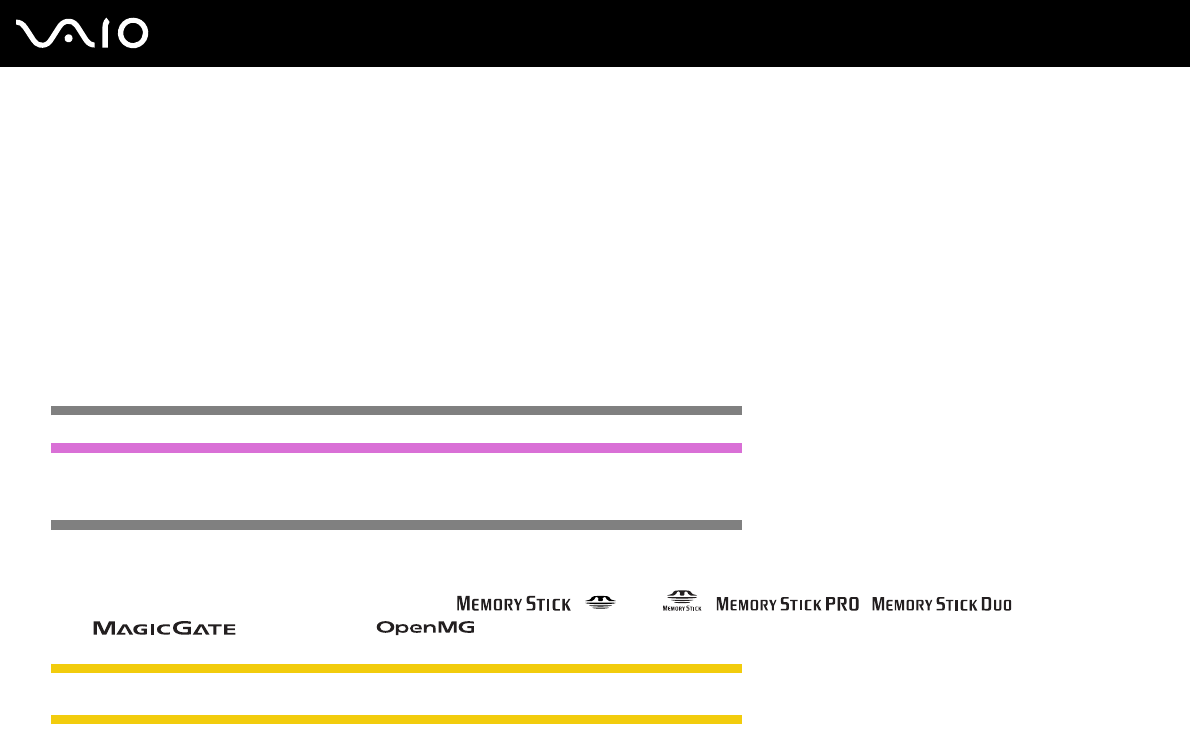
264
nN
Support Options
Can I submit my questions at any time?
Yes, you can submit your questions 24/7, but please keep in mind that our e-Support Team can only treat your queries from
Monday till Friday between 8am and 6pm.
Is there a cost involved for using e-Support?
No, this is a complete free of charge service offered to all registered VAIO customers!
How do I know when the e-Support Team has handled my query/case?
As soon as your case has been dealt with by our e-Support Team, you will receive an email, notifying you that your case has
been updated.
Euro model_END
Except US model_BGN
Trademarks
Euro model_BGN
Sony, Battery Checker, Click to DVD, Click to DVD BD, DVgate Plus, SonicStage CP, SonicStage Mastering Studio,
VAIO Control Center, VAIO Edit Components, VAIO Media, VAIO Power Management, VAIO Power Management Viewer,
My Club VAIO, VAIO Update, "Memory Stick," , and , , , "MagicGate"
and , OpenMG and , VAIO and the VAIO logo are trademarks of Sony Corporation.
IRX-3960_BGN
Intel, Pentium, and Intel SpeedStep are trademarks or registered trademarks of Intel Corporation.
IRX-3960_END
Microsoft Windows Vista, Windows Media Center Edition, MS Works, Microsoft Office 2007 Trial, Microsoft Office Ready
2007 and the Windows logo are trademarks or registered trademarks of Microsoft Corporation in the U.S. and other countries.

265
nN
Support Options
i.LINK is a trademark of Sony used only to designate that a product contains an IEEE 1394 connection.
Adobe, Adobe Acrobat Standard, Adobe Reader, Adobe Premiere Elements, Adobe Premiere Pro and Adobe Photoshop
Elements are trademarks of Adobe Systems Incorporated.
Norton Internet Security 2007 is a trademark or a registered trademark of Symantec Corporation.
Roxio Easy Media Creator is a trademark of Sonic Solutions.
WinDVD for VAIO and WinDVD BD for VAIO are trademarks of InterVideo, Inc.
Sun Java VM is a trademark of Sun Microsystems, Inc.
Google Toolbar, Google Desktop Search, Google Earth and Google Picasa are trademarks of Google.
Skype is a trademark of Skype Limited.
My Club VAIO uses Macromedia Flash™ Player software by Macromedia, Inc., Copyright © 1995-2003 Macromedia, Inc. All
rights reserved. Macromedia and Flash are trademarks of Macromedia, Inc.
IRX-3960_BGN
The Bluetooth word mark and logos are owned by the Bluetooth SIG, Inc., and any use of such marks by Sony Corporation
is under license. Other trademarks and trade names are those of their respective owners.
Design and specifications are subject to change without notice.
The ExpressCard word mark and logos are owned by the PCMCIA and any use of such marks by Sony Corporation is under
license. Other trademarks and trade names are those of their respective owners.
SD Logo is a trademark.
SDHC Logo is a trademark.
MultiMediaCard™ is a trademark of MultiMediaCard Association.
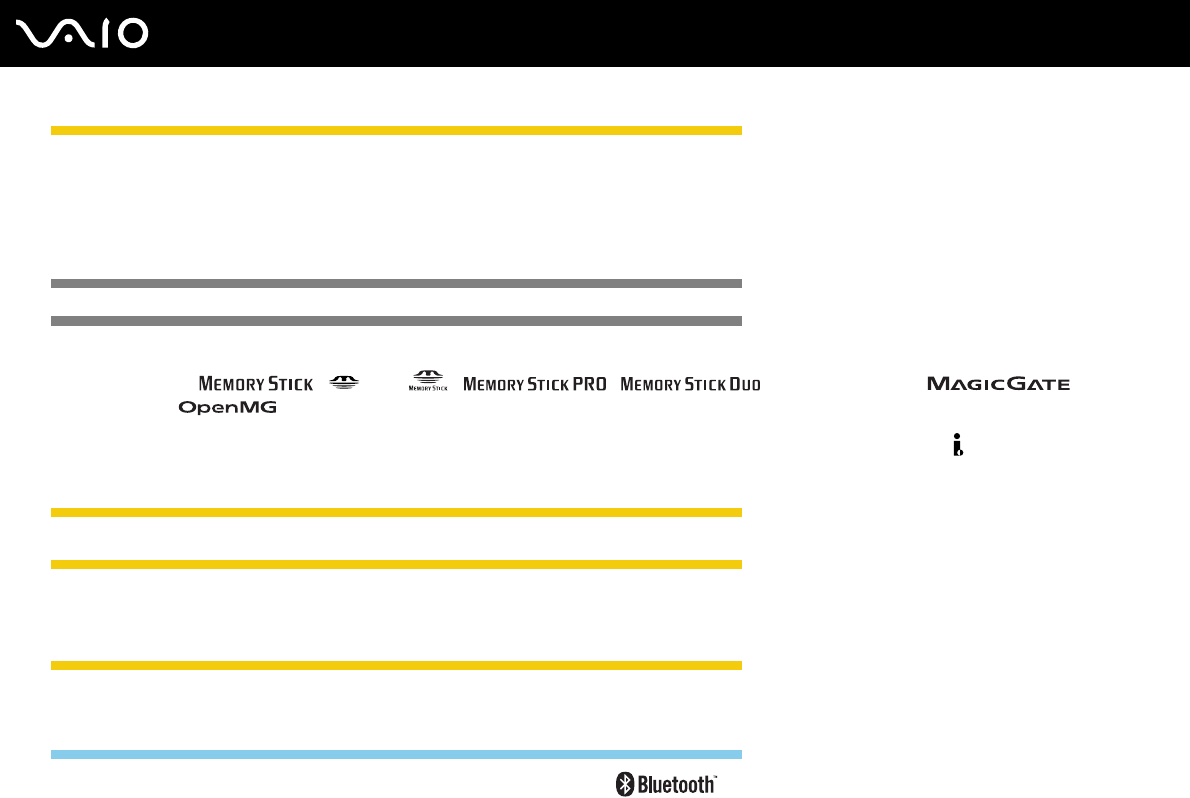
266
nN
Support Options
IRX-3960_END
All other names of systems, products and services are trademarks of their respective owners. In the manual, the ™ or ®
marks are not specified.
Specifications are subject to change without notice. All other trademarks are trademarks of their respective owners.
Please see the online Specifications to see what software is available for your model.
Euro model_END
Except Euro_BGN
VAIO is a trademark of Sony Corporation.
"Memory Stick," , and , , ,"MagicGate" and ,
OpenMG and are trademarks of Sony Corporation.
i.LINK is a designation referring to IEEE 1394-1995 and IEEE 1394a-2000. i.LINK and the i.LINK logo " " are trademarks of
Sony Corporation.
IRX-3960_BGN
Intel, Pentium, and Intel SpeedStep are trademarks or registered trademarks of Intel Corporation.
IRX-3960_END
Microsoft, MS-DOS, Windows, and Windows Vista are either registered trademarks or trademarks of Microsoft Corporation
in the United States and/or other countries.
IRX-3960_BGN
The Bluetooth word mark and logos are owned by the Bluetooth SIG, Inc., and any use of such marks by Sony Corporation
is under license. Other trademarks and trade names are those of their respective owners.
GVD model_BGN
Design and specifications are subject to change without notice.

267
nN
Support Options
GVD model_END
China model_BGN
Design and specifications are subject to change without notice.
China model_END
The ExpressCard word mark and logos are owned by the PCMCIA and any use of such marks by Sony Corporation is under
license. Other trademarks and trade names are those of their respective owners.
SD Logo is a trademark.
SDHC Logo is a trademark.
MultiMediaCard™ is a trademark of MultiMediaCard Association.
IRX-3960_END
All other names of systems, products and services are trademarks of their respective owners. In the manual, the ™ or ®
marks are not specified.
Specifications are subject to change without notice. All other trademarks are trademarks of their respective owners.
Please see the printed Specifications sheet to see what software is available for your model.
Except Euro_END
Except US model_END


